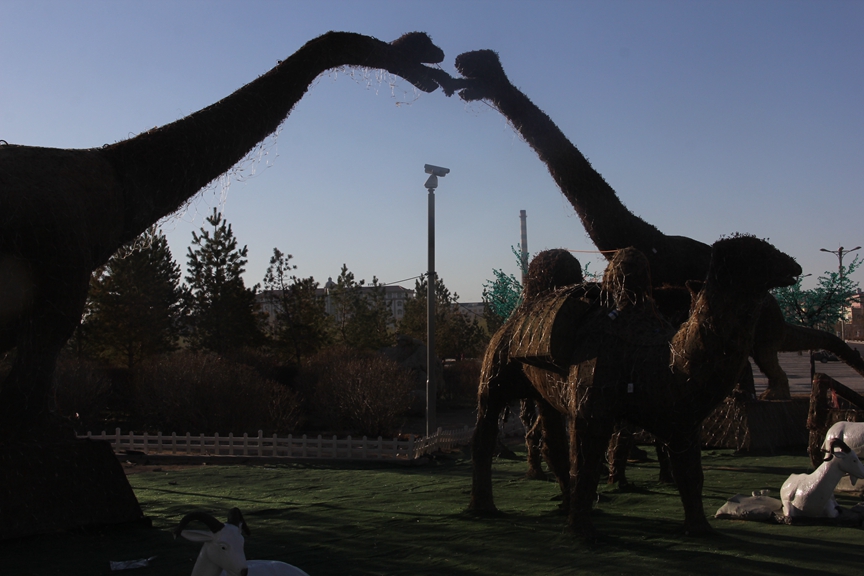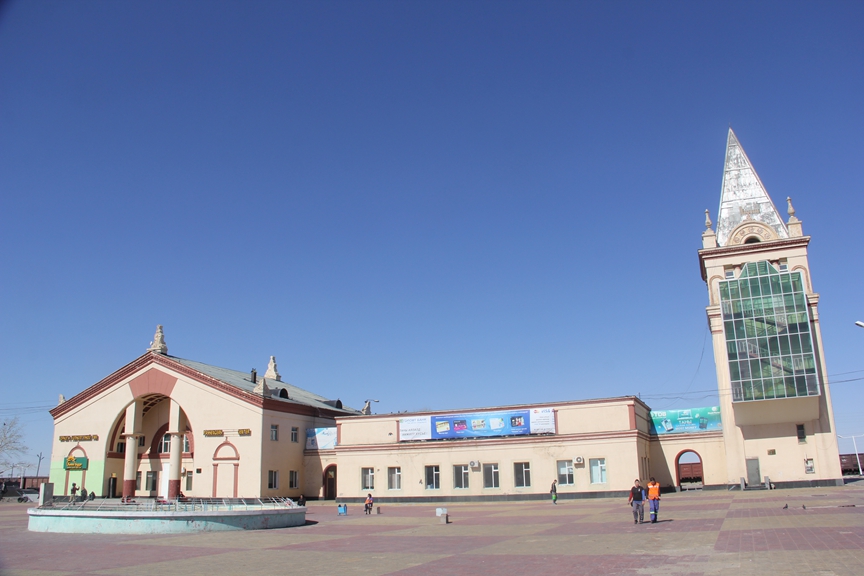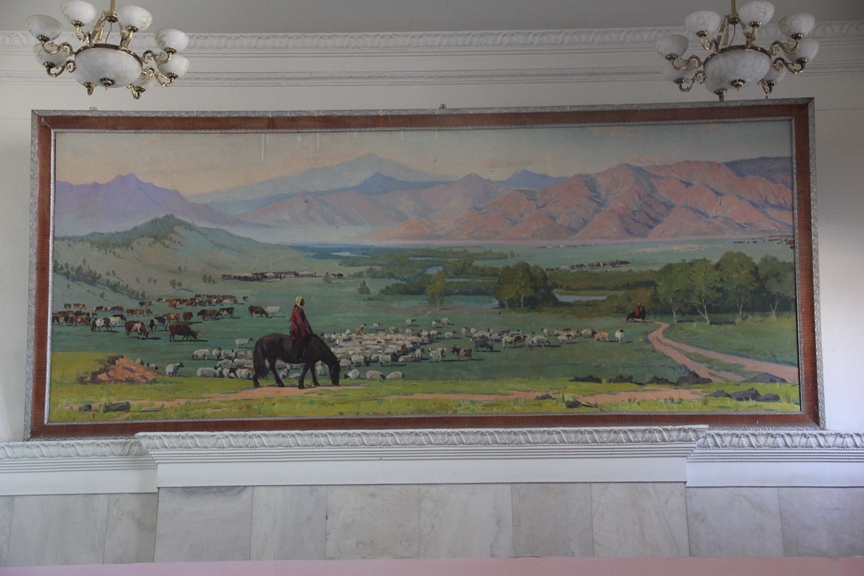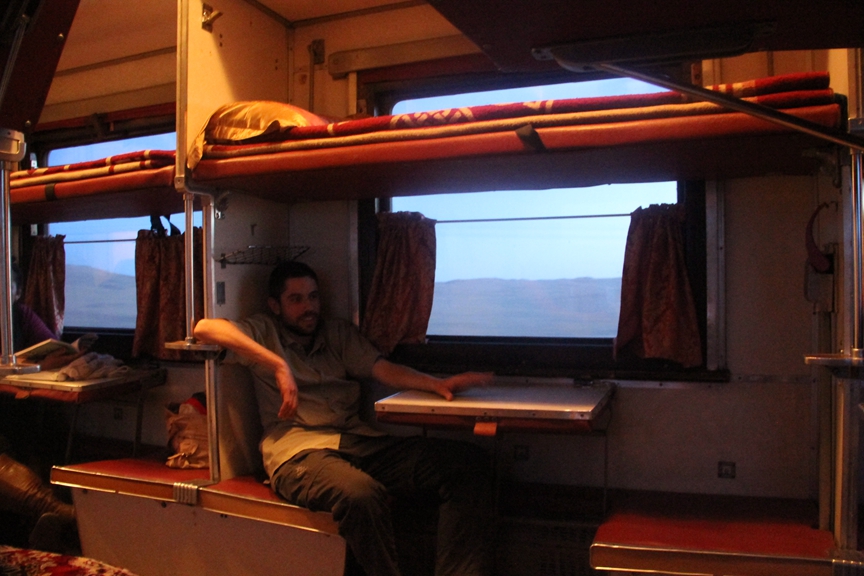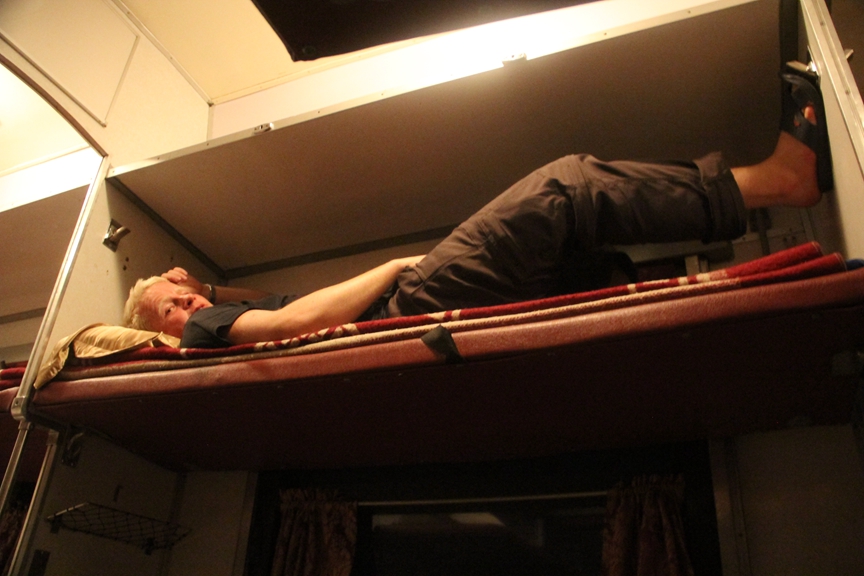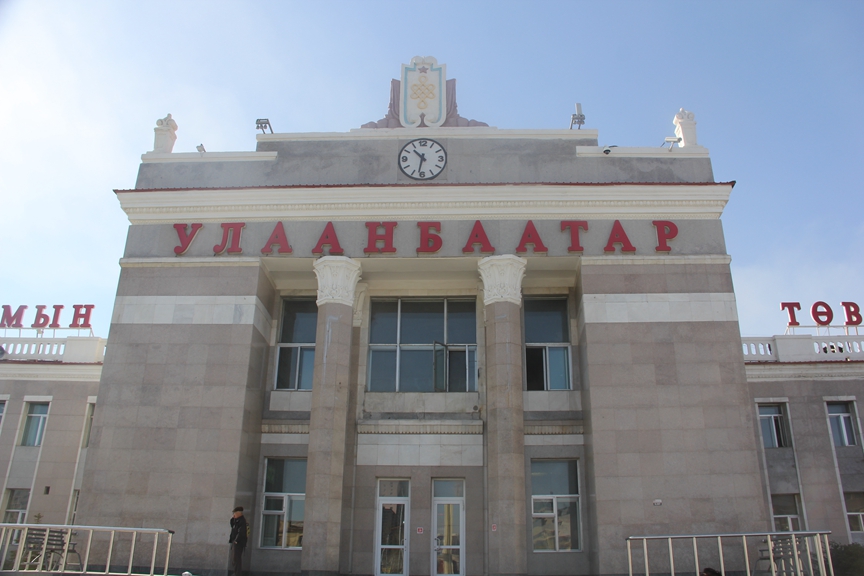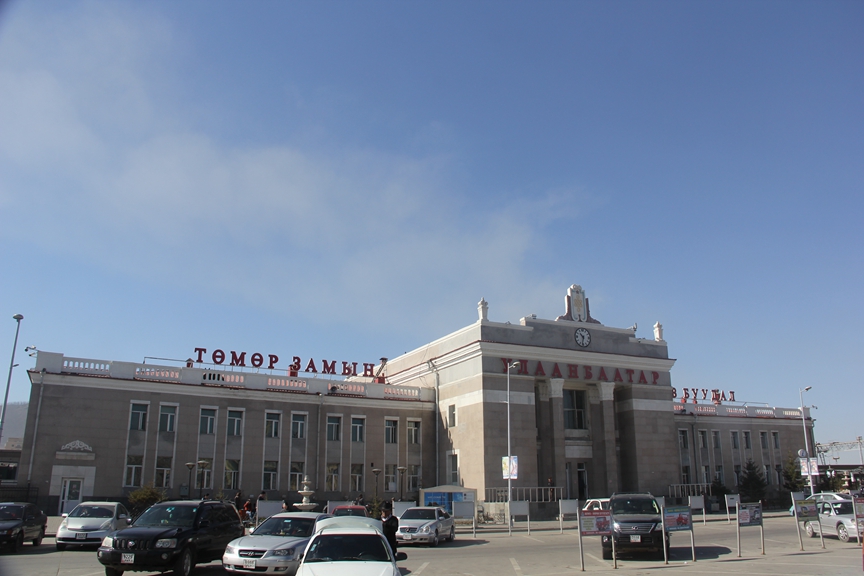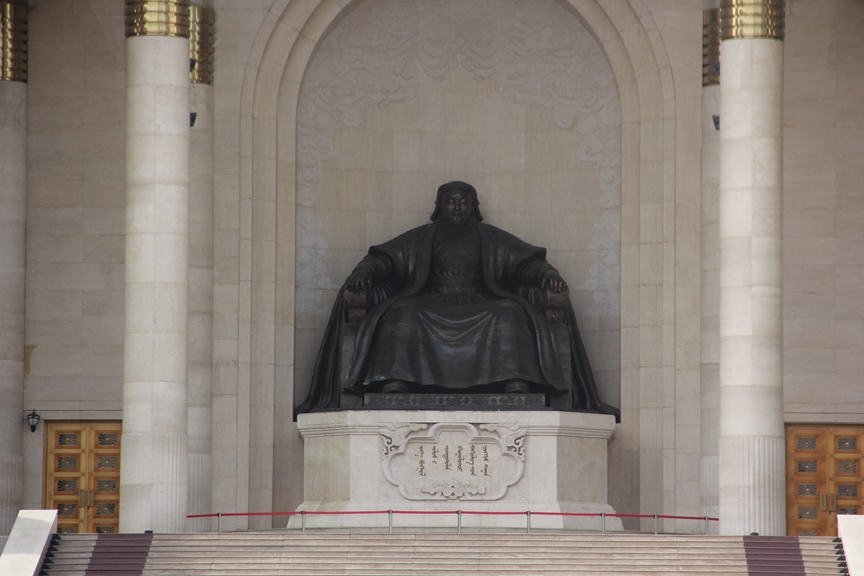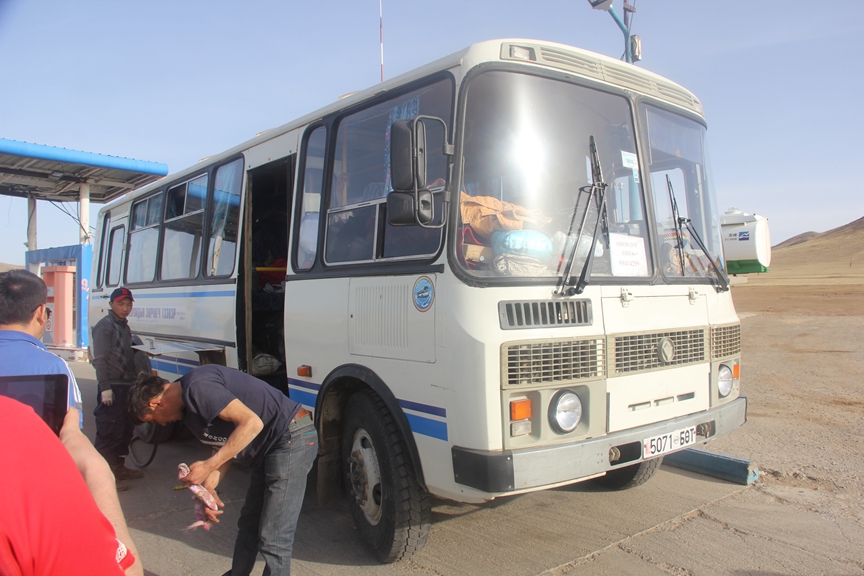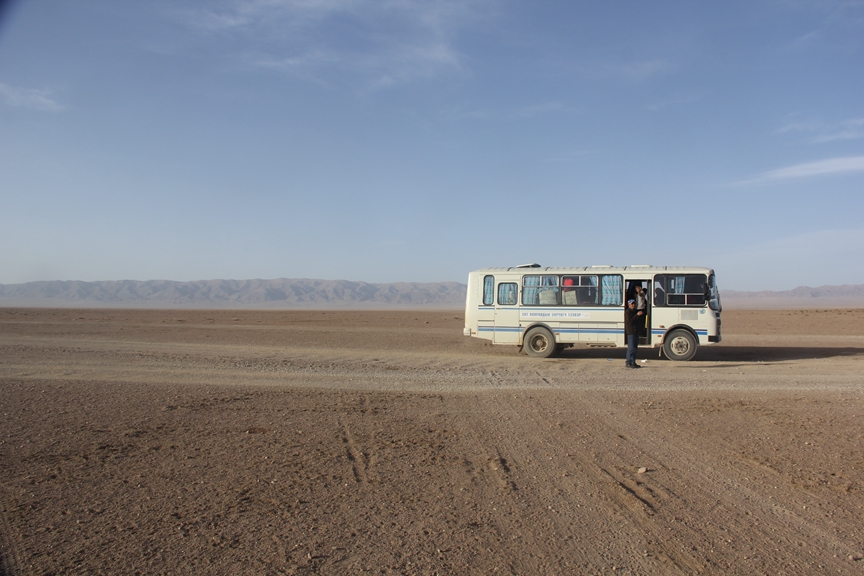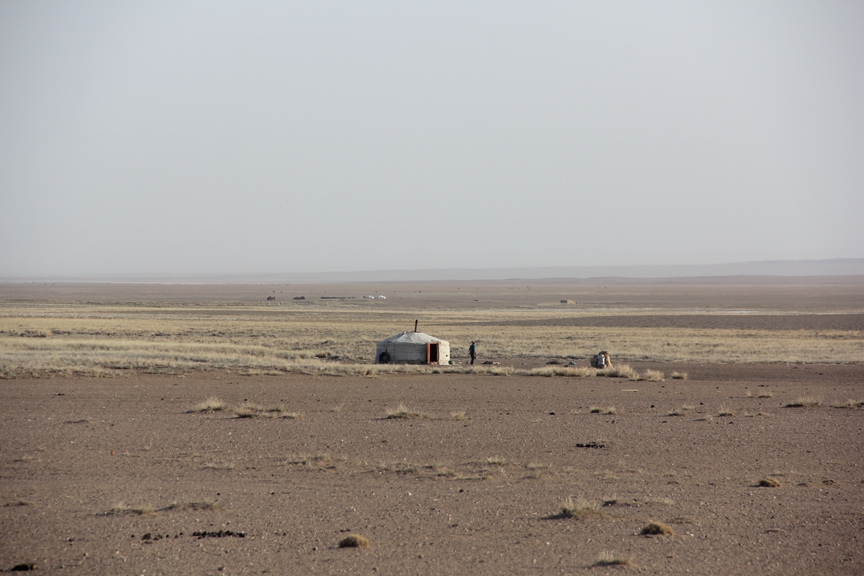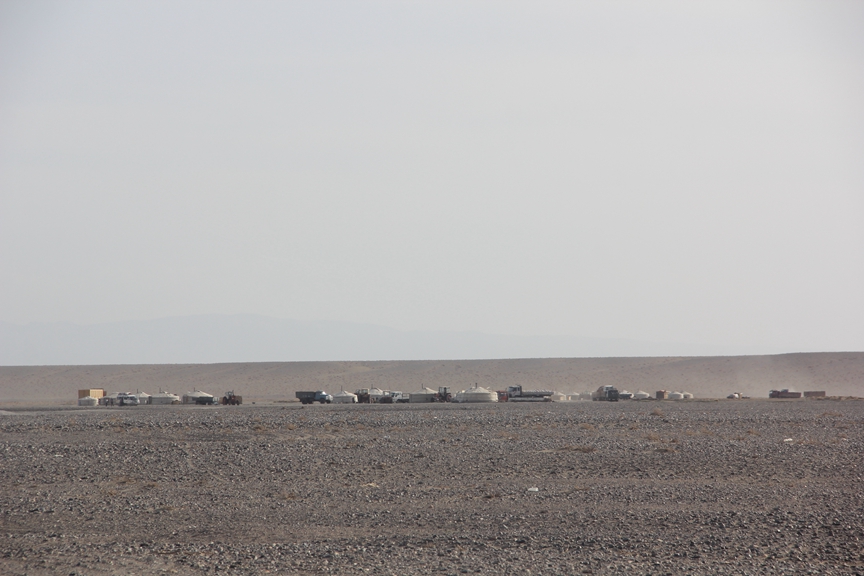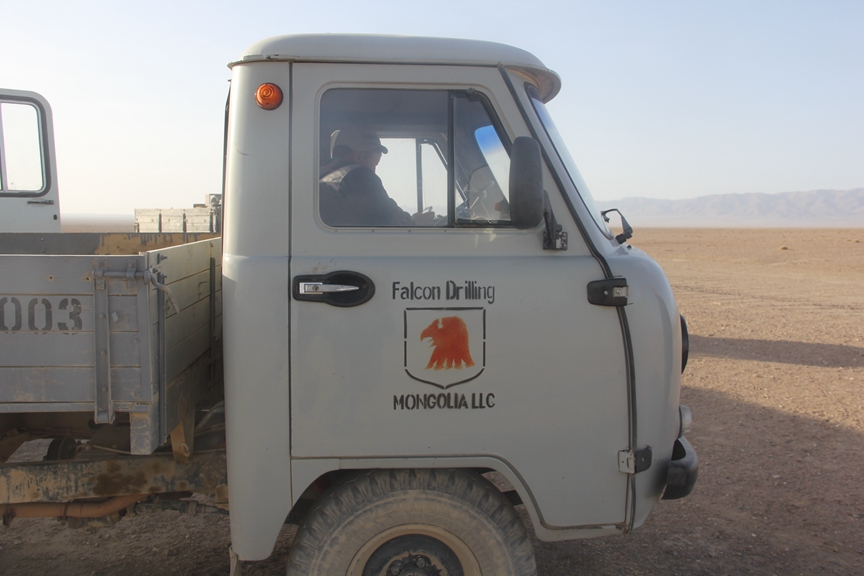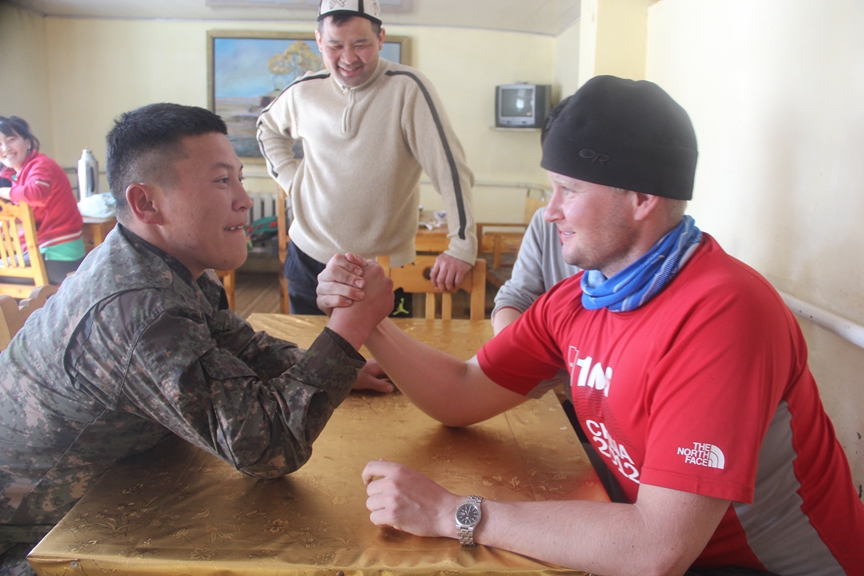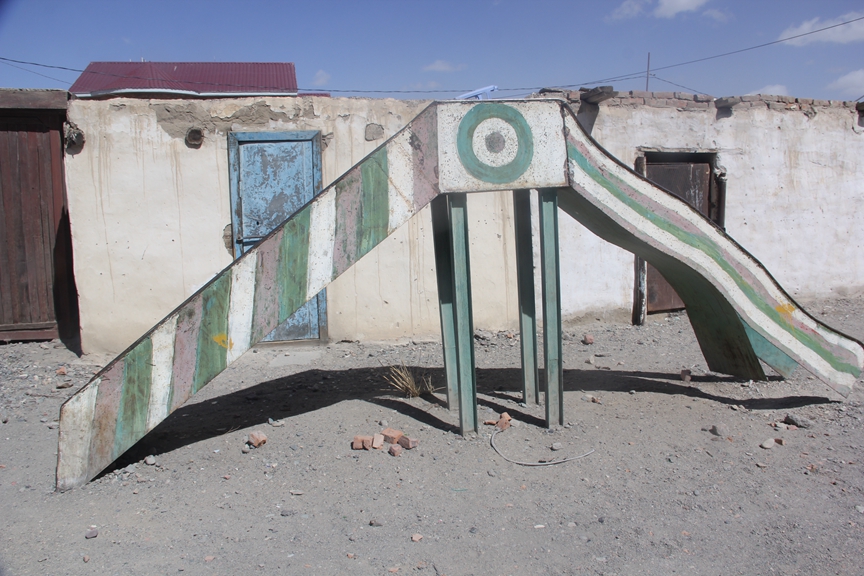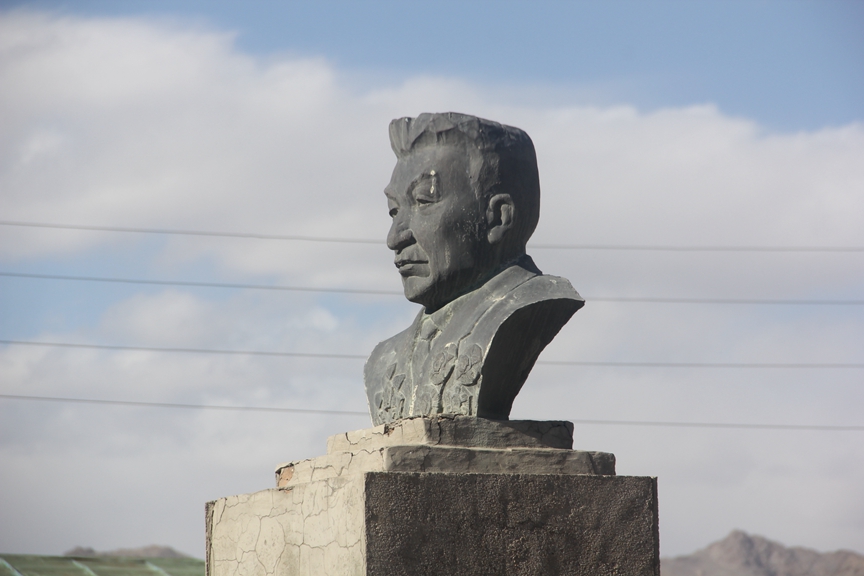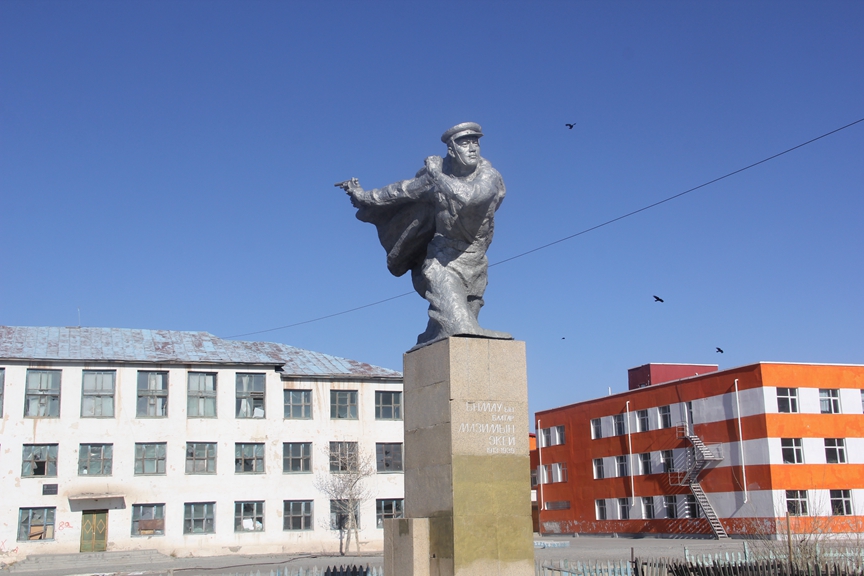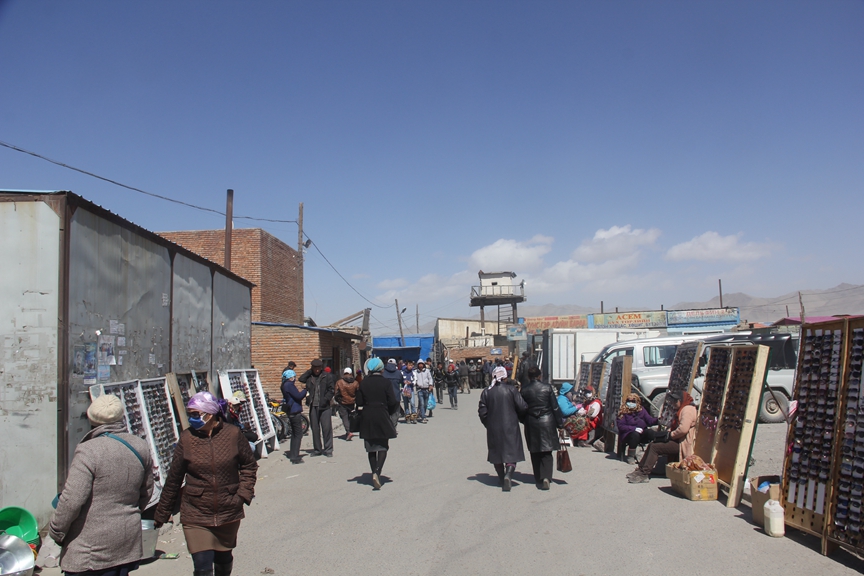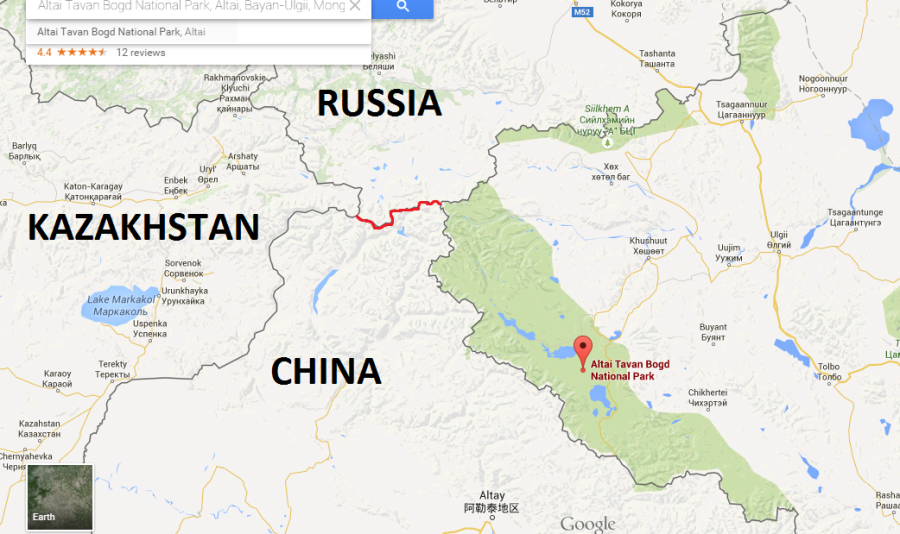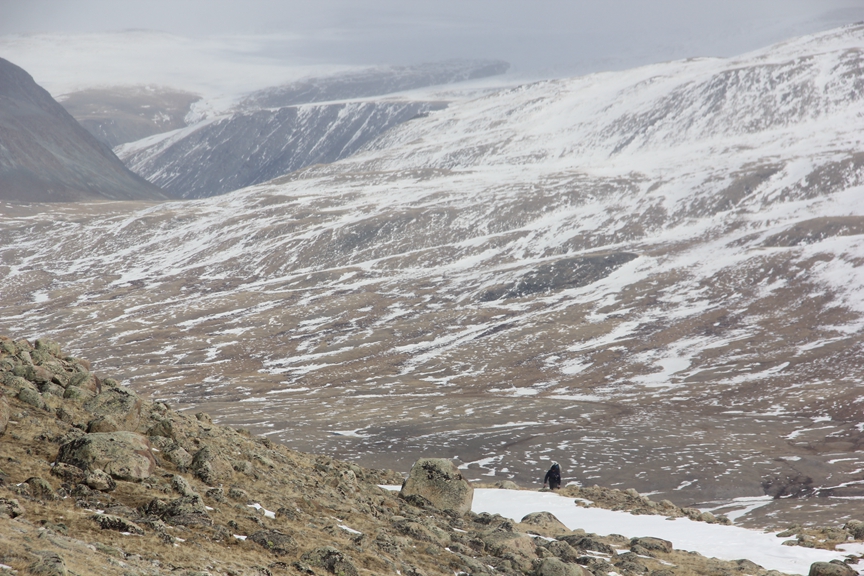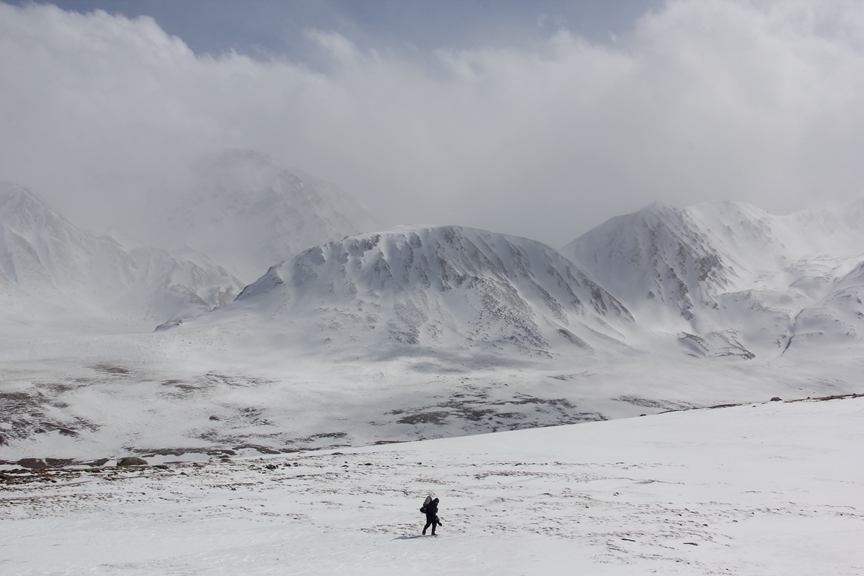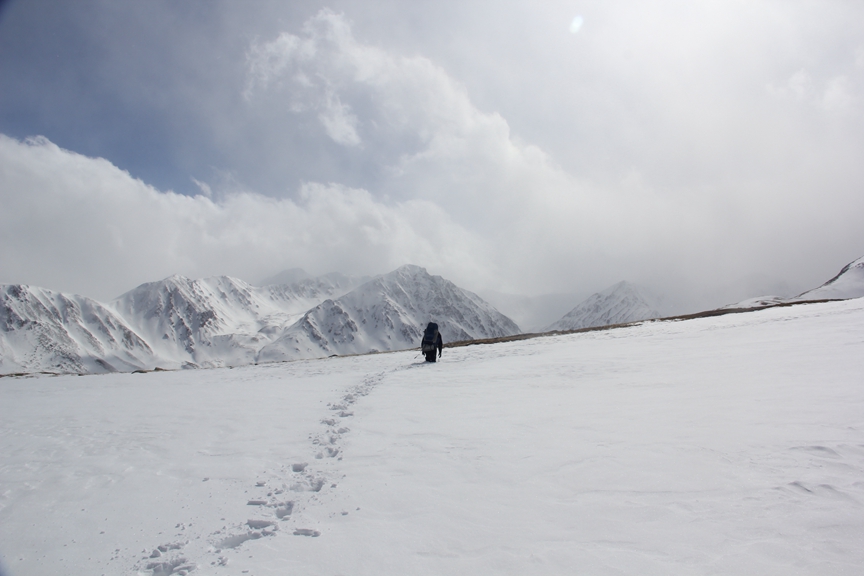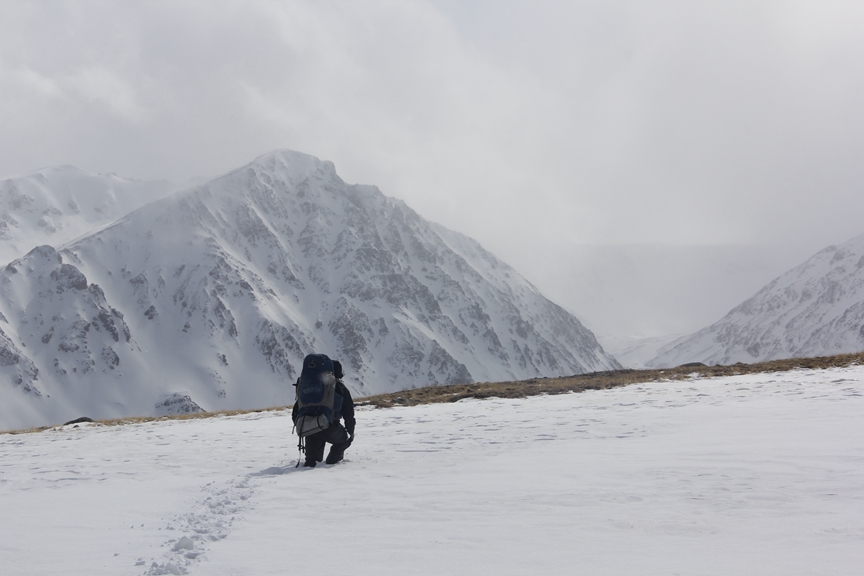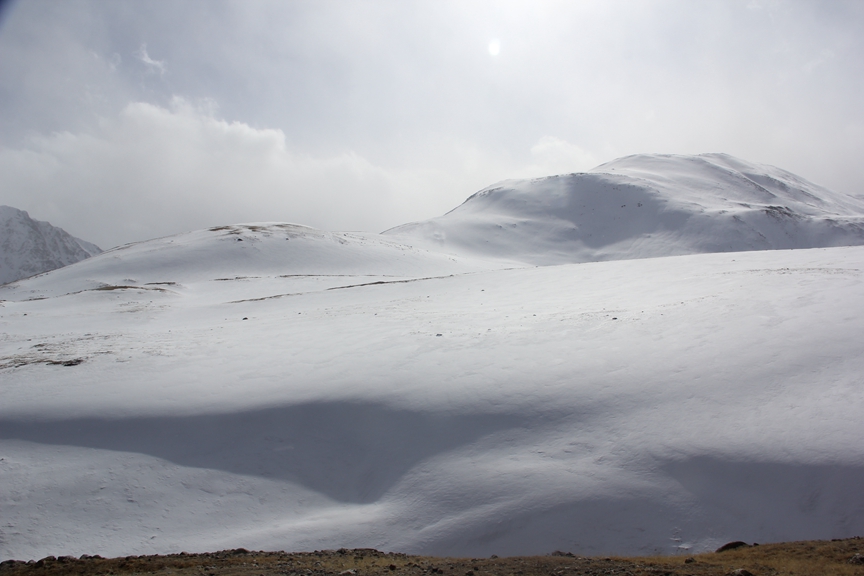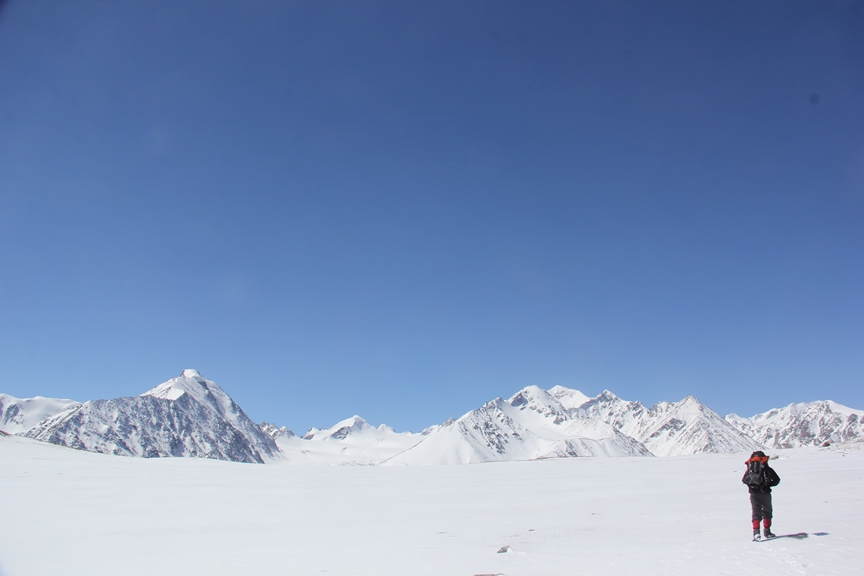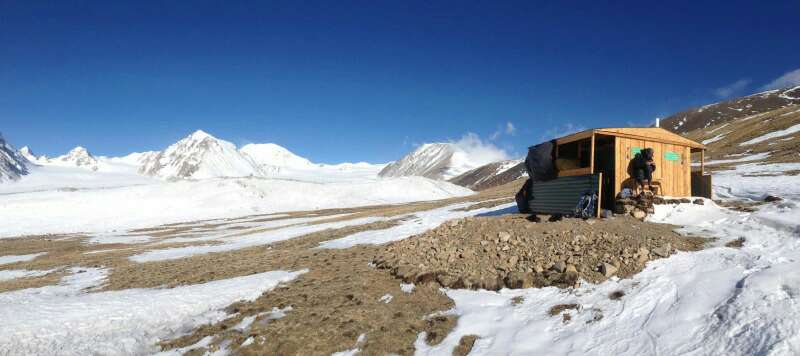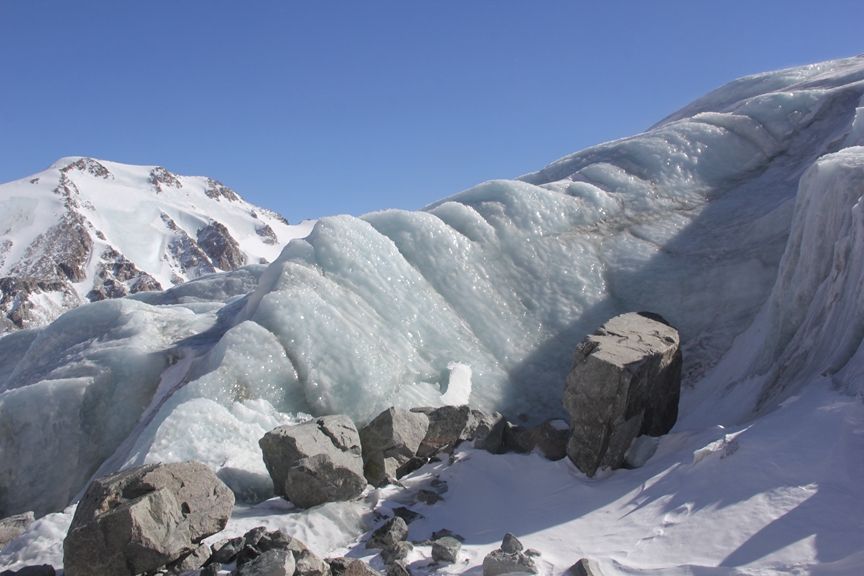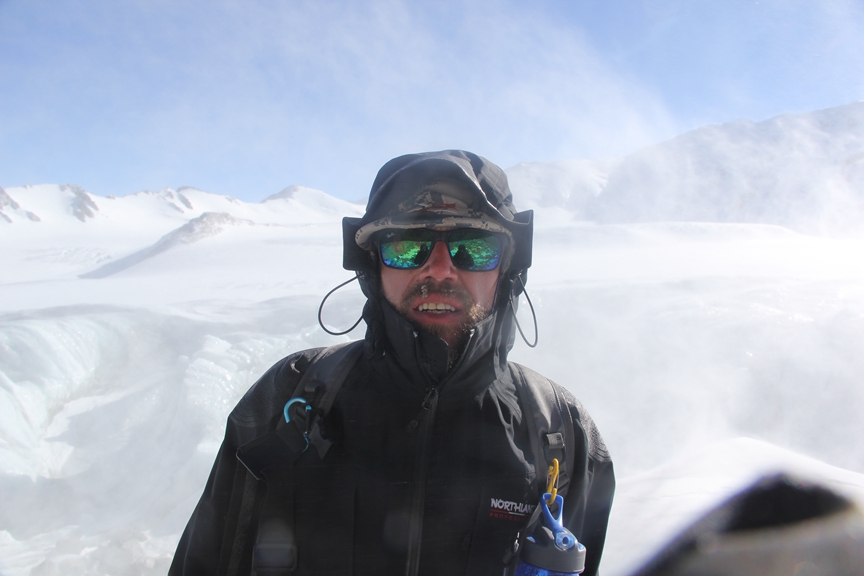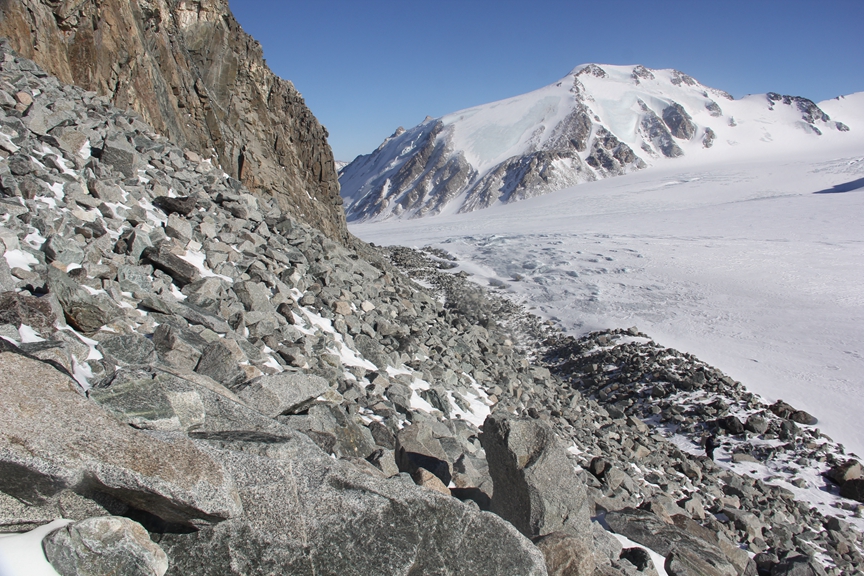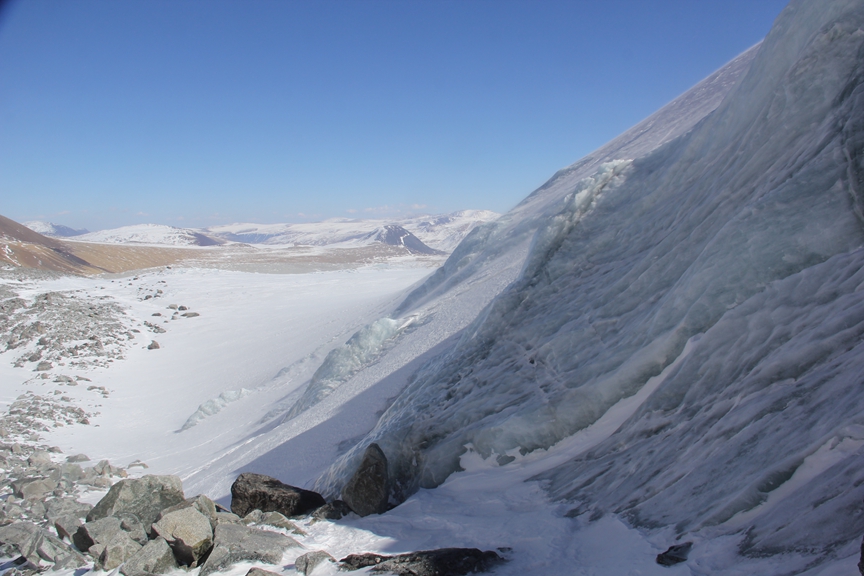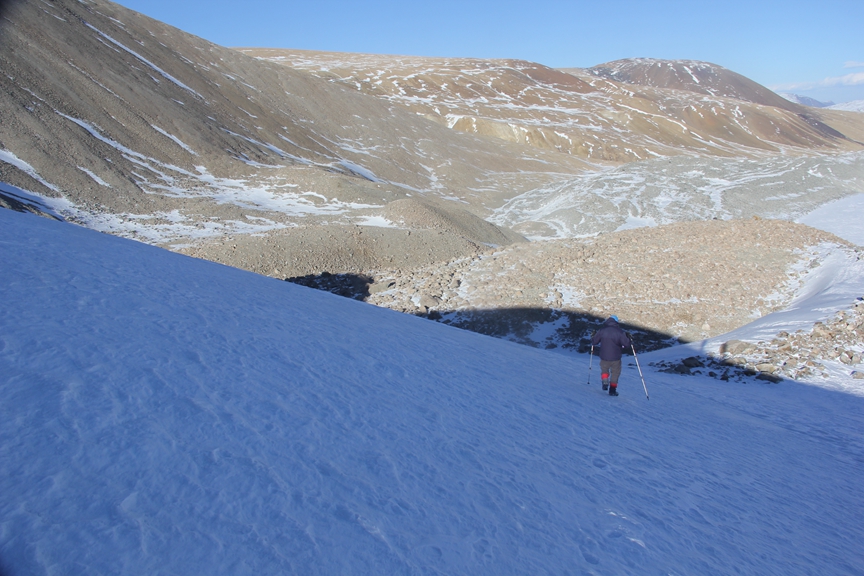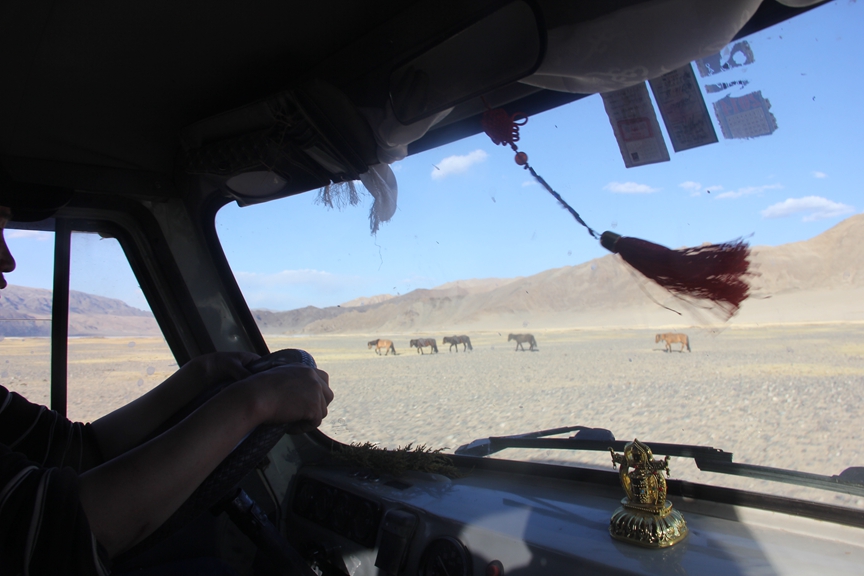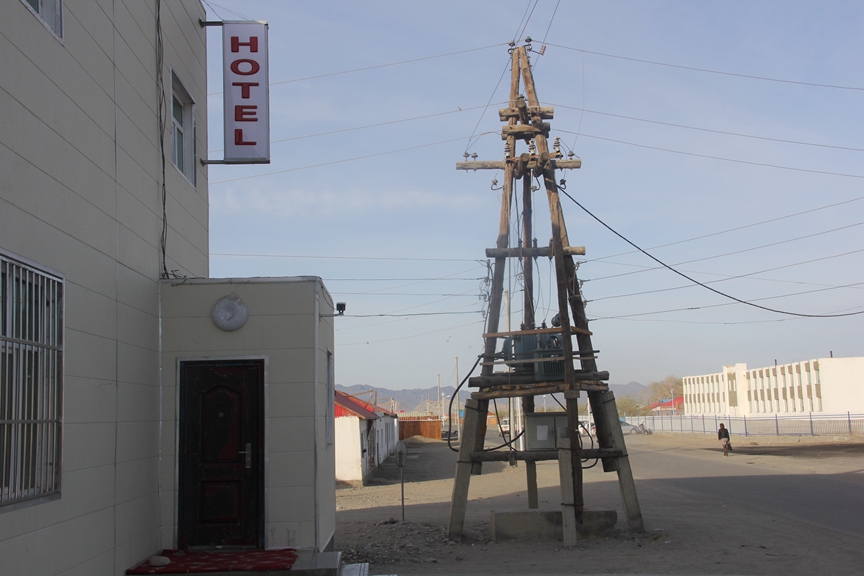“In Xanadu did Kubla Khan
A stately pleasure-dome decree:
Where Alph, the sacred river, ran
Through caverns measureless to man
Down to a sunless sea.”
The opening verse of Samuel Taylor Coleridge’s famous poem “Kubla Khan”, or “A Vision in a dream: A Fragment”, conjures up a romantic image of a mystical and remote land ruled by the decadent and inscrutable Mongolian monarch, Kubla Khan, the grandson of Chinghis Khan and founder of the Yuan Dynasty, which ruled the Chinese imperium from 1271 to 1368. Although based more on fantasy than a realistic depiction of medieval Mongolia, this poem did much to inform and reinforce the popular 19th century Orientalist concept of the “impenetrable East”, and has continued to grip the Western imagination since it was published nearly two centuries ago. Indeed, I was under its spell when I embarked on my first trip to Mongolia in the spring of 2015.
I had lived in China for nearly a decade and been traveling around Asia for nearly a decade and a half before I finally made my first visit to the Republic of Mongolia, but despite being within such close proximity to it for so long, my understanding of this country was admittedly quite limited. I had already visited the Chinese province of Inner Mongolia (official name: “Inner Mongolia Autonomous Region), which shares a several thousand kilometre long border with the Republic of Mongolia (or “Outer Mongolia”, as it was historically referred to and continues to be referred to in China today), but I had the impression that Inner Mongolia shared little in common with its independent neighbor to the north apart from a long contiguous border. Although Inner Mongolia is a nominal “autonomous region” for China’s ethnic Mongol population, it looks and feels very much like neighboring provinces in northern China, which is unsurprising considering that 80% of Inner Mongolia’s population is Han Chinese, the numerically and politically dominant ethnic group in China (i.e. the one that comes to mind when one refers to someone as “Chinese”).
I had been meaning to visit Outer Mongolia for ages to see for myself just how different it is from Inner Mongolia but never really prioritized it on my list of desired travel destinations. I had actually proposed a trip to Mongolia to a fellow Canadian friend in Beijing soon after I discovered that Canadians didn’t need a tourist visa to visit for up to 30 days, but when he declined to join me, I simply put the idea on the back burner, where it simmered for about a year and a half until an Australian friend in Beijing called me out of the blue one day to say that his Chinese visa was about to expire. He needed to go on a visa run to a neighboring country, so was wondering if I had any suggestions where to go and if I wanted to join him and make a fun trip out of it. This seemed like the perfect opportunity to put my latent Mongolia trip idea into action, so I pitched it to him, and although he initially said that Mongolia wasn’t quite what he had in mind, I managed to convince him that it would be an interesting and worthwhile place to visit. In fact, we had already visited Inner Mongolia together, so I said that this would be a great opportunity to investigate for ourselves just how different Outer and Inner Mongolia were supposed to be from each other. Other selling points that helped convince him are the fact that it’s easy and inexpensive to travel to Mongolia from Beijing, as well as being a relatively inexpensive country to travel in itself. However, most important was the attraction and mystique of visiting a sparsely populated country renowned for its rugged natural beauty, vast empty expanses of desert, steppe, forest and mountainous terrain, and for being the homeland of the world’s last major nomadic society, all right on China’s doorstep! With these points making up the bulk of my pitch, he was sold on the plan within minutes and within a week we were on our way.
Our planning and preparation for the trip was quite rushed, which made it that much more exciting, but also a bit disorganized, as one could imagine. For starters, as an Australian national, my friend would still need to obtain a tourist visa, which I found somewhat surprising since Canadians don’t. At the time, I assumed this was because Canadian mining firms are such big players in Mongolia’s booming mining industry, but later I found out that Mongolia’s largest mining project, which is expected to account for fully one-third of Mongolia’s GDP by 2018, was developed by Anglo-Australian mining giant Rio Tinto, so it seems strange that Canadians enjoy visa free status, while Australians, whom I’ve long affectionately referred to as “Canadians down under”, are relegated to the ignoble and inconvenient position of having to apply for a visa. I can only assume this is because Australia, with its increasingly strict immigration policies, makes it harder for Mongolians to visit and/or immigrate than Canada does, so Mongolia is simply reciprocating in the typical tit-for-tat way that governs the world of diplomatic relations.
The plan was for my Australian friend to go to the Mongolian embassy in Beijing and apply for an express visa, which I had read only takes one day, but when he got there he was told that the service had been discontinued! This left us temporarily panic-stricken, since he had to exit China in 4 days, but luckily he also happened to have a Finnish passport by birthright (lucky bastard has never even been to Finland!), and Finns don’t need a visa for Mongolia, so his backup plan was to exit China on his Australian passport, which he needed to do since it contained his Chinese visa, but then produce his Finnish passport at Mongolian customs and try his luck. The reason we both still thought an element of luck would be needed to pull this off was because despite the fact that Finnish passport holders don’t need a tourist visa to enter Mongolia, his Finnish passport was still a virgin (i.e. it had NEVER been used). There wasn’t a single entry or exit stamp from any country to be found on any of its crisp, white pages. We didn’t bother inquiring with the Mongolian embassy or relevant Chinese authorities if this scheme would work, and indeed thought that it would be prudent not to; instead, we both agreed to just go the border and give it a shot, despite the nagging worry that he might be turned back by Mongolian Customs, and maybe even by Chinese customs when attempting to exit China. The reason we worried about the latter possibility is because we thought the Chinese customs agent stamping him out of China might notice that he didn’t have a Mongolian visa in his Australian passport and he didn’t want Chinese customs to know that he was planning to attempt to enter Mongolia on his Finnish passport, as we feared this may raise suspicions somehow. We imagined the Chinese customs agent responding something like this: “Why are you travelling with two passports?” “You want to do WHAT?” “Exit China on one passport and enter Mongolia on another?” “BU XING!” (Chinese for ‘NOT OKAY!’). Although my numerous experiences crossing Chinese borders have been pleasant and smooth (except for one time when I was detained and questioned by Chinese customs when trying to enter China from Kyrgyzstan), I can never help feeling a little nervous each and every time I approach a customs agent from any country, even my own. There’s something about the authority they wield that makes me feel like I’ve committed an unknown offense and will not be permitted to pass unmolested.
The second and equally important problem we had to solve was how to transport ourselves to the Mongolian border on such short notice. We were planning to take the train or bus, or even fly if necessary, but still hadn’t made arrangements with less than 4 days to go. I guess we just kind of took it for granted that there would be lots of trains and buses going to the border, but when we tried to book train tickets we discovered to our dismay that the train was sold out for the day we wanted to travel, which was the day before my friend’s Chinese visa expired; not only that, the train to the Mongolian border only runs once every 3 days, so we didn’t have the option of trying to take it a day earlier. That left the bus or plane, neither of which we were too keen on, but we opted for the bus in the end since it was about a third the price of flying and there were actually 3 buses leaving for the border on the day we wanted to travel. We actually didn’t confirm this until the day before we intended to travel, which wasn’t very smart, and didn’t actually end up purchasing our tickets until 30 minutes before the bus was scheduled to depart, but thankfully we didn’t have any trouble getting them; amazingly there wasn’t even a queue at the bus station, which is rare in Beijing. Feeling relieved and almost smug about our luck getting tickets, we walked to where we thought the bus was supposed to depart but as soon as we handed over our tickets to a man who claimed to be the driver, he told us to follow him and lead us out of the bus station and into a grimy alley instead. Without trying to mask our feelings of suspicion and disapproval, we asked in an obviously annoyed tone if he was taking us to the right bus. He assured us that he was, so we continued to follow him down the alley, which was extremely filthy (even by Beijing standards) until we arrived at a large demolition sight a few minutes later. Two sleeper buses were parked there surrounded by rubble. It was almost 3 pm when we arrived, which is when the bus was scheduled to depart, but as soon as we put our bags under the bus and tried to board, the driver said the bus wouldn’t leave until sometime between 5 and 6 because the buses had to wait for a group of Mongolian traders who wouldn’t be arriving with their cargo until then. I’ve grown accustomed to China’s generally punctual and efficient long distance transport system (air travel being an exception), so I was quite shocked to hear about the delay, especially since the driver had mentioned it so nonchalantly, as if it was to be expected. Slightly annoyed, we next asked him what time the bus would arrive at the border and he told us 6am. This was equally shocking since the sales clerk at the bus station told us it would only take 9 hours but by the driver’s estimation it would take between 12 and 13 hours, depending on when we eventually departed. If that wasn’t bad enough, to add insult to injury, we didn’t finally hit the road until 8pm, 5 hours late!
Erenhot
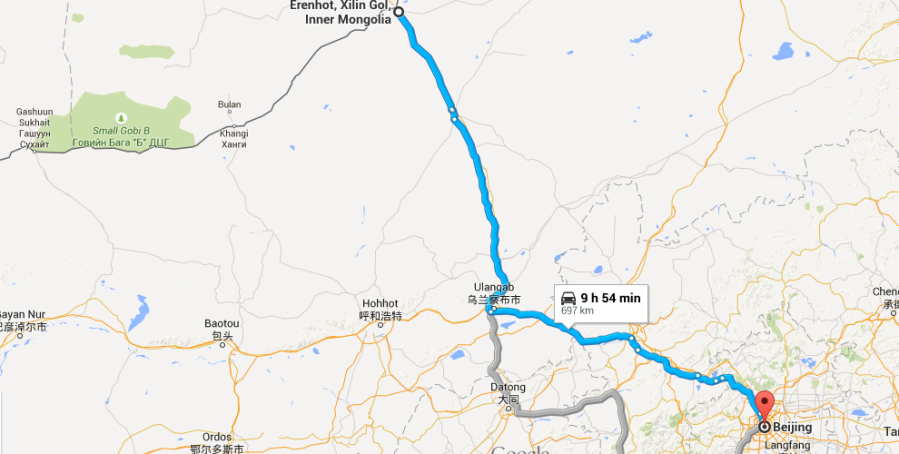 Route from Beijing to Erenhot.
Route from Beijing to Erenhot.
We arrived in the Chinese border town of Erenhot (Ch. “Erlian Haote”) just after sunrise the next morning and immediately took a taxi from the bus station to a large bazaar style market a few kilometers away where Mongolian jeeps congregate to transport travelers across the border. Apparently, pedestrians are not allowed to walk across the border, so we each paid 80 RMB ($13 USD) for seats in a private jeep to ferry us across.
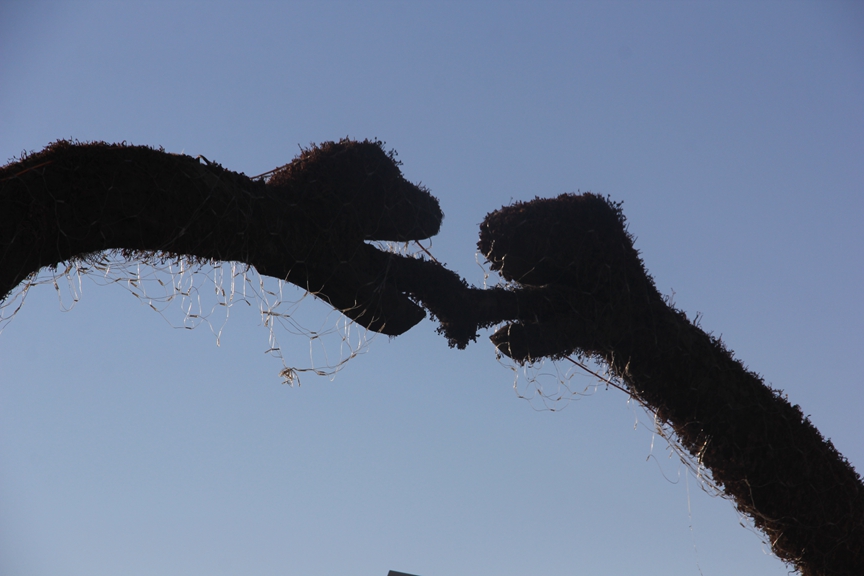 Smack in the middle of the Gobi desert, which is famous for its dinosaur fossils, the Chinese border town of Erenhot has a “Dinosaur Park” across the street from where Mongolian jeeps congregate to transport travelers across the border. At the entrance to the “Dinosaur Park” is a bizarre statue of what looks like two brontosauruses tongue-kissing. Pretty weird.
Smack in the middle of the Gobi desert, which is famous for its dinosaur fossils, the Chinese border town of Erenhot has a “Dinosaur Park” across the street from where Mongolian jeeps congregate to transport travelers across the border. At the entrance to the “Dinosaur Park” is a bizarre statue of what looks like two brontosauruses tongue-kissing. Pretty weird.
Fortunately, we didn’t have to wait around for hours for our jeep to leave, which I read was a possibility. Instead, we left almost as soon as we got in and arrived at the official border crossing in less than 10 minutes.
 A large rainbow arch covers the parking lot in front of the Chinese Customs and Immigration building. It’s nice to see China embracing gay pride with such gusto.
A large rainbow arch covers the parking lot in front of the Chinese Customs and Immigration building. It’s nice to see China embracing gay pride with such gusto.
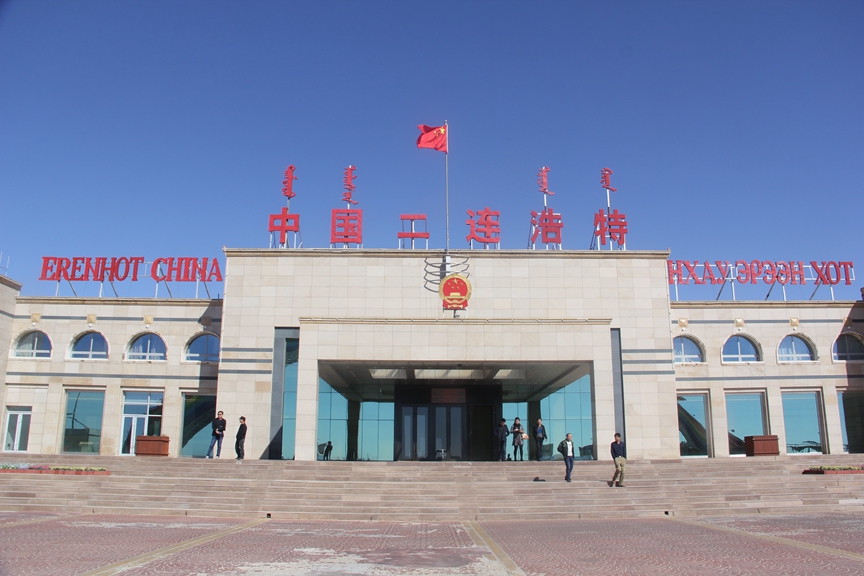 Chinese Customs and Immigration building.
Chinese Customs and Immigration building.
Our driver dropped us in front of the Chinese Customs and Immigration building and said he would pick us up on the other side of it once we had cleared Chinese Customs. Somewhat surprisingly, especially for China, the building was empty; there wasn’t a single person in front of us, so we didn’t have to wait in line, which was a first for me in China! As we approached the Chinese Customs agent though, I noticed that Dion had both his Australian and Finnish passports in hand, so I quickly stopped him and told him to put the Finnish passport away. He was planning to show both passports to the Chinese Customs agent but I told him it probably wouldn’t be a good idea, as it would only complicate matters unnecessarily, so he only presented his Australian passport. The agent noted that his Chinese visa was due to expire at the end of the day but fortunately didn’t notice (or care) that he didn’t have a Mongolian visa, although perhaps he didn’t even know that Australians need a visa to enter Mongolia. Within a mere few minutes of entering the Customs and Immigration building on the Chinese side of the border, we were stamped out of China and standing in no man’s land, where we waited for about 10 minutes until our jeep arrived to ferry us across no man’s land to the Mongolian Customs and Immigration building less than a kilometre away.
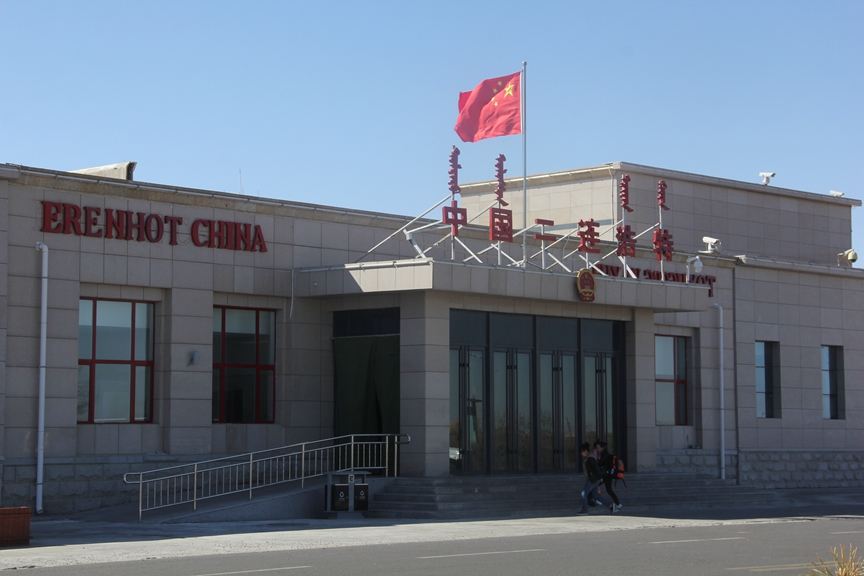 Chinese Customs and Immigration building facing the Mongolian side of the border. When I took this photo we had already been stamped out of China and exited this building, which means we were technically standing in no man’s land.
Chinese Customs and Immigration building facing the Mongolian side of the border. When I took this photo we had already been stamped out of China and exited this building, which means we were technically standing in no man’s land.
The process of exiting China had gone very smoothly, so we were in high spirits when we entered the Mongolian Customs and Immigration building but also a bit nervous as this was the “moment of truth” so to speak, the moment we would find out if Dion would be able to enter Mongolia on his virgin Finnish passport. Funnily enough, when we were both standing in front of separate Mongolian Customs agents, his agent asked mine if Finnish nationals needed a visa, which was quite surprising. Throughout my travels, I’ve always taken it for granted that Customs agents know which nationalities require visas to enter their respective countries, but apparently Mongolia is different in that regard (or perhaps that particular agent was still in training, I don’t know). Fortunately, she didn’t seem to notice (or care) that the passport in front of her was as blank as an empty whiteboard, and stamped him in without any questions. The moment she did, both our faces lit up like a Christmas tree. The gamble had paid off!
Zamiin Uud
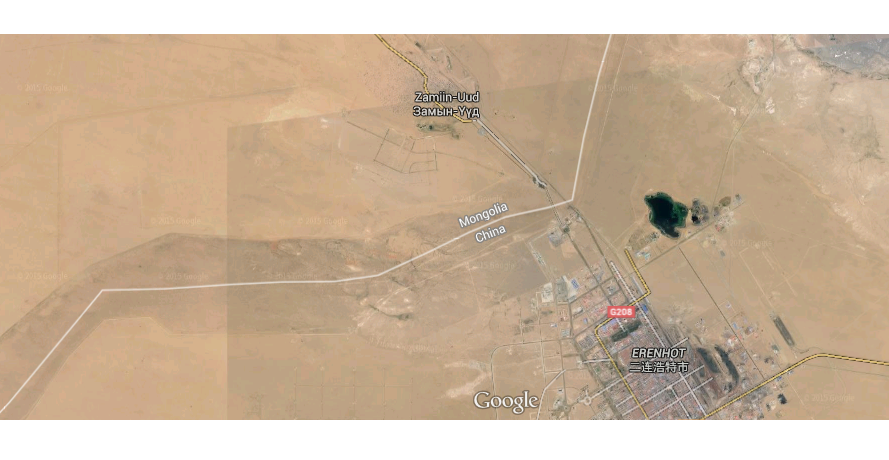 Satellite image showing Erenhot (bottom) and Zamiin Uud (top) with the border running between them.
Satellite image showing Erenhot (bottom) and Zamiin Uud (top) with the border running between them.
A few minutes later we were back in our jeep and on our way to the Mongolian border town of Zamin Uud, which was only a few kilometers from the border crossing. Our driver dropped us off at the train station, where we hoped to buy tickets for a train leaving for Ulaan Baatar that day, but first we needed to find a place to exchange money. After wandering around the entrance to the train station for a few minutes, we found such a place and each bought a few hundred dollars worth of Tugrik, the Mongolian currency. From there we made our way to train ticket sales counter, which was a bit of a challenge to locate. Once we finally found it, we had an even more difficult time finding someone to sell us tickets. The sales counter was devoid of staff so I decided to walk around the building and knock on doors at random hoping to find someone who could help us. This proved futile since I couldn’t find anyone who spoke English but within 30 minutes or so, a sales clerk finally arrived at the ticket counter and sold us two hard sleeper tickets for Ulaan Baater leaving at 7 that evening. By that time it was about 11am, so we decided to find a place to eat nearby.
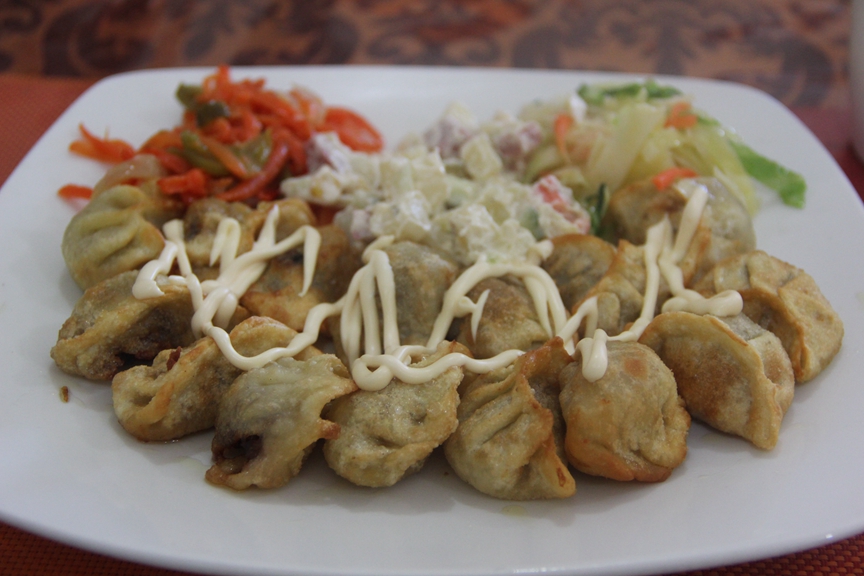 My first meal in Mongolia. A plate of deep-fried dumplings smothered in mayonnaise with a side of Russian style potato salad and pickled vegetables. Cheap and delicious!
My first meal in Mongolia. A plate of deep-fried dumplings smothered in mayonnaise with a side of Russian style potato salad and pickled vegetables. Cheap and delicious!
After lunch we decided to go to a grocery store next to the train station to buy some beer and snacks, then find some place nice to sit outside and enjoy them.
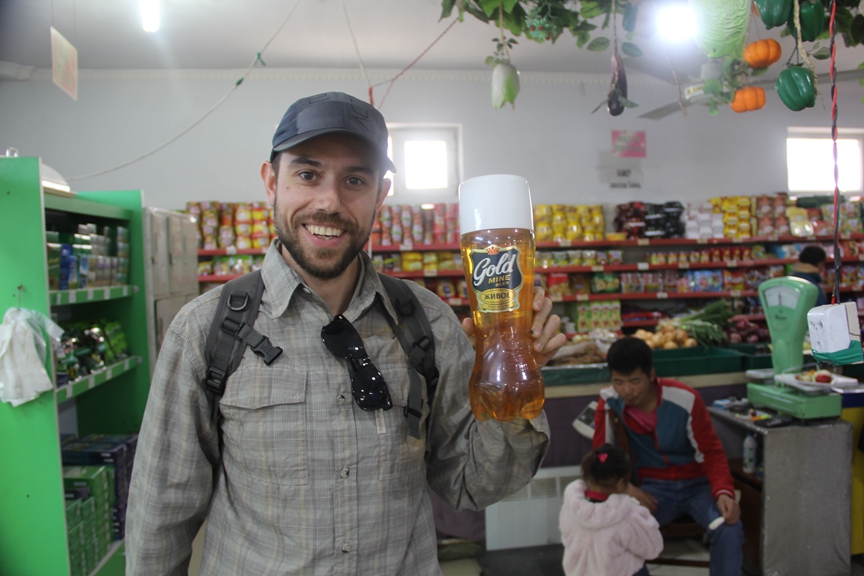 Myself with a large plastic container of “Gold Mine” brand Mongolian beer.
Myself with a large plastic container of “Gold Mine” brand Mongolian beer.
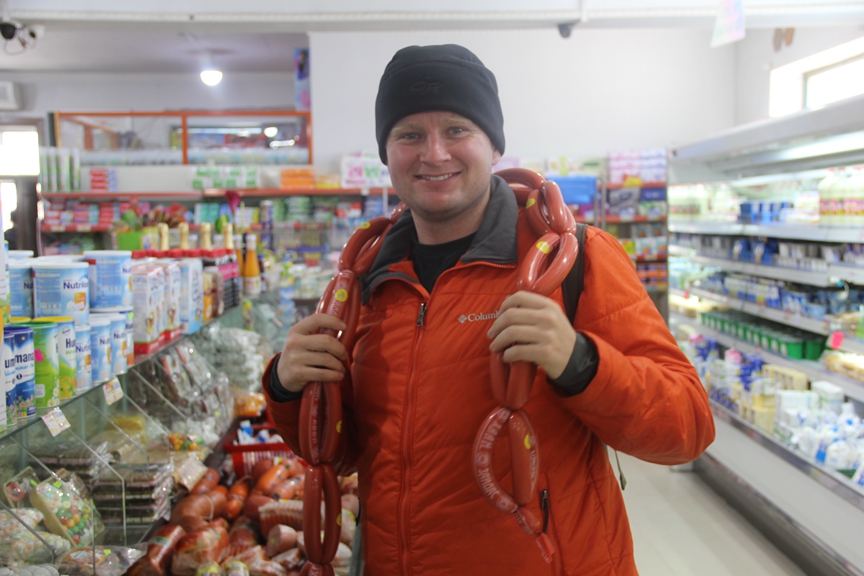 Dion with a tasty chain of link sausage.
Dion with a tasty chain of link sausage.
With beer, sausages, and a jar of pickles in hand, we walked to a nearby park and sat down on a bench. Since we had about 8 hours to kill before our train was due to depart, we intended to while away the afternoon drinking beer and snacking in the park, as it was a beautiful sunny day. Before we had each finished our first beer though, a group of about half a dozen young Mongolian men suddenly approached us in a somewhat menacing manner and began pointing at our beer and shouting, “NO!”. In an angry tone, one of them told us in broken English that we weren’t allowed to be drinking in the park and then pointed to a group of kids playing soccer on an astroturf field nearby to emphasize his point. Ironically, he appeared to be rather intoxicated himself, although he wasn’t holding an open container of alcohol. We didn’t quite understand why he was so bent out of shape to see us with a couple of open beers in a park, even with kids nearby, but deemed it wise not to try to argue with him and his intimidating assemblage of peers, so we quickly gathered our things and walked back to the train station.
We stopped at the same grocery store outside the train station to get some more beer but instead of both going in, I decided to sit out front and finish my beer, while Dion bought a few more for the two of us. Soon after I sat down, a somewhat haggard middle-aged man suddenly stumbled up to where I was sitting and sat down right next to me. Clearly inebriated, he began staring longingly at my open can of beer. After about half a minute, he pointed at it and gestured with his hand that he wanted to drink from it. Not wanting to upset him, I handed him the can without hesitation and he eagerly guzzled it for a good 10 seconds before handing it back to me. Of course, I wasn’t keen on sharing saliva with a drunken and disheveled stranger (there wasn’t much beer left anyway), so I handed the can back to him and he promptly drained it. I had read that alcoholism was a major social problem in Mongolia but didn’t expect to be confronted with it so soon after entering the country. After experiencing two uncomfortable episodes with drunken strangers in such a short time period, we chose a more secluded spot behind the train station to enjoy a couple of beers in peace.
 Inside the station was a pair of beautiful landscape oil paintings depicting an idealized image of Mongolian nomadic pastoralism in classic Soviet socialist realist style.
Inside the station was a pair of beautiful landscape oil paintings depicting an idealized image of Mongolian nomadic pastoralism in classic Soviet socialist realist style.
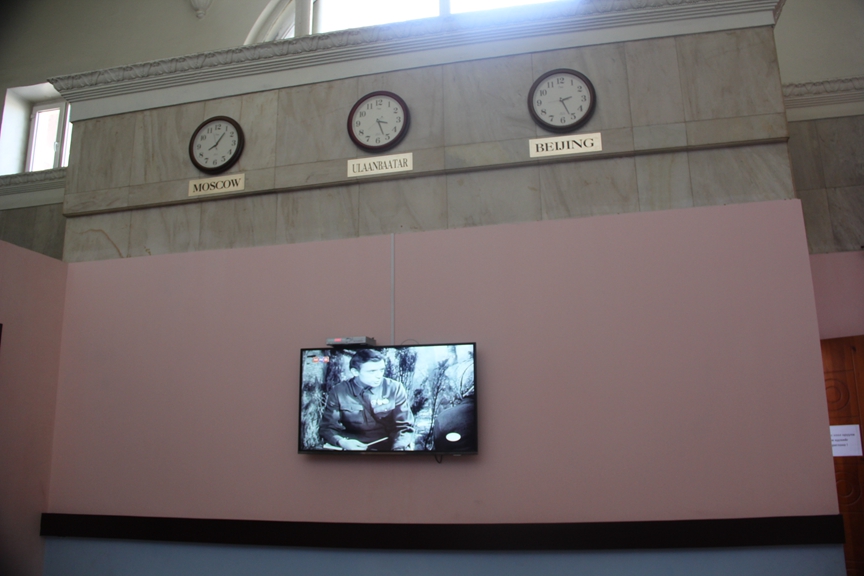 A single television plays a black and white Soviet film beneath clocks for Moscow, Ulaan Baatar and Beijing, the capital cities of the three countries through which the Trans-Mongolian Railway runs.
A single television plays a black and white Soviet film beneath clocks for Moscow, Ulaan Baatar and Beijing, the capital cities of the three countries through which the Trans-Mongolian Railway runs.
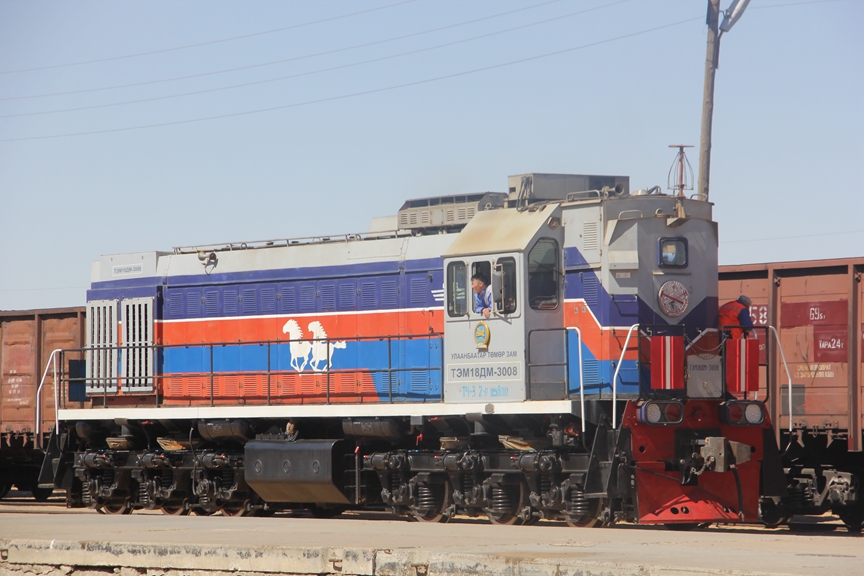 I don’t know much about locomotives but I quite admire them aesthetically, especially older models like this one from the Soviet era. A hammer and sickle emblem on the front suggests Soviet provenance but the double horse logo on the side suggests that this a Mongolian train.
I don’t know much about locomotives but I quite admire them aesthetically, especially older models like this one from the Soviet era. A hammer and sickle emblem on the front suggests Soviet provenance but the double horse logo on the side suggests that this a Mongolian train.
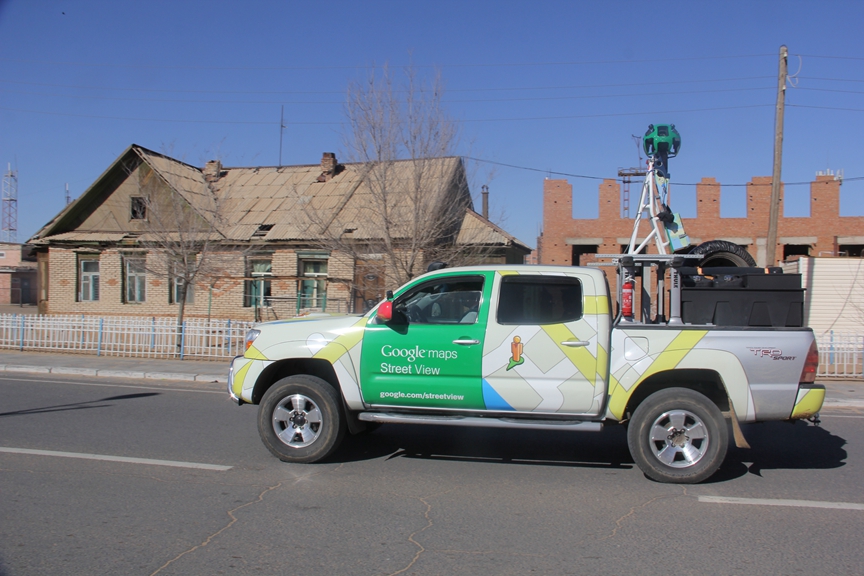 After admiring Mongolia’s rolling stock over several undisturbed beers, we decided to switch up the scenery and wander around downtown Zamiin Uud. With little more than 10,000 inhabitants (by contrast, the population of Erenhot on the Chinese side of the border is 75,000) this sleepy Mongolian border town doesn’t offer much in the way of sights but we did happen to come across a Google truck driving around taking pictures for its Street View service, which is the first time I’ve ever actually seen such a truck in action. What are the chances of it happening in such a tiny place?
After admiring Mongolia’s rolling stock over several undisturbed beers, we decided to switch up the scenery and wander around downtown Zamiin Uud. With little more than 10,000 inhabitants (by contrast, the population of Erenhot on the Chinese side of the border is 75,000) this sleepy Mongolian border town doesn’t offer much in the way of sights but we did happen to come across a Google truck driving around taking pictures for its Street View service, which is the first time I’ve ever actually seen such a truck in action. What are the chances of it happening in such a tiny place?
 “Smile Chicken” is an amusing, albeit somewhat odd, name for an “Ice Cream Restaurant”.
“Smile Chicken” is an amusing, albeit somewhat odd, name for an “Ice Cream Restaurant”.
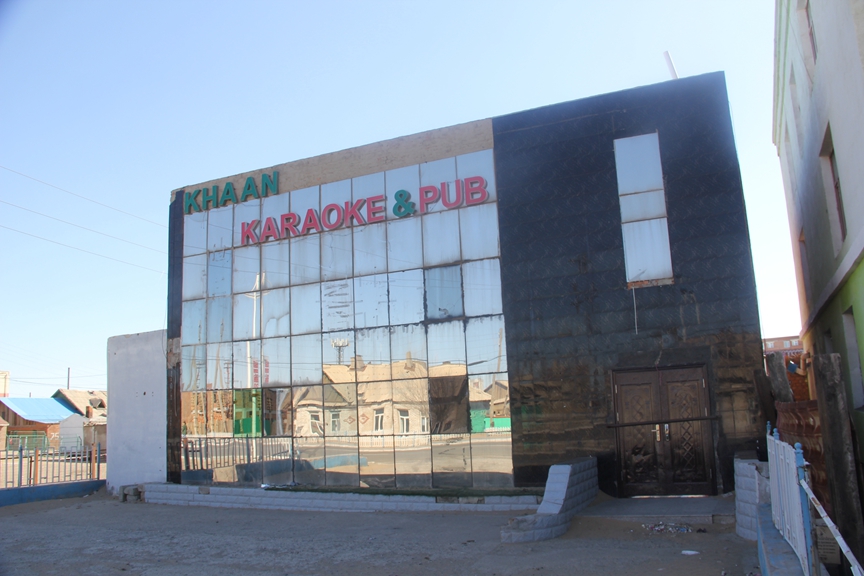 Khaan Karaoke & Pub is such a depressing looking nightlife establishment that I couldn’t help but document it.
Khaan Karaoke & Pub is such a depressing looking nightlife establishment that I couldn’t help but document it.
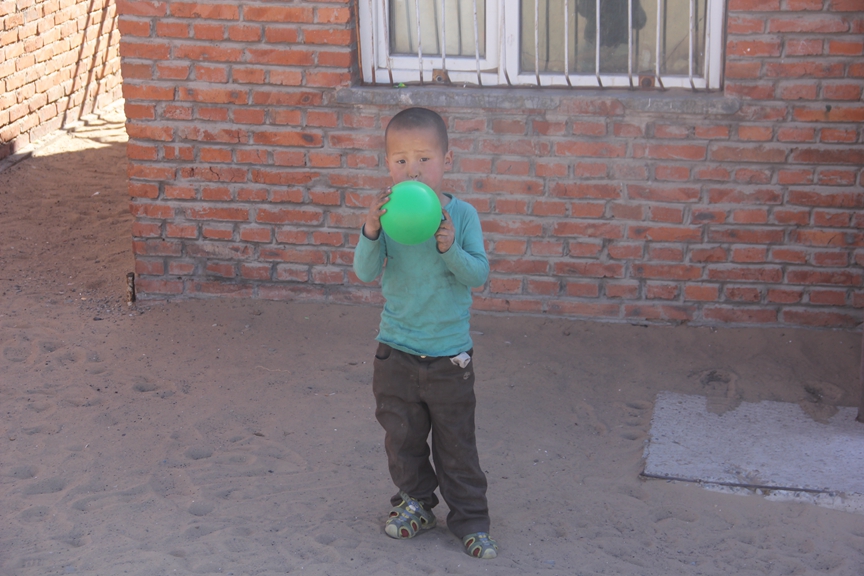 This kid followed us around for a bit, so Dion bought him a balloon.
This kid followed us around for a bit, so Dion bought him a balloon.
Trans-Mongolian Railway
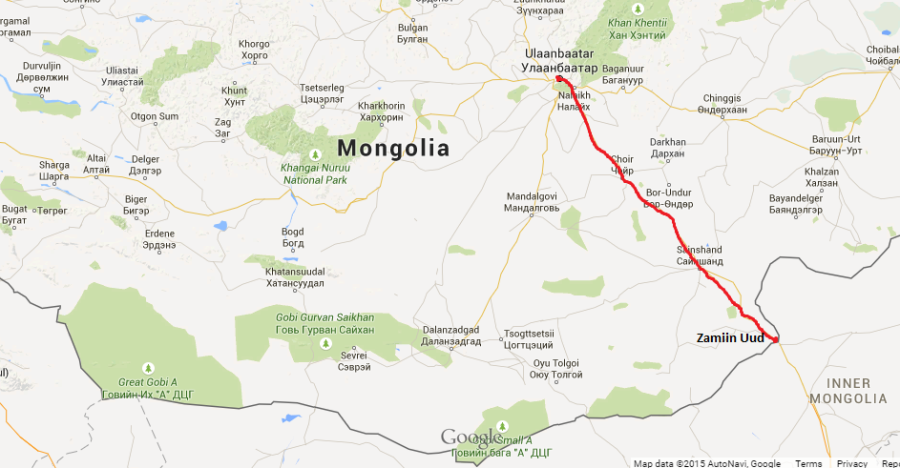 The red line on this map shows the rail route from Zamiin Uud to Ulaan Baatar.
The red line on this map shows the rail route from Zamiin Uud to Ulaan Baatar.
The roughly 800 km journey from Zamin Uud to UB took about 14 hours but was pleasant and comfortable. Mongolia only has one major railway line, the Trans-Mongolian Railway. Totaling just over 1,100 km, it connects the Trans-Siberian Railway with Erenhot (the Chinese border town where we crossed into Mongolia), from where it continues on to Beijing. There are a few spur lines leading to coal mines and an old Soviet military base but passenger rail transport is largely limited to this single line that spans the entire length of the country from north to south. By contrast, the Chinese province or “autonomous region” of Inner Mongolia, which borders Mongolia, has 9 separate railway lines. This discrepancy is no doubt due in large part to the fact that Mongolia , which is actually about 20% bigger in land area than Inner Mongolia, only has an estimated 3 million inhabitants, while the latter has more than 24 million!
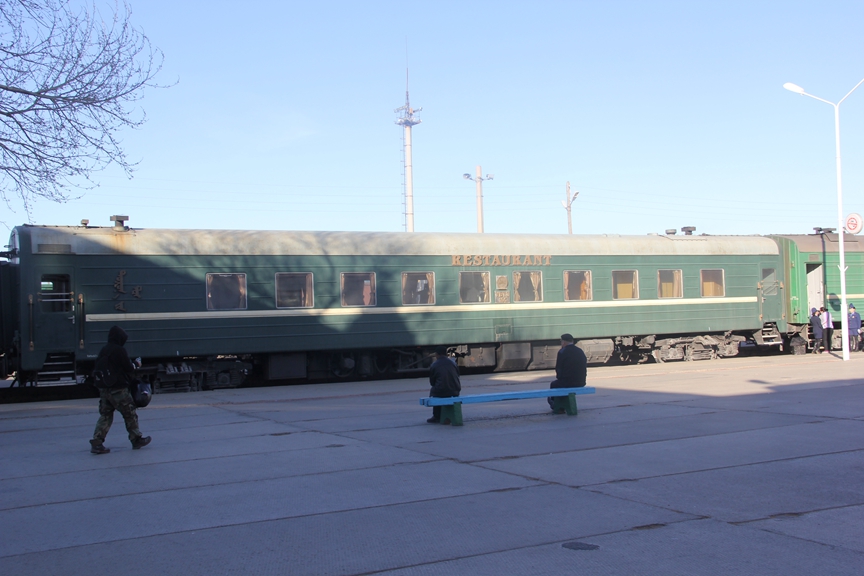 About to board our train to Ulaan Baatar. I love train travel and try to ride the train in every country I visit when possible. I particularly enjoy Soviet era trains. They have a sturdy, vintage aesthetic that I find much more appealing than the sterile, plastic aesthetic of modern trains.
About to board our train to Ulaan Baatar. I love train travel and try to ride the train in every country I visit when possible. I particularly enjoy Soviet era trains. They have a sturdy, vintage aesthetic that I find much more appealing than the sterile, plastic aesthetic of modern trains.
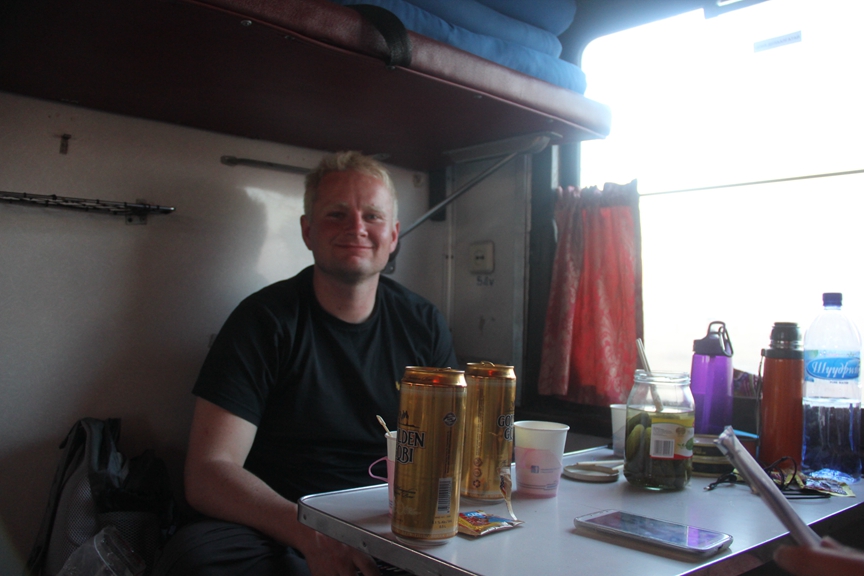 We drank several cans of Golden Gobi, a richly flavoured Mongolian beer, on the train and paired them with delicious dill pickles imported from the best pickle producing country on earth, Poland.
We drank several cans of Golden Gobi, a richly flavoured Mongolian beer, on the train and paired them with delicious dill pickles imported from the best pickle producing country on earth, Poland.
Mongolian beer is generally very good, even by Western standards. For reasons that still baffle me, it seems that pretty much all of China’s neighbors brew infinitely better beer than the horse piss that’s mass-produced in China. How can it be that countries with comparatively miniscule populations like Mongolia and Laos produce brew delicious beer, while the world’s most populous country, which also happens to be the world’s largest consumer of beer by volume, produces quite possibly the worst beer in the world?? Chinese made dill pickles are also substandard but that’s much less surprising.
Our hard sleeper car was quite spacious and comfortable. The design was also very different from Chinese hard sleepers. For instance, Chinese trains don’t have single hard sleeper bunks above a seating area. Instead the bunks are stacked in threes, a lower, middle and top bunk, with 2 stacks side by side in one compartment. By contrast, Mongolian hard sleeper cars only have a lower and upper bunk for a total of 4 bunks in one compartment, in addition to the single bunk shown in the below photo, for a total of 5 bunks per compartment, instead of 6 bunks on Chinese trains. Mongolian trains are also quite a bit wider, which makes them much more spacious and comfortable. The clincher though is sit down toilets, an amenity one could never hope to expect in even the most luxurious of Chinese passenger trains.
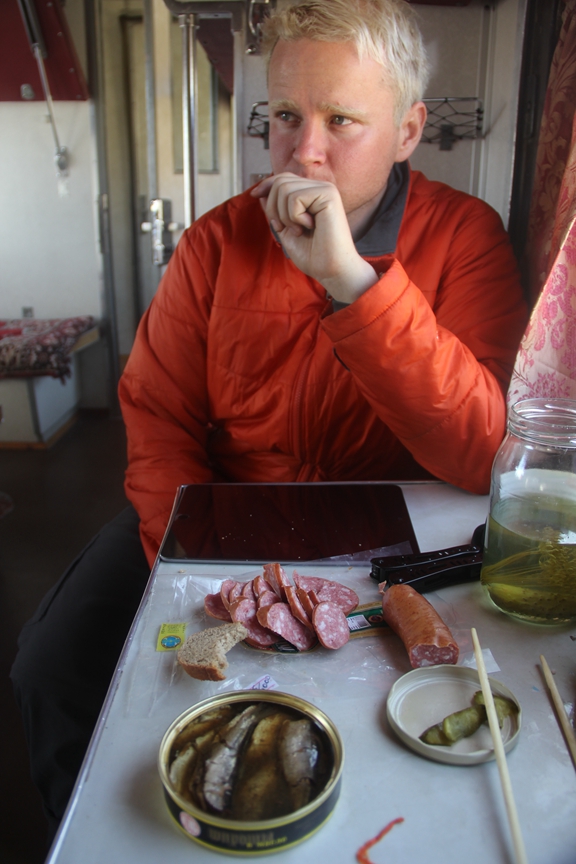 Dion enjoying a delicious breakfast of canned sardines, kolbasa, dill pickles and rye bread.
Dion enjoying a delicious breakfast of canned sardines, kolbasa, dill pickles and rye bread.
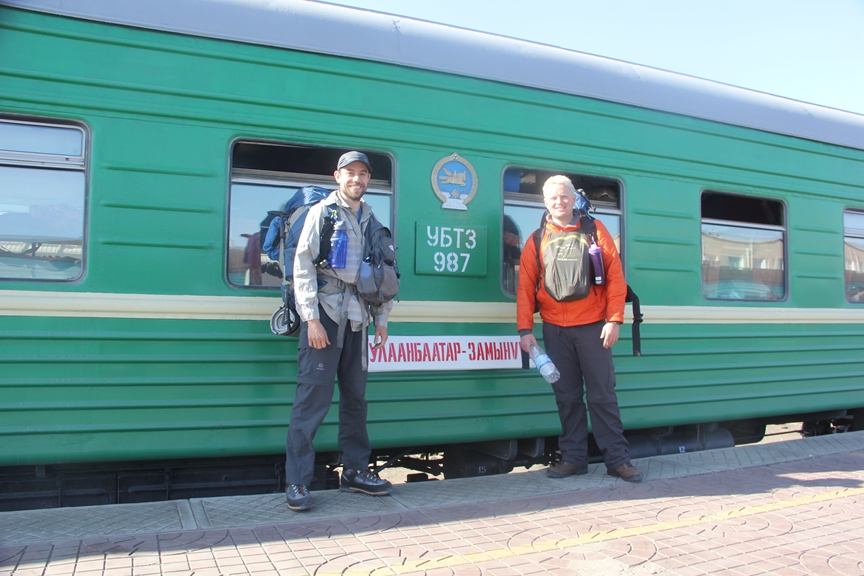 Dion and I posing in front of the train after our arrival in Ulaan Baatar the following morning. For some reason, I neglected to take any scenery photos during the 14 hour journey. Most of it was at night but I did have the opportunity to take a few nice photos in the morning before arriving in UB. I blame the hangover for making me too lazy.
Dion and I posing in front of the train after our arrival in Ulaan Baatar the following morning. For some reason, I neglected to take any scenery photos during the 14 hour journey. Most of it was at night but I did have the opportunity to take a few nice photos in the morning before arriving in UB. I blame the hangover for making me too lazy.
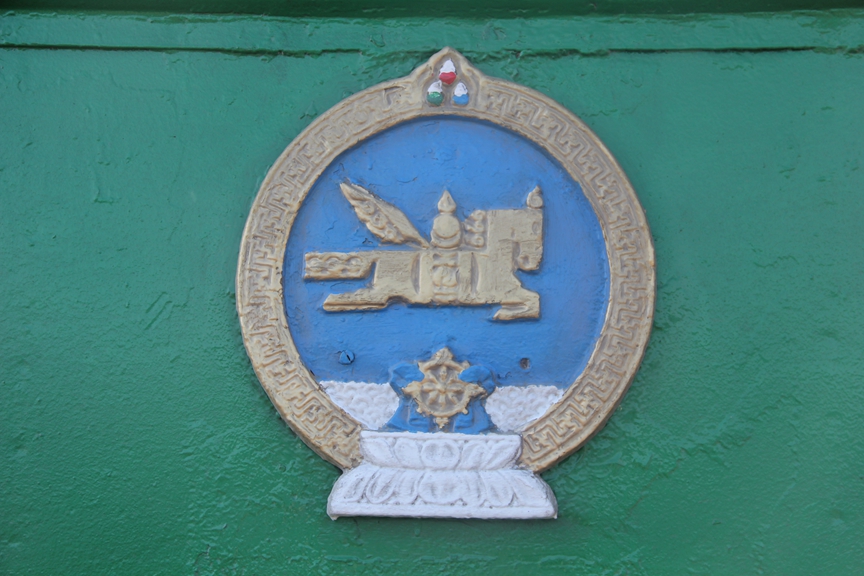 This is the “state emblem of Mongolia”, which is used by the Mongolian government as the official symbol of state. The center depicts a “wind horse”, which is apparently “an allegory for the human soul in the shamanistic tradition of East Asia and Central Asia.”
This is the “state emblem of Mongolia”, which is used by the Mongolian government as the official symbol of state. The center depicts a “wind horse”, which is apparently “an allegory for the human soul in the shamanistic tradition of East Asia and Central Asia.”
Ulaan Baatar
We arrived in UB at about 10:30 in the morning and hadn’t arranged a place to stay beforehand but fortunately our Lonely Planet guide listed a number of youth hostels that were located within a short distance of the train station, so we decided to just walk until we found one that we liked. Within less than 10 minutes we stumbled upon one called Idre’s Guest House while actually on our way to another hostel but decided to check it out anyway because it was also listed in the Lonely Planet. It was clean and cozy and only $8 USD per person per night, so we decided to cut short our search and stay there. We only intended to stay in UB one night as we wanted to leave by bus the next day for distant Bayan Olgii aimag (aimag = province in Mongolian), a remote province in the extreme northwest of the country, bordering both China’s Xinjiang province and Russia. After dropping off our bags and quickly freshening up, we found a place to eat nearby, then took a taxi to the long distance bus station to try to buy bus tickets for the next day. Luckily, we were able to buy tickets for the 1,700 kilometre journey but our relief at having secured them immediately evaporated when the sales clerk said that the journey would take roughly 3 days! We had read as much in the Lonely Planet guide but were hoping that the information was incorrect. The thought of spending 3 days straight on a bus was a painful one but we were committed to the undertaking. We could have taken a 3 hour flight instead like any sane person who could afford it, but decided to grin and bear the bus ride instead in order to A.) save money, and B.) experience traveling across the country by land, which is obviously a more intimate way to experience a country than commercial air travel.
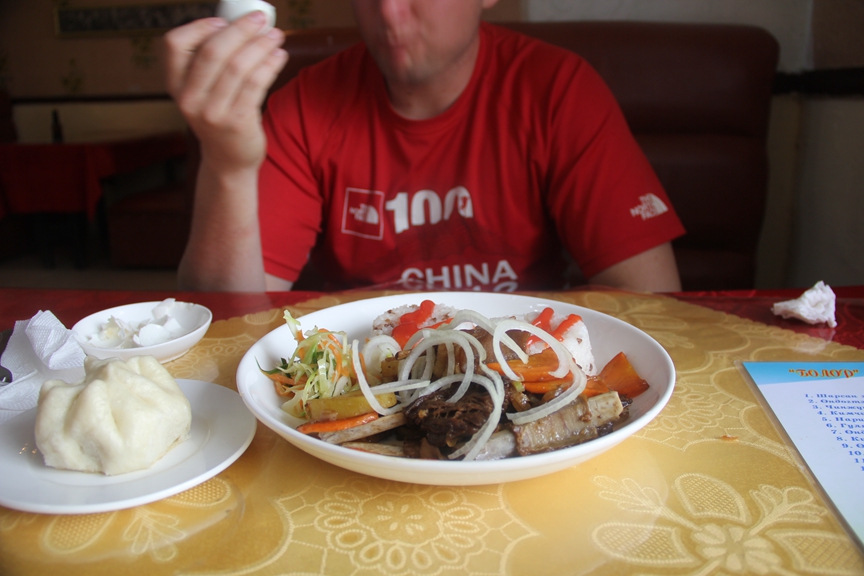 Dion thoroughly enjoyed this delicious dish of tender lamb shank, so tender that the meat slid right off the bone.
Dion thoroughly enjoyed this delicious dish of tender lamb shank, so tender that the meat slid right off the bone.
After buying our tickets we managed to take a city bus back to our hostel (which cost a mere 5% of what it cost to take a taxi from our hostel to the bus station) and from there we walked to a mountaineering store in the centre of the city, called Seven Summits where Dion was hoping to find a pair of crampons. The crampons were for climbing Khuiten Uul, Mongolia’s highest mountain, located in the far northwest of the country, right on the border of China and Russia. At 4,375 metres, Khuiten Uul, which means “Cold Mountain” in Mongolian, isn’t a particularly high or challenging mountain by mountaineering standards but it’s a snow-capped mountain that requires proper equipment to climb it, especially crampons. It was actually Dion’s idea to try to climb Khuiten but he neglected to buy a proper pair of crampons before we left Beijing, so he had to get a pair in UB before we left for Bayan Olgii the following day. The store turned out to be fairly well stocked with high quality imported Western equipment but the prices were prohibitively expensive, so we decided to try a climbing store nearby that turned out to only sell Petzel brand climbing equipment from France. Petzel is a reputable brand but the cheapest crampons at this store cost $152 USD, which was quite a bit more than Dion was planning to spend, especially since I had bought my Chinese made crampons in Beijing for about $25 USD. Unfortunately, his only other option in UB was a $250 USD pair at Seven Summits. Therefore, while he regretted not having bought a pair in Beijing like I had, he had no choice but to bite the bullet and fork over $152 for the French pair. He tried to offer them $150 USD in cash but they refused and actually seemed a little annoyed that he tried to bargain with them, even for a mere two dollars. Later we came to realize that quite unlike the Chinese, Mongolians weren’t into bargaining, with foreigners at least, and sometimes even seemed offended by our attempts to negotiate prices. The crampons were clearly of high quality though, so $152 seemed reasonable enough, and he definitely needed a pair.
After purchasing the crampons, we decided to walk over to Chinghis Square, which was only a few blocks away. The main public square in UB, Chingis Square, is the Mongolian equivalent of Tiananmen Square in Beijing but even more impressive, in my opinion.
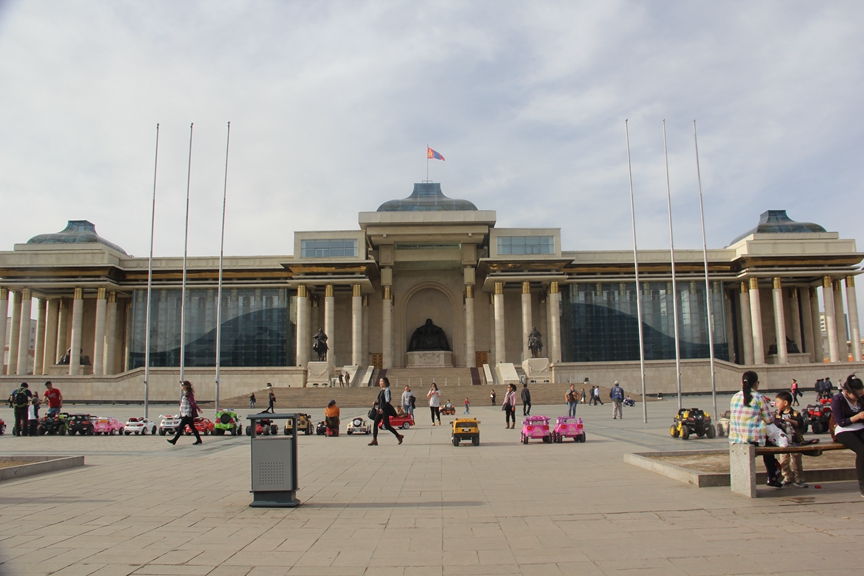 The square is dominated by this sleek, palatial colonnade with a massive bronze statue of Chinghis Khan at its center, flanked by statues of his son and successor Ogedei Khan and grandson, Kublai Khan who ruled as Emperor of China during the Yuan Dynasty.
The square is dominated by this sleek, palatial colonnade with a massive bronze statue of Chinghis Khan at its center, flanked by statues of his son and successor Ogedei Khan and grandson, Kublai Khan who ruled as Emperor of China during the Yuan Dynasty.
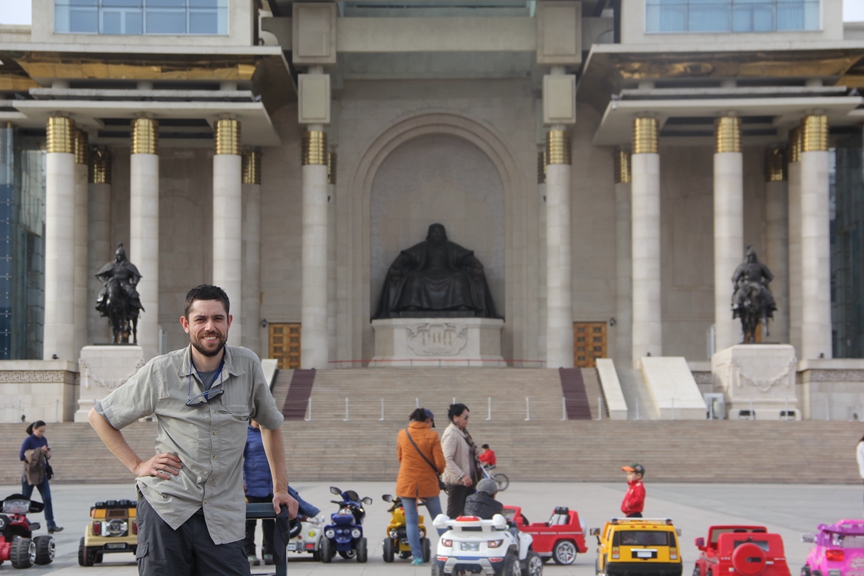 The two equestrian statues on either side of the Chingis Khan statue seen in this photo are actually not of his son and grandson but instead are of his two most trusted military retainers; the statues of Ogedei and Kublai are outside the photo at the far ends of the building.
The two equestrian statues on either side of the Chingis Khan statue seen in this photo are actually not of his son and grandson but instead are of his two most trusted military retainers; the statues of Ogedei and Kublai are outside the photo at the far ends of the building.
 The statue of Kublai Khan is on the right corner but is obscured by columns at this angle.
The statue of Kublai Khan is on the right corner but is obscured by columns at this angle.
At the centre of Chinghis Square is a statue of Damdin Sukhbaatar, a leader of Mongolia’s successful 1921 revolution, in which the Soviet Red Army helped Mongolian nationalists liberate the country from Chinese occupation. Ulaan Baatar actually means “Red Hero” in Mongolian and was chosen as the new name for the city after the establishment of the Mongolian People’s Republic in 1924.
The statues on Chingis Square are a testament to just how much Mongolians both cherish their independence and maintain a strong sense of national historical greatness. They are extremely proud of the global conquests of Chingis Khaan and his successors 800 years ago but also jealously guard their new-found national independence, which was only truly realized after the fall of the Soviet Union. During the Soviet era, Mongolia could claim de jure independence but was in actuality a de facto satellite state of the Soviet Union for most of the 20th century. Before that, the Manchu Qing Dynasty, which ruled China for more than 250 years, also managed to rule both Inner and Outer Mongolia for almost as long. However, when the Qing dynasty fell in 1911, Outer Mongolia quickly seized the opportunity to throw off the Manchu yoke and declare independence. The newly founded Republic of China resolutely opposed this, but was eventually forced by the Soviet Union to relinquish all territorials claims to Outer Mongolia. Today, Mongolia remains uncomfortably sandwiched between its two powerful neighbors and former overlords, China and Russia. Landlocked and bordering only two countries, Mongolia also happens to be the least densely populated country in the world, so given its history, geographic vulnerabilities, and sparse population, it’s unsurprising that Mongolians are so jealous of their independence.
The rest of our day was spent walking back from Chingis Square to our hostel. Apart from the square and a few nearby monuments and government buildings, there isn’t a whole lot of sightseeing to be had in UB, but it’s an interesting enough city to explore in good weather, which we were lucky enough to enjoy. UB is a fairly dilapidated, ramshackle affair but with a certain post-Soviet charm reminiscent of Central Asian capitals like Bishkek and Dushanbe.
 It was also interesting to see traditional Mongolian gers like these surrounded by more typically “urban” brick and mortar housing, ie, the Soviet Era tenements in the immediate background.
It was also interesting to see traditional Mongolian gers like these surrounded by more typically “urban” brick and mortar housing, ie, the Soviet Era tenements in the immediate background.
Commonly known as a “yurt” in Western parlance, Mongolian gers are traditional nomadic dwellings still used by about a third of the country’s population. Each Mongolian ger typically weighs about 250 kg and is designed to be completely portable and quickly assembled. Most gers in Mongolia are scattered throughout the country’s vast steppe and Gobi desert regions but tens of thousands also exist in “ger suburbs” on the outskirts of UB. Unlike in the countryside where ger dwellers typically burn animal dung for heating and cooking, urban gers are mainly heated by crude coal-burning stoves, which contribute to the capital’s frightening levels of air pollution, especially during its long and blistering cold winters.
UB is clearly a city experiencing rapid transformation and growth. With a population of roughly 1.3 million, its population accounts for roughly 40% of the national total and that percentage is likely to increase as the country’s mining boom propels economic growth and modernization. Unfortunately, one downside of that growth is the horrendous traffic congestion and air pollution. As a long time resident of Beijing, I’m all too familiar with both, but UB is even worse. Interestingly, however, while most of the cars in Beijing are new Chinese-made models, the clear majority of cars in UB are used Japanese imports, particularly the Toyota Land Cruiser, but also the Toyota Prius, which was very surprising to see. Even in the tiny border town of Zamiin Uud, I was shocked that the Prius was so popular. And the reason I know that most of the Japanese brand cars are second-hand imports from Japan is because the steering wheels are on the right side (Mongolians drive on the right side of the road so these cars weren’t designed for the Mongolian market), while most also have stickers and insignia that indicate that they were previously driven in Japan.
Another observation about UB worth mentioning is the large number of alcoholic beverage containers (mostly vodka bottles) littering the streets, which points to the country’s epidemic of alcoholism. Ironically, we didn’t actually see anyone drinking in the streets though, which is probably due to the fact that there is a nation-wide ban on public alcohol consumption that is apparently strictly enforced with steep fines. This likely explains why Dion and I got so much flack from that group of young men in Zamiin Uud for drinking beer in a public park (for the record, we didn’t read about this ban until arriving in UB). We also read that bars in UB are only permitted to serve drinks until 11:30 pm and must close at midnight, which seems rather prudish, but is probably another attempt to combat alcoholism. Partially for that reason, we didn’t even bother going to a bar during our only night in UB, but instead bought some beer at a convenience store and drank it in our hostel. The main reason though, was that we still had a few errands to run the next day and didn’t want to be hung over for the beginning of our 3 day bus journey which was scheduled to begin the following afternoon.
To see more photos of Ulaan Baatar, please click here.
Bus to Bayan Olgii
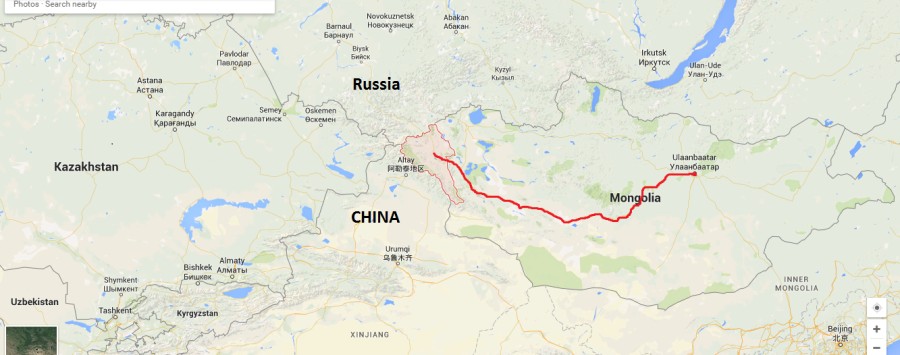 The red line is the roughly 1,700 km route we took from UB (on right) to the town of Olgii, provincial capital of Bayan Olgii province (outlined in red).
The red line is the roughly 1,700 km route we took from UB (on right) to the town of Olgii, provincial capital of Bayan Olgii province (outlined in red).
Our bus to Bayan Olgii aimag (province) was scheduled to leave at 3pm. We arrived at the bus station at 2:30 by taxi but had trouble finding our bus even with the help of our taxi driver. When we did finally find it after about 15 minutes of asking around, we were horrified to discover that it wasn’t a sleeper bus or even a relatively comfortable sitting bus; it was a beat up old, Korean clunker that looked more like a public transit bus than a long distance passenger coach. Living in China for so long, I’d grown accustomed to travelling on modern sleeper buses, which albeit not the most comfortable option for long distance travel, are certainly far more comfortable than sitting upright, especially for 3 days straight! When we got on board we also discovered that nearly half the bus was full of cargo. To make matters worse, we drove to another bus stop a few kilometers away where even more cargo was loaded onto our bus, which meant that we didn’t get out of the city until 5pm. Fortunately, there were only 10 passengers on the bus, including Dion and I, so I actually ended up getting two seats to myself, which was a great relief.
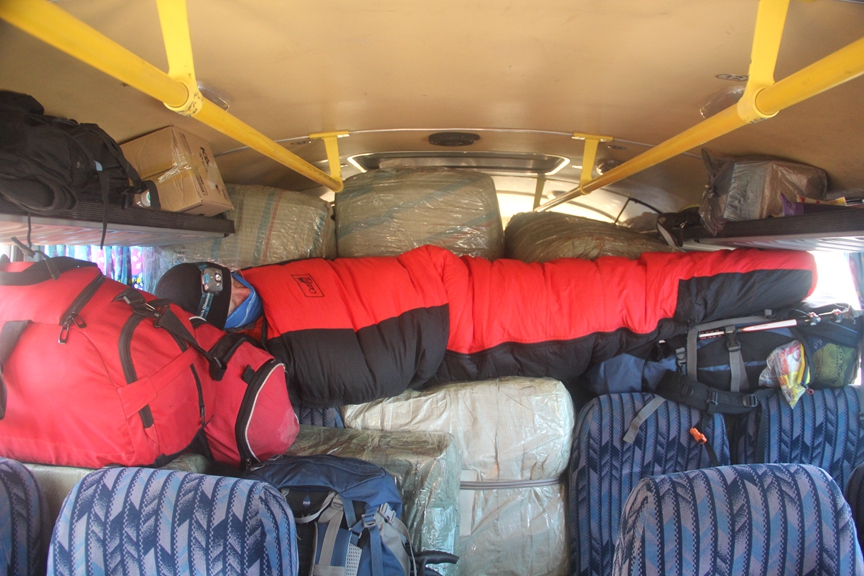 Quite ingeniously, Dion turned several big boxes of cargo into a comfortable bed, which he slept on in his sleeping bag. Neither of the two drivers seemed to mind, so he was able to sleep like this for two nights.
Quite ingeniously, Dion turned several big boxes of cargo into a comfortable bed, which he slept on in his sleeping bag. Neither of the two drivers seemed to mind, so he was able to sleep like this for two nights.
 On the second morning our bus broke down and the drivers had to almost completely disassemble the engine. It took them more than 6 hours to get it running again. Luckily, we were able to pass the time at a roadside canteen called a “guanz” where we had lunch and spent hours sipping salty milk tea.
On the second morning our bus broke down and the drivers had to almost completely disassemble the engine. It took them more than 6 hours to get it running again. Luckily, we were able to pass the time at a roadside canteen called a “guanz” where we had lunch and spent hours sipping salty milk tea.
We stopped at a guanz twice a day for meals. The traditional Mongolian food they served was tasty enough but several hours after eating dinner at one on the second night, I was awaken by an evil rumbling in my stomach that quickly progressed to my bowels. I tried to ignore the unpleasant sensation for a few minutes but was eventually forced to ask the driver to stop the bus and let me out. I barely made it 2 metres from the bus before I had to drop my pants and relieve myself in the darkness. About a minute later, I heard someone else get off the bus and walk toward me, which filled me with panic because I was still squatting with my pants around my ankles. It turned out to be one of the male passengers and he was practically right on top of me before he realized I was there. Once he did, I pulled my pants up half way and scurried away in embarrassment until I was about 15 metres from the bus, where I again quickly assumed a squatting position. To my great dismay, however, less than a minute later a female passenger from the bus suddenly walked towards me and squatted about 3 metres in front of me before suddenly realizing that I was there, at which point she jumped up in alarm and scurried deep into the darkness and out of sight. It was an embarrassing fiasco at the time but I was soon able to laugh it off and have since retold it many times to amused listeners.
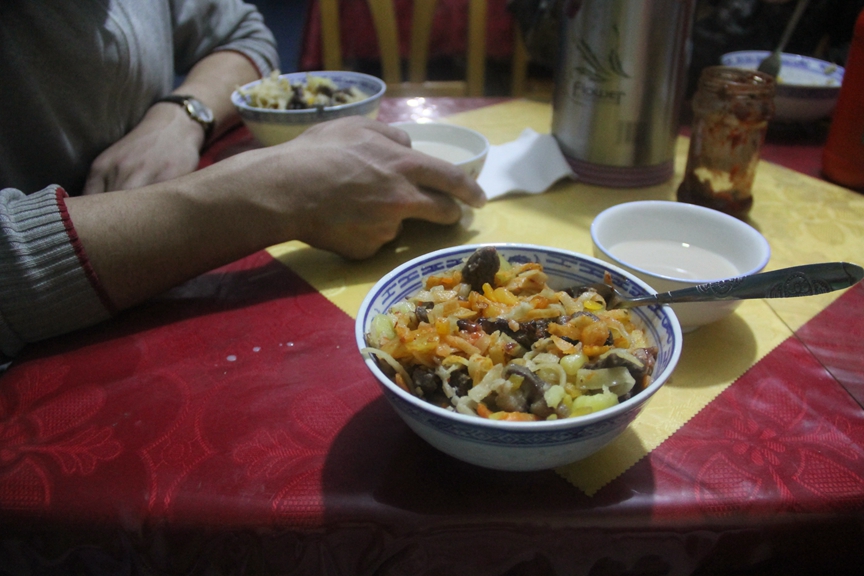 A typical meal at a roadside guanz. I can’t remember exactly what was in this bowl but I think it was a combination of dry, slightly coarse noodles with pieces of mutton, onion and potato. And of course, every meal is accompanied by bowls of salty milk tea.
A typical meal at a roadside guanz. I can’t remember exactly what was in this bowl but I think it was a combination of dry, slightly coarse noodles with pieces of mutton, onion and potato. And of course, every meal is accompanied by bowls of salty milk tea.
We got along well with the other passengers, some of whom spoke a bit of English. I would even go so far as to say we bonded with a few of them during the journey. We all shared food with one another and got to know each other a little bit as well. All the Mongolian passengers actually turned out to be ethnic Kazakhs, a Muslim minority ethnic group in Mongolia who make up about 4 percent of Mongolia’s population. While citizens of Mongolia, they are not ethnic Mongols, most of whom are nominally Buddhist. One of the Kazakh passengers was a 23 year-old soldier, two others were university students and a few others were petty traders. The traders were on their way back to Bayan Olgii province from the Chinese border town of Erenhot, roughly 2,500 kilometres away, where they had gone to buy trade goods to resell in Bayan Olgii. What was most astonishing about this though was the fact that Bayan Olgii province actually borders China’s Xinjiang province, which has a border crossing with Mongolia, so I couldn’t understand why they had made a 5,000 km round trip journey to buy goods in Erenhot when they could have travelled a mere few hundred kilometers to Xinjiang and bought goods there. I asked them this question but didn’t get a clear answer. From what I could gather, it seemed like they were saying they weren’t allowed to cross the border into Xinjiang but this didn’t really make sense, since I had read that the border crossing was open and traders from both sides use it. Perhaps prices are simply lower in Erenhot than Xinjiang, so they could make bigger profits even when factoring in the higher transport costs of travelling a much further distance. But then again, I’m only speculating.
 Triple thumbs up with Dion, the soldier and a university student.
Triple thumbs up with Dion, the soldier and a university student.
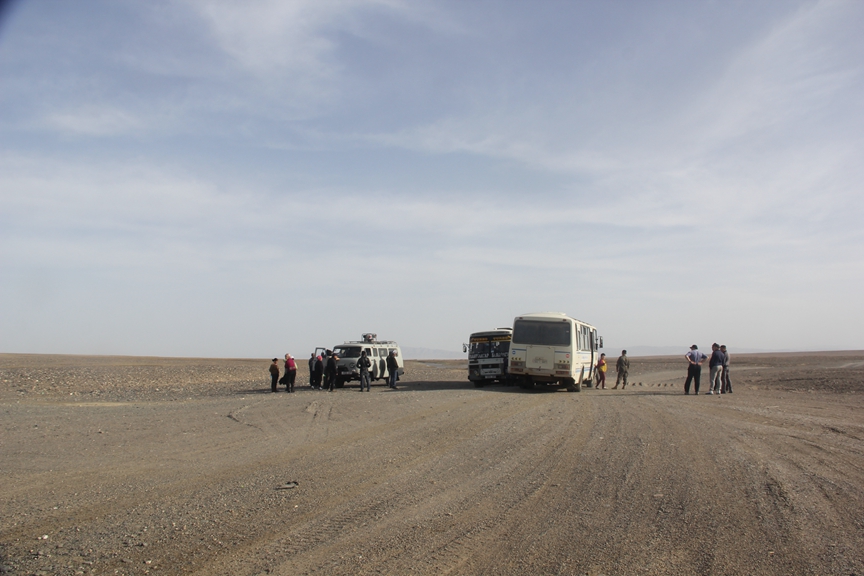 We passed very few automobiles during our nearly 1,700 km journey, probably only one every couple of hours, if that. We stopped here somewhere in the middle of the Gobi desert because the bus next to us had broken down and our driver offered to help.
We passed very few automobiles during our nearly 1,700 km journey, probably only one every couple of hours, if that. We stopped here somewhere in the middle of the Gobi desert because the bus next to us had broken down and our driver offered to help.
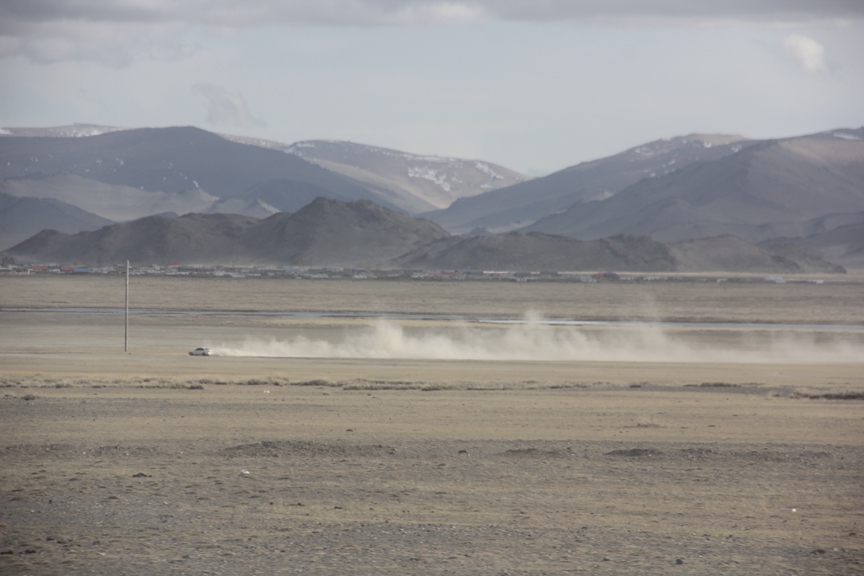 At least 3 quarters of the journey was literally off-road, driving on dirt tracks through dusty, barren landscapes. The Mongolian government claims the country has 50,000 km of “roads” but only 5,000 km are paved.
At least 3 quarters of the journey was literally off-road, driving on dirt tracks through dusty, barren landscapes. The Mongolian government claims the country has 50,000 km of “roads” but only 5,000 km are paved.
Evidence of human habitation along the route our bus traveled was slim to say the least, consisting mainly of the odd lone ger every few hours or tiny mixed ger/brick and mortar settlements. Three times the size of France but with only 3 million people (France has about 67 million), Mongolia is the least densely populated country in the world and when you leave the capital, which accounts for 40% of that total, the paucity of human settlement over vast tracts of land is clearly evident.
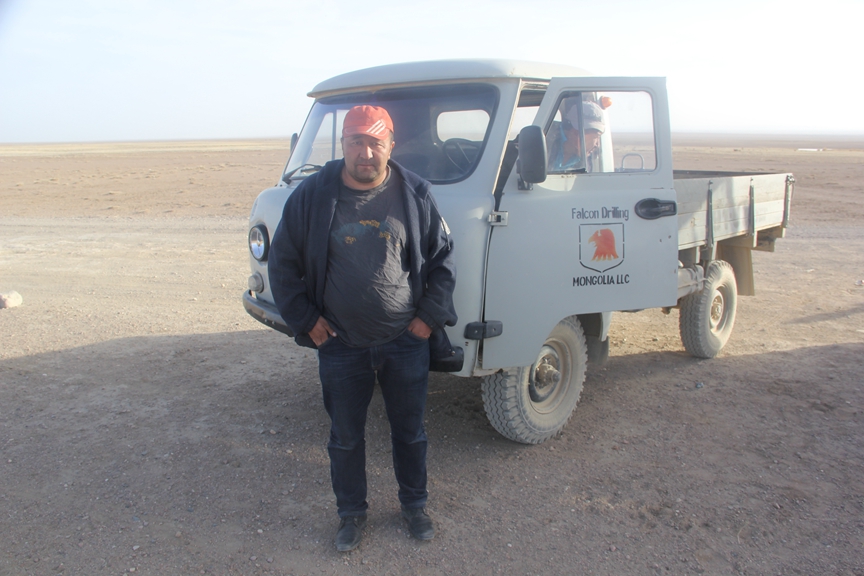 Without knowing that I was Canadian, this gentleman proudly announced to me that Falcon Drilling was a Canadian company.
Without knowing that I was Canadian, this gentleman proudly announced to me that Falcon Drilling was a Canadian company.
The mining sector in Mongolia has been booming for the past decade and Canadian mining firms have a significant presence in the country, but although Mongolia has become a magnet for international mining companies, the vast majority of rural Mongolians still depend of animal husbandry for their livelihoods. Mongolia has 3 million people and over 40 million livestock, mostly sheep and goats but also plenty of horses, cattle and camels.
During our last stop at a guanz before arriving at our destination, Dion was challenged by the young soldier on our bus to an arm wrestling match, which he quickly lost.
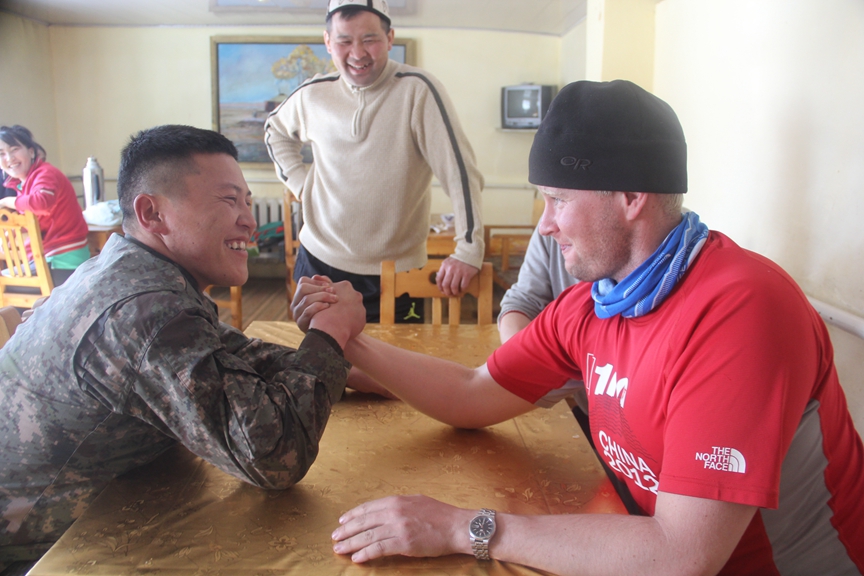 Dion put up a valiant, albeit brief, fight but didn’t really stand much of a chance. The soldier asked if I wanted to challenge him next but I resolutely declined. The man standing between them in this photo and smiling took up the challenge though, and quickly defeated him, which neither I nor Dion expected.
Dion put up a valiant, albeit brief, fight but didn’t really stand much of a chance. The soldier asked if I wanted to challenge him next but I resolutely declined. The man standing between them in this photo and smiling took up the challenge though, and quickly defeated him, which neither I nor Dion expected.
We arrived in the town of Olgii, capital of Bayan Olgii province, about 56 hours after leaving UB, which was much sooner than the 72 hours we had anticipated. The journey, punctuated by two breaks per day for meals and several breakdowns, (one of which lasted 6 hours) wasn’t easy but it also wasn’t that bad. Dion was able to stretch out on a stack of boxes at the back of the bus and sleep comfortably in his sleeping bag, while I was lucky enough to have two seats to myself, which made the trip a whole lot more tolerable than if I had only one. It was a bumpy ride to be sure and quite uncomfortable at times, but we had fun interacting with and getting to know the other passengers. The worst parts of the trip for me were my embarrassing bout of diarrhea and coming down with a nasty little chest cold half way through the journey. I also discovered during the trip that my crampons had fallen out of a side pouch on my knapsack, which put me in a foul mood for about a day and a half. I looked everywhere I could during the journey but to no avail. When we finally arrived at our destination though, I decided to give it one last-ditch effort, which meant hauling a bunch of the boxes off the bus to check if the crampons had somehow been buried under them. Fortunately my hunch paid off and my efforts were rewarded when I found them on the floor of the bus, where they had been buried underneath a large stack of boxes. Finding my crampons lifted my spirits considerably. I had been fretting over them for most of the journey, since without them I wouldn’t be able to climb the mountain, which was the main reason we had travelled 56 hours to this remote corner of Mongolia.
Bayan Olgii
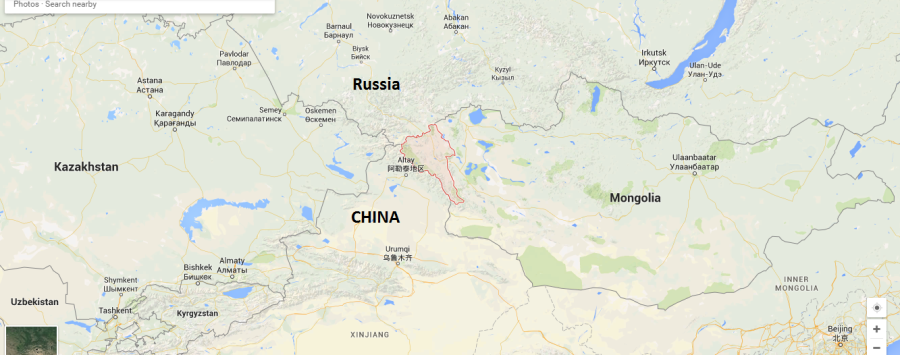 Bayan Olgii is outlined in red at the centre of this map.
Bayan Olgii is outlined in red at the centre of this map.
Located in the far northwestern corner of Mongolia, bordering both Russia and China, Bayan Olgii is the westernmost aimag (province) in Mongolia and probably the most remote of all 21 aimags in the country. Bayan Olgii is also unique for being the only Muslim and Kazakh-majority province in Mongolia. Almost 90% of the approximately 90,000 people living in the province are ethnic Kazakhs, a Turkic Muslim ethnic group from Central Asia and the ethnic majority in Kazakhstan, which also happens to be the largest Central Asian “Stan” country. By contrast, Mongolia’s main ethnic Mongol subgroup, the Khalka Mongols, who account for roughly 80% of the country’s population, account for only about 1% of the poputlation of Bayan Olgii. The Kazakh language is also widely spoken as a mother tongue in the province and while Mongolia doesn’t share a border with Kazakhstan, Bayan Olgii is only separated from the latter by a 38 kilometer strip of border between Russia and China’s Xinjiang province. Bayan Olgii’s close geographic and cultural proximity to both Kazakhstan and China’s Turkic Muslim majority Xinjiang province give it a distinctly Central Asian flavor not found in the rest of Mongolia. The provincial capital, Olgii, which has about 30,000 residents, is a dusty, windswept frontier town surrounded by mountains with several mosques, a madrassa (Islamic school) and a large bazaar. Olgii is also only about a 3 hour drive from the Russia border.
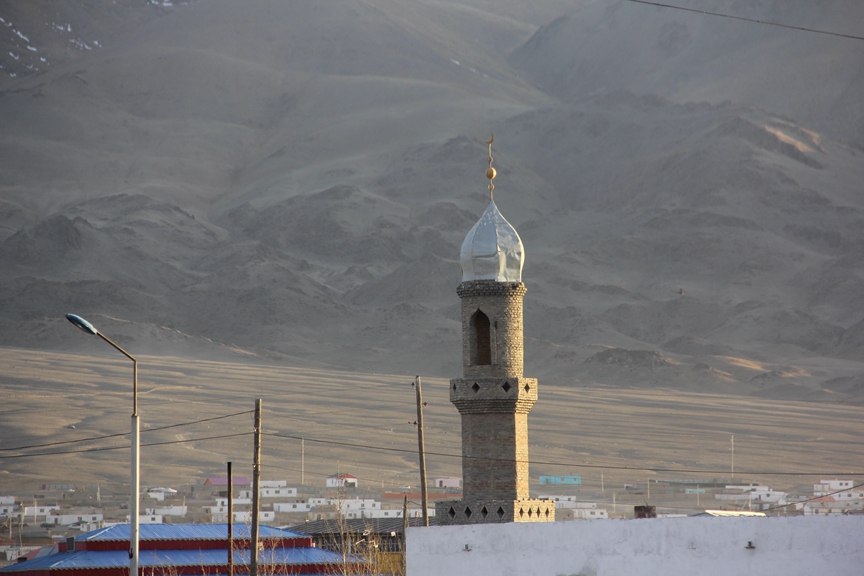 A minaret from one of several mosques in Olgii.
A minaret from one of several mosques in Olgii.
We arrived in Olgii at about 8 pm and made our way by foot to a hostel run by Blue Wolf Travel, one of several travel companies in town that cater to foreign tourists. Bayan Olgii is far off Mongolia’s backpacking circuit but increasing numbers of intrepid travelers have been going there over the past decade to explore its pristine national parks and experience traditional Kazakh cultural activities like eagle hunting, which, somewhat ironically, has apparently been better preserved there than in Kazakhstan. For instance, Bayan Olgii province is reported to have about 360 trained eagle hunters (people who use eagles to hunt small game like hares and foxes, not people who hunt eagles!), more than in all of Kazakhstan, and several eagle hunting festivals are held each year throughout the province to showcase this tradition for tourists.
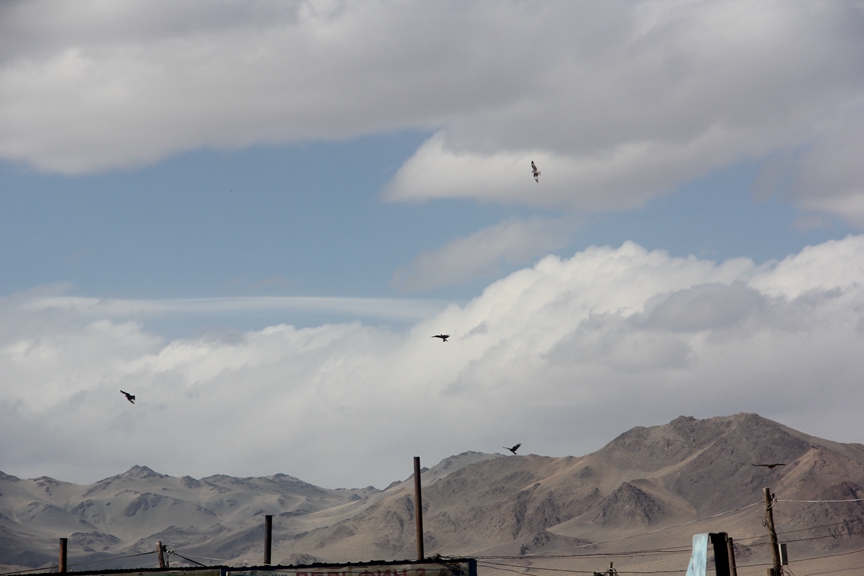 The sky over Olgii was full of golden eagles. I’ve never seen so many eagles at one time before; they’re to Olgii what pigeons are to New York City.
The sky over Olgii was full of golden eagles. I’ve never seen so many eagles at one time before; they’re to Olgii what pigeons are to New York City.
 This is probably a young male (males are smaller than females), but we also saw many large eagles.
This is probably a young male (males are smaller than females), but we also saw many large eagles.
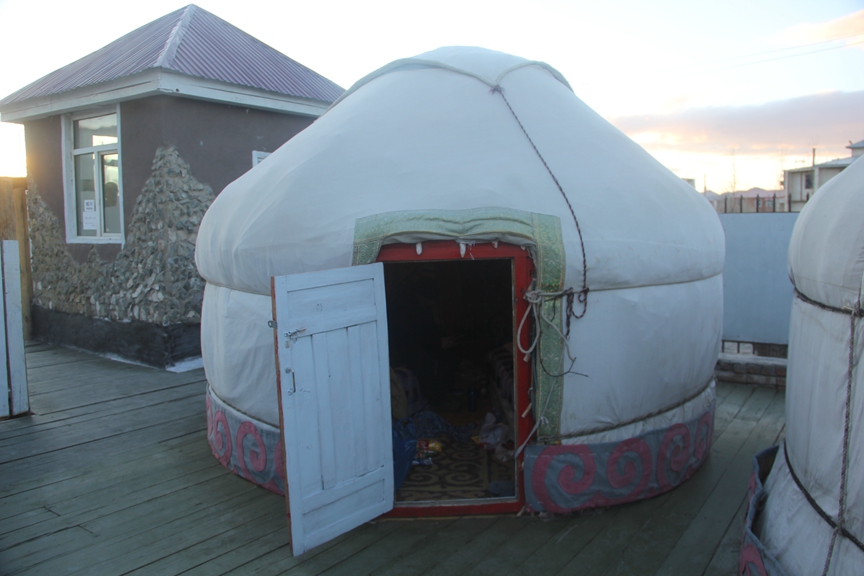 The “hostel” at Blue Wolf Travel consists of an outdoor wooden deck with about a dozen miniature gers on it; this was ours.
The “hostel” at Blue Wolf Travel consists of an outdoor wooden deck with about a dozen miniature gers on it; this was ours.
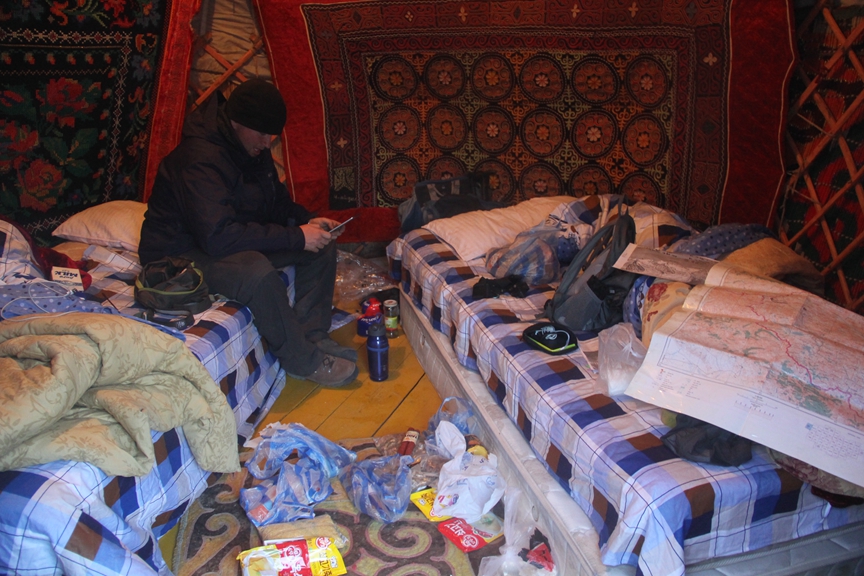 The gers have electrical outlets but the flow of electricity to the town, which comes from neighboring Russia, is highly unreliable. The gers also lack heating so it got pretty cold at night. There is a separate building with washrooms and showers for both genders but we were unable to get hot water during the two nights we stayed there, so didn’t bother showering. The $10 USD per person accommodation fee included a hearty breakfast though, so we were pretty satisfied.
The gers have electrical outlets but the flow of electricity to the town, which comes from neighboring Russia, is highly unreliable. The gers also lack heating so it got pretty cold at night. There is a separate building with washrooms and showers for both genders but we were unable to get hot water during the two nights we stayed there, so didn’t bother showering. The $10 USD per person accommodation fee included a hearty breakfast though, so we were pretty satisfied.
The main reason we decided to stay at Blue Wolf Travel wasn’t for the accommodation though, but instead because the owner of our hostel in Ulaan Baatar told us that the former could help us obtain both the necessary permit and pay a separate fee to enter the national park where the mountain we wanted to climb, Khuiten Uul, is located. We each needed to pay a 3000 tugrik ($1.50 USD) “Protected Area Entry Fee” to the Minister of Environment and Green Development but, more importantly, we also had to obtain a border permit from the Mongolian military because the national park borders both Russia and China. The border permit is technically free but the relevant authority is apparently unwilling to issue them directly to foreigners, so we had to use a Mongolian citizen to apply on our behalf, which Blue Wolf Travel was willing to do for a modest $10 USD fee per person. We had actually called Blue Wolf Travel from UB and asked them to apply for the permits for us before we arrived in Olgii so that they would be ready when we arrived, which they agreed to do, but when we finally arrived 3 days later, we discovered that they hadn’t even submitted our applications, which was quite disappointing. The owner of Blue Wolf Travel had even asked us to email photos of our passports, which we did, and said we could each pay him the $10 service fee after we arrived in Olgii and picked up the permits that he said would be waiting for us. However, when we actually met the owner at his office in Olgii, he explained that in order to apply for the permit he not only needed to provide copies of our passports, but also the ID and vehicle registration of the driver that planned to drive us from Olgii to the entrance of the national park. Strangely, he hadn’t mentioned any of this when I had first spoken to him on the phone from UB. Dion and I knew that Olgii was about 180 kilometres from the spot where we intended to enter the national park, and that there was no public transport, but we had no idea that we needed to already have a driver arranged to simply apply for the border permit.
As it turned out, one of the traders on our bus from UB to Olgii lived in a village about halfway between Olgii and the national park. During the bus journey he had offered to drive us from his village to the park for a fee, which we agreed to, so when we found out that we needed a driver to apply for the border permit, we told the owner of Blue Wolf Travel to call the man who agreed to be our driver, whose name was actually “Bold”, and he came to the office to meet us a short while later. Unfortunately, not long after arriving at the office and greeting us happily, our would-be driver, Bold, suddenly left in a bit of a huff. He and the owner of Blue Wolf Travel had been speaking in Kazakh for about 10 minutes and the conversation eventually became quite animated, at which point Bold suddenly stood up and left without saying goodbye. Feeling a bit confused, we asked the owner of Blue Wolf Travel what had just happened and he explained that Bold wasn’t willing to provide his ID and vehicle registration for our permit application because the owner had told him that he would also have to be “responsible” for us while we were in the park. This added layer of complexity to the application process came as quite a surprise to Dion and I, so we asked what “responsible” actually meant in this context. The owner replied that several years ago a couple of Frenchmen had actually walked the 180 kilometres from Olgii to the national park and once inside, one of them had crossed the border into Russia and was detained by Russia border guards, so ever since then, the Mongolian army has required foreigners to be driven to the park and their drivers have to be registered as part of the permit application. The owner told us not to worry though because, low and behold, he had a driver who could provide his ID and vehicle registration for the permit application who was also willing to take on the nebulous burden of “responsibility”. Naturally, I was beginning to feel a bit suspicious and frustrated at this point, so I asked how much his driver cost, and was perturbed by his answer: $180 USD. He broke the cost down as follows: $60 USD for the driver to drive us to the park and $40 to drive himself back without us, plus another $80 for gas! I had read in the Lonely Planet that travel agencies in Olgii could arrange a 5 seater jeep for about $150 USD, so I was expecting the price to be high, but I was definitely annoyed when the owner quoted us even higher. The trader we had met on the bus, Bold, offered to drive us for less than half that, so the prospect of paying $180 USD for a 180 kilometre journey was that much more irksome. Unfortunately, we didn’t have much of a choice. Obviously aware of our displeasure, the owner of Blue Wolf Travel told us that we didn’t have to use his driver and could try to find one on our own who was willing to provide his ID and vehicle registration but I think Dion and I correctly perceived this offer as rather disingenuous. Of course, he had a financial incentive to ensure that we used his driver, so we suspected that he had intentionally scared Bold into not being our driver by telling him that he had to accept “responsibility” for us while we were in the park. I mean, what could that possibly mean anyway? Regardless of who drove us to the park, once we were inside, there was nothing any driver could do to prevent us from illegally wandering across the border into Russia or China, so his explanation simply didn’t add up. Call me paranoid, but Dion and I could both clearly see the forest for the trees at that point. As frustrated as we were of feeling like we were about to be ripped off though, we decided to use his driver because we didn’t want to waste anymore time. We had expected that our permits would be ready as soon as we arrived in Olgii but here it was the morning after our arrival, and Blue Wolf Travel still hadn’t even applied for them, which meant that we would have to stay in Olgii at least one more night before leaving for the park. After hemming and hawing for a little while, we begrudgingly forked over the $180 USD.
Once we had our travel arrangements sorted out, Dion and I walked to the bazaar to buy food supplies for our climb since there wouldn’t be anywhere to buy provisions once inside the national park.
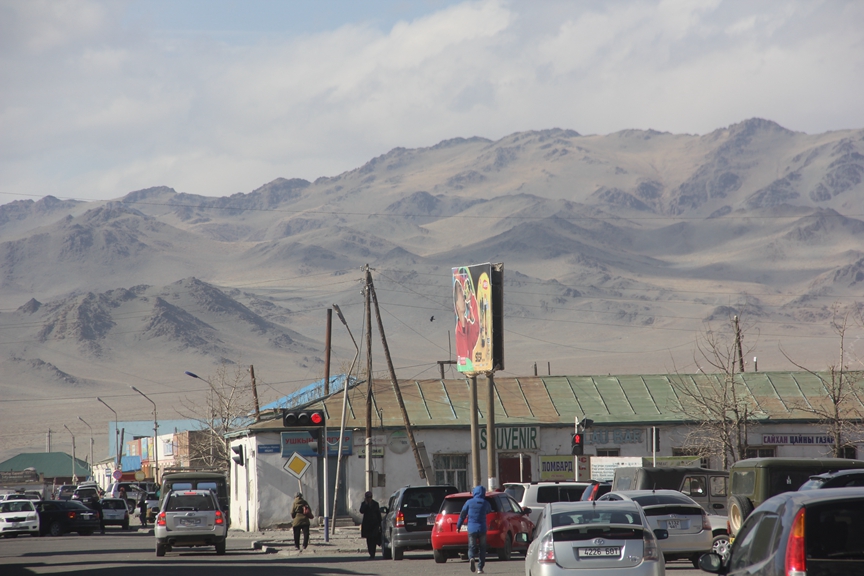 Downtown Olgii. Note that there are not one but two silver Toyota Prii (plural of Prius) in the lower right hand corner of this photo. It’s truly astonishing how popular the Toyota Prius is in Mongolia!
Downtown Olgii. Note that there are not one but two silver Toyota Prii (plural of Prius) in the lower right hand corner of this photo. It’s truly astonishing how popular the Toyota Prius is in Mongolia!
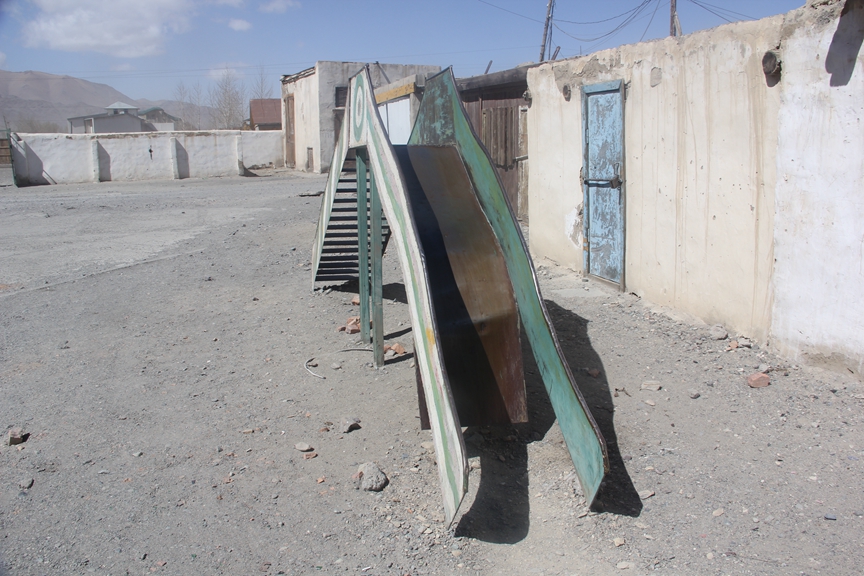 On the way to the bazaar we passed what is surely the world’s most depressing, dilapidated (and dangerous!) Soviet-era children’s slide.
On the way to the bazaar we passed what is surely the world’s most depressing, dilapidated (and dangerous!) Soviet-era children’s slide.
We also passed the offices of the Bayan Olgii Aimag Democratic Party. Mongolia is a multiparty parliamentary republic and has made impressive progress toward instituting a functioning democratic government since the peaceful 1990 Democratic Revolution, which lead to the bloodless overthrow of authoritarian one-party socialist rule during the period of the Mongolian People’s Republic from 1924 to 1992.
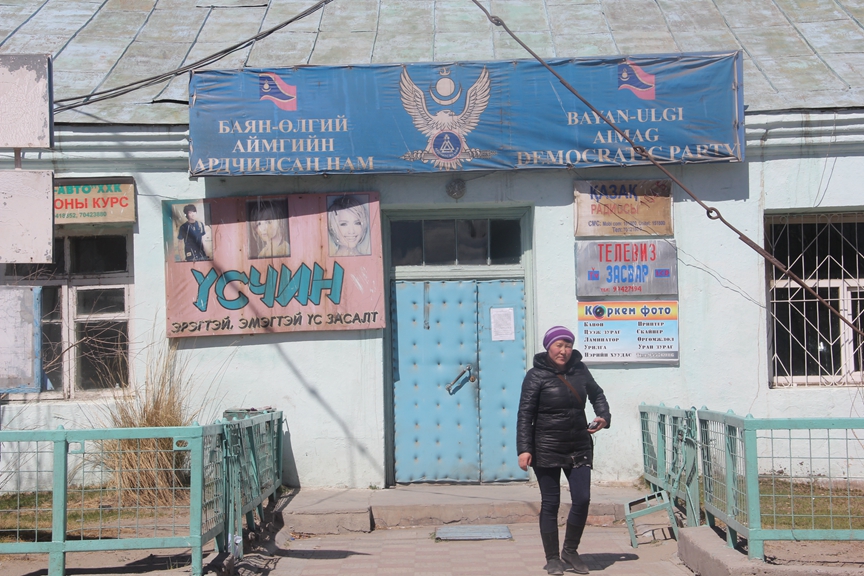 Bayan Olgii Aimag Democratic Party headquarters.
Bayan Olgii Aimag Democratic Party headquarters.
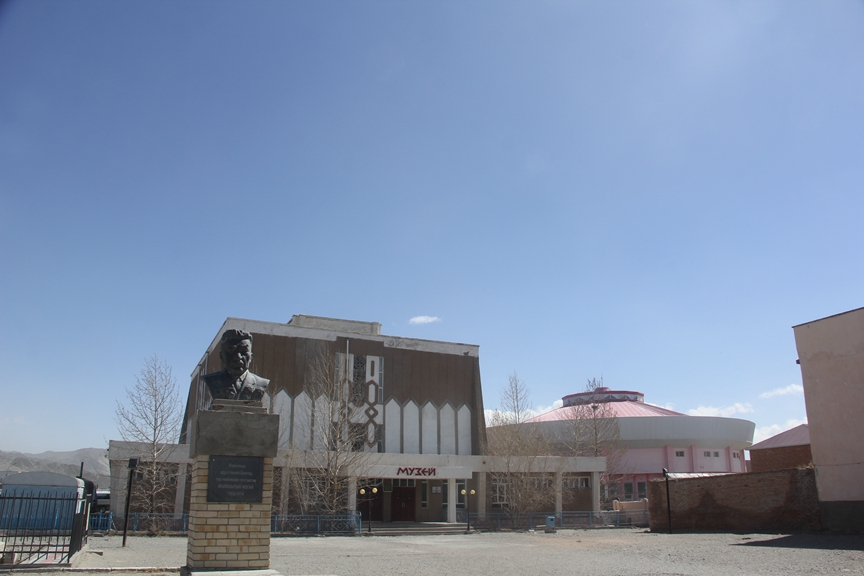 The local museum. We didn’t bother going in.
The local museum. We didn’t bother going in.
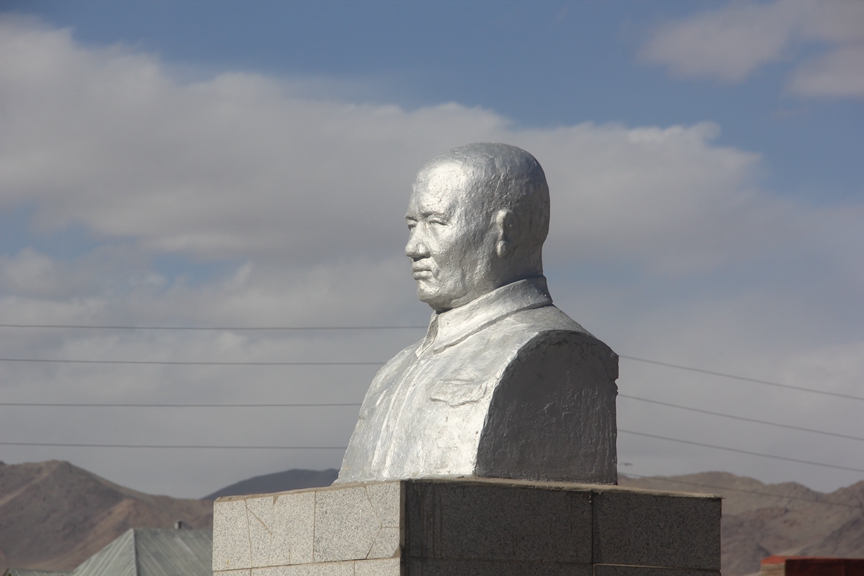 I really love old socialist realist style Soviet era statues. There’s something so austere and formidable about them.
I really love old socialist realist style Soviet era statues. There’s something so austere and formidable about them.
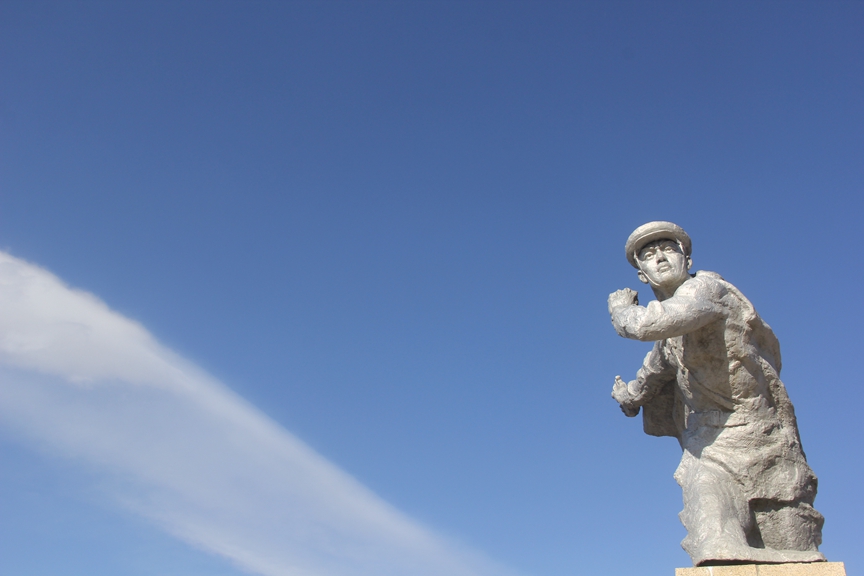 Many Soviet-era statues are overtly and intentionally militant. This one depicts what appears to be a Mongolian war hero of some kind brandishing a revolver.
Many Soviet-era statues are overtly and intentionally militant. This one depicts what appears to be a Mongolian war hero of some kind brandishing a revolver.
 The instruments on display in this photo are called dombra, a two string lute common to the Central Asian “Stan” countries and Turkic regions of Russia. It’s quite similar to the dutar, which is popular among the Turkic Muslim majority of China’s Xinjiang province as well as in Afghanistan and Iran.
The instruments on display in this photo are called dombra, a two string lute common to the Central Asian “Stan” countries and Turkic regions of Russia. It’s quite similar to the dutar, which is popular among the Turkic Muslim majority of China’s Xinjiang province as well as in Afghanistan and Iran.
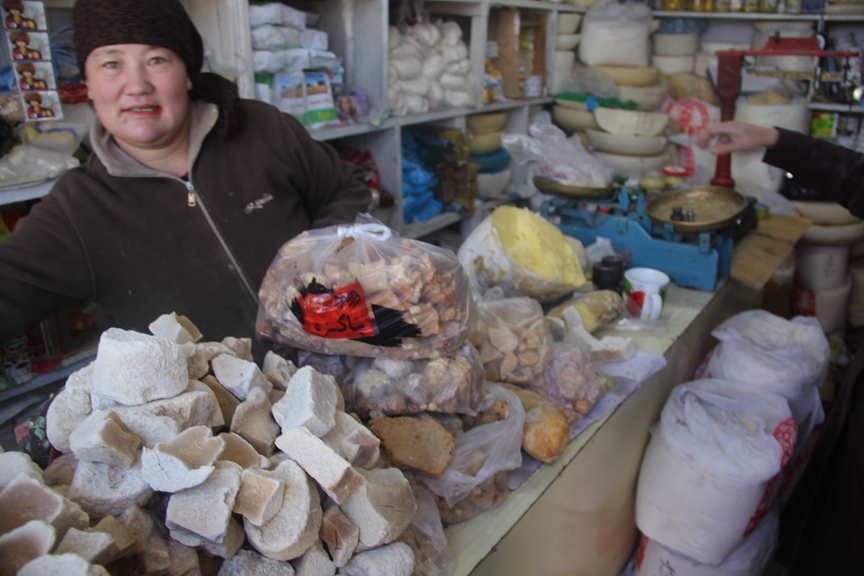 One of the food items we stocked up on were these white chunks of rock-hard goat’s milk curd. You can easily break your teeth on this stuff and it has a very pungent tanginess that takes some getting used to, but it’s an ideal food for energy intensive wilderness activities like trekking and mountain climbing because it’s both compact and high in nutrients.
One of the food items we stocked up on were these white chunks of rock-hard goat’s milk curd. You can easily break your teeth on this stuff and it has a very pungent tanginess that takes some getting used to, but it’s an ideal food for energy intensive wilderness activities like trekking and mountain climbing because it’s both compact and high in nutrients.
 We also stocked up on plenty of meat for added nutrition. I think this is horse but we bought mutton because it was a lot cheaper.
We also stocked up on plenty of meat for added nutrition. I think this is horse but we bought mutton because it was a lot cheaper.
With plenty of provisions, including butane gas for cooking and boiling water, we left Olgii the next morning just after 6. Our driver picked us up in an old Russian UAZ jeep, which I’d travelled in several times before throughout my travels in other parts of Central Asia. The UAZ is a symbol of Soviet era pride that many Russians are still proud of, and rightly so. They are dependable, robust and long lasting vehicles, which is evidenced by their ubiquity across the most rugged and remote parts of Central Asia. Of course, another important reason for their popularity is that they cost a fraction of a Toyota Land Cruiser, but so do Chinese-made jeeps and you hardly see anyone driving them. I dare say a 30 year old UAZ would outperform a brand new Chinese-made contraption any day. But I digress.
 The red line on this map shows the 180 kilometre route we took from Olgii to the entrance of Altai Tavn Bogd National Park.
The red line on this map shows the 180 kilometre route we took from Olgii to the entrance of Altai Tavn Bogd National Park.
The drive from Olgii to the national park was supposed to take about 5 hours but ended up taking closer to 8, including a stop off at our driver’s house for tea. Our driver lived in a small village called Tsengel, located about 70 kilometres east of Olgii, on the way to the national park. With a population of about 2,000, Tsengel is the last major settlement before the national park. The remaining 110 kilometres involved driving entirely off-road over very rough terrain through the remote Tsagaan Gol river valley.
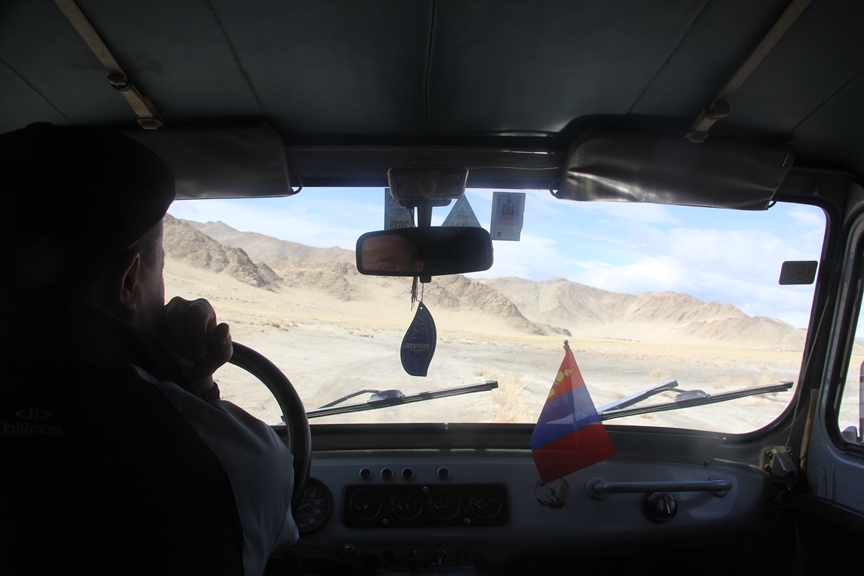 The inside of our UAZ as we drove through the Tsagaan Gol.
The inside of our UAZ as we drove through the Tsagaan Gol.
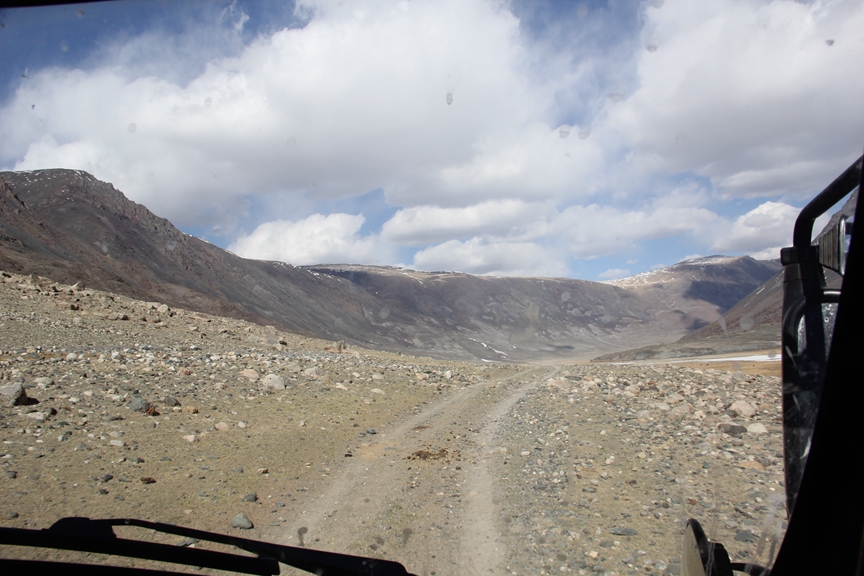 The “road” was quite rough going.
The “road” was quite rough going.
 Like most parts of rural Mongolia, animal husbandry is the main source of livelihood for most inhabitants of Bayan Olgii province, including the few who live in the scenic but extremely remote Tsagaan Gol river valley. There are no electric power lines here or any other kind of industrial infrastructure.
Like most parts of rural Mongolia, animal husbandry is the main source of livelihood for most inhabitants of Bayan Olgii province, including the few who live in the scenic but extremely remote Tsagaan Gol river valley. There are no electric power lines here or any other kind of industrial infrastructure.
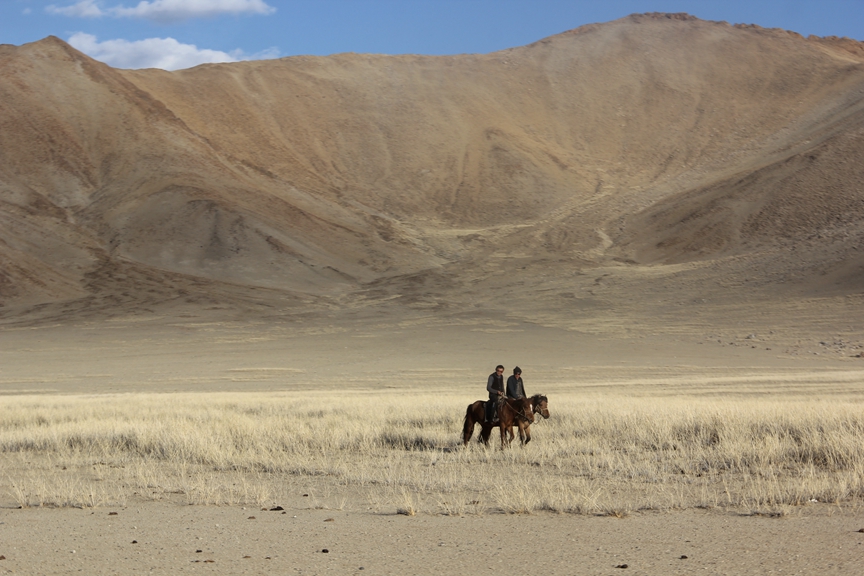 There are also very few automobiles in the valley. We didn’t pass one during the nearly 4 hours we spent driving through it.
There are also very few automobiles in the valley. We didn’t pass one during the nearly 4 hours we spent driving through it.
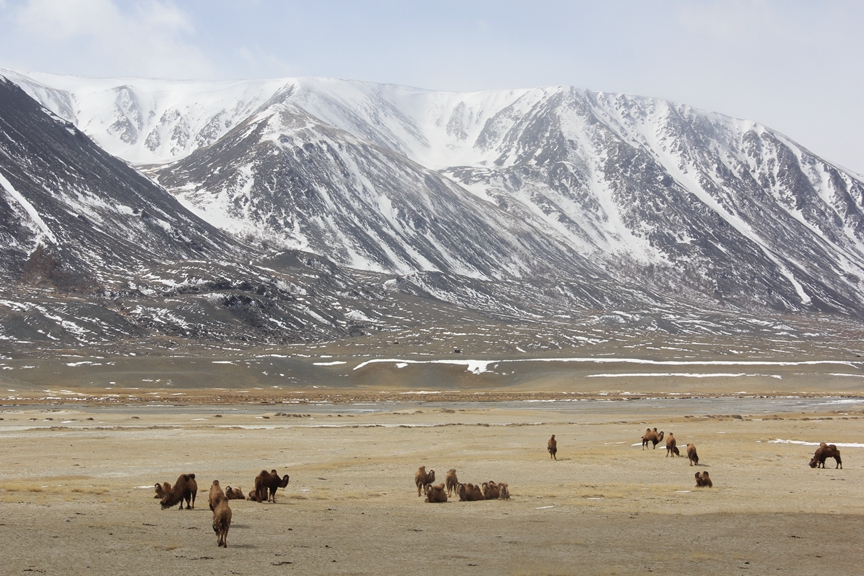 A herd of Bactrian camels in the valley. A common domestic animal in Mongolia, Bactrian camels are extremely hardy beasts, able to withstand both the extreme temperatures of arid desert and steppe climates as well as harsh mountainous terrain.
A herd of Bactrian camels in the valley. A common domestic animal in Mongolia, Bactrian camels are extremely hardy beasts, able to withstand both the extreme temperatures of arid desert and steppe climates as well as harsh mountainous terrain.
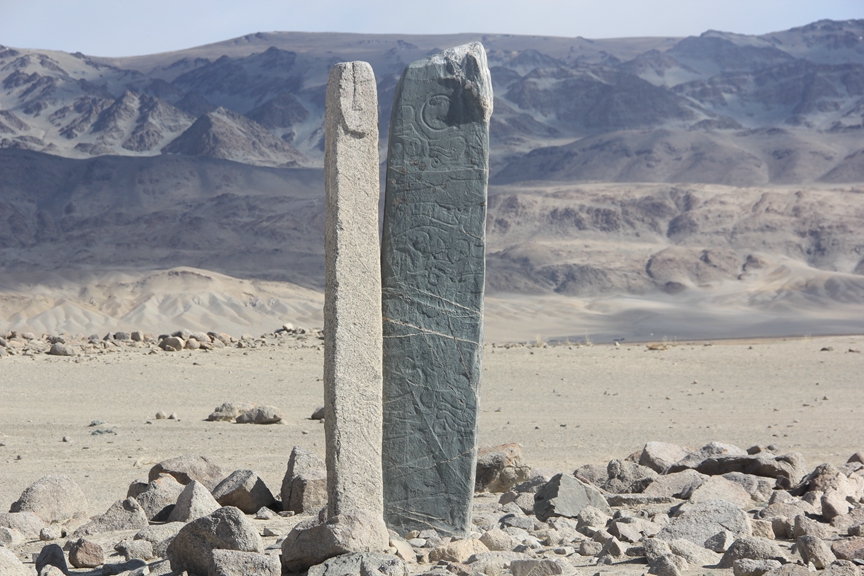 One of the most remarkable sights we saw in the valley were these ancient Kurgan stele or monoliths. These carved anthropomorphic stone slabs mark the grave sites or “kurgan” of the Gokturks, a nomadic confederation of pre-Islamic Turkic peoples originally from medieval Inner Asia who established the Turkic Khaganate in the 6th century CE, a vast empire that spanned the territory of the present day post Soviet independent Central Asian states (the “Stans”) and Mongolia. The Gokturks were practitioners of Tengrism, “a Central Asian religion characterized by features of shamanism, animism, totemism, both polytheism and monotheism, and ancestor worship”.
One of the most remarkable sights we saw in the valley were these ancient Kurgan stele or monoliths. These carved anthropomorphic stone slabs mark the grave sites or “kurgan” of the Gokturks, a nomadic confederation of pre-Islamic Turkic peoples originally from medieval Inner Asia who established the Turkic Khaganate in the 6th century CE, a vast empire that spanned the territory of the present day post Soviet independent Central Asian states (the “Stans”) and Mongolia. The Gokturks were practitioners of Tengrism, “a Central Asian religion characterized by features of shamanism, animism, totemism, both polytheism and monotheism, and ancestor worship”.
Altai Tavan Bogd National Park
Altai Tavn Bogd National Park is the large green patch near the centre of this map along the border with China. Note that the squiggly red line in the middle is the 38 kilometre stretch of border between China and Russia that separates Mongolia from Kazakhstan.
Located in the remote northwestern corner of Bayan Olgii aimag (province), which is in turn located in the remote northwestern corner of Mongolia, Altai Tavan Bogd National Park spans 6362 square kilometers of pristine alpine wilderness right on the border of both Russia and China. The western boundary of the park marks the Chinese border, while the northern boundary marks the Russian border. Tavan Bogd means “Five Saints” in Mongolian and refers to the five highest peaks inside the park, which includes Mongolia’s highest peak, Khuiten Uul (“Cold Mountain”) at 4,376 metres. The summit of Khuiten also marks the Sino-Mongolian border. The “Five Saints” belong to the Altai mountain range of Central Asia, which spans Mongolia, China, Russia and Kazakhstan. In addition to the “Five Saints”, the park also includes several stunning alpine lakes, as well as three areas containing thousands of ancient petroglyphs and Turkic monoliths, which are listed together as a UNESCO World Heritage Site. The park is also home to an abundance of wildlife, including argali (a rare, large-horned species of wild sheep), ibex (a wild goat with long scimitar-shaped horns), deer, moose, wolves, foxes, lynx, brown bears, and even snow leopards. Another attractive feature of the park is the almost complete lack of anthropogenic influence on the landscape; for instance, there are no paved roads, fixed paths or signs. Visitors have to be fully self-sufficient and able to read a topographic map!
We didn’t arrive at the entrance to the park until just after 2pm, which was quite a bit later than we had expected (we had hoped to arrive before noon). Actually, our driver didn’t even drop us at the official entrance to the park, but instead stopped at a local herders wooden cabin, which was located at least 3 kilometres from the park entrance. We didn’t know this at the time, otherwise I would have asked him to drive us right up to the park entrance, since we had paid a king’s ransom for the ride. The main purpose of visiting the park was to try to climb Mongolia’s highest peak, which meant we still had to hike to basecamp. From the park entrance it was a 14 kilometre hike to the basecamp of Khuiten Uul, which we wanted to do that day, so adding a few more kilometres to the hike wasn’t ideal. Since it was already quite late in the day to begin such a hike, I think our driver stopped at the cabin because he expected we would stay a night there and begin our hike the next morning. Dion and I were adamant about leaving as soon as we stepped foot out of the jeep though and even refused an offer of tea with the driver and the residents of the cabin, which in hindsight was probably a bit rude. Just after setting off, I decided to take a couple of things out of my bag, including a small bottle of vodka, to lighten the load a bit, so I walked back to the cabin and asked if I could leave them there, which the owner kindly obliged. Even after shedding 1-2 kg of unnecessary weight though, my bag probably still weighed somewhere between 20-25 kg.
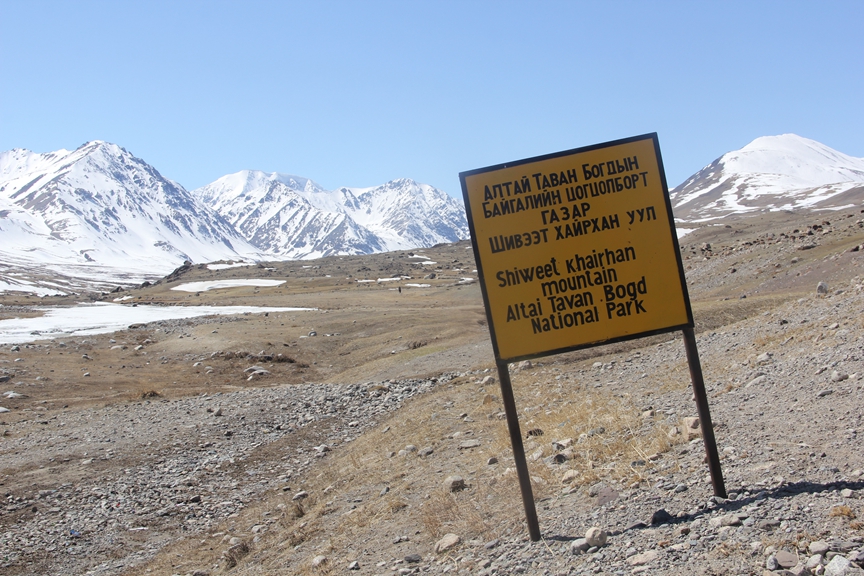 Entrance to Altai Tavn Bogd National Park. There was only this sign to indicate that we were at the entrance of the park, there were no buildings or park staff to greet us. We had to apply for a border permit from the Mongolian military to enter the park, and were told that park rangers or border patrol soldiers inside the park might approach us at any time and ask to see the permit at anytime, but we didn’t see either during the 4 days we were inside the park.
Entrance to Altai Tavn Bogd National Park. There was only this sign to indicate that we were at the entrance of the park, there were no buildings or park staff to greet us. We had to apply for a border permit from the Mongolian military to enter the park, and were told that park rangers or border patrol soldiers inside the park might approach us at any time and ask to see the permit at anytime, but we didn’t see either during the 4 days we were inside the park.
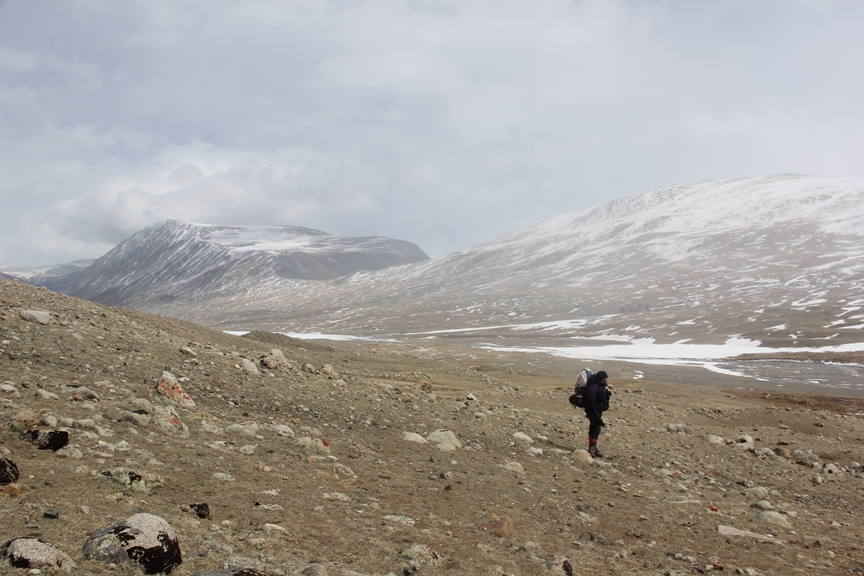 After just a few kilometers, we were really beginning to feel the weight of our packs.
After just a few kilometers, we were really beginning to feel the weight of our packs.
 The scenery was absolutely spectacular!
The scenery was absolutely spectacular!
The snow was quite deep in places, which really slowed us down. It was also slightly frustrating and unnerving because we never knew when we were going to suddenly sink up to our knees or even higher. Some of the snow was hard enough to walk right on top of but you could just as easily sink up to your waist at any given moment; trying to crawl out with our heavy packs was tiresome and time-consuming.
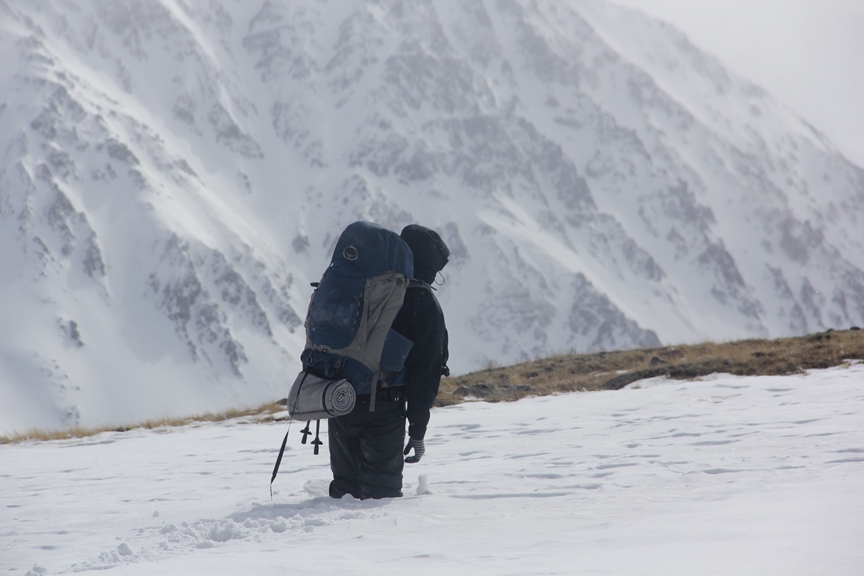 I must have sunk up to my knees like this at least 3 dozen times the first day.
I must have sunk up to my knees like this at least 3 dozen times the first day.
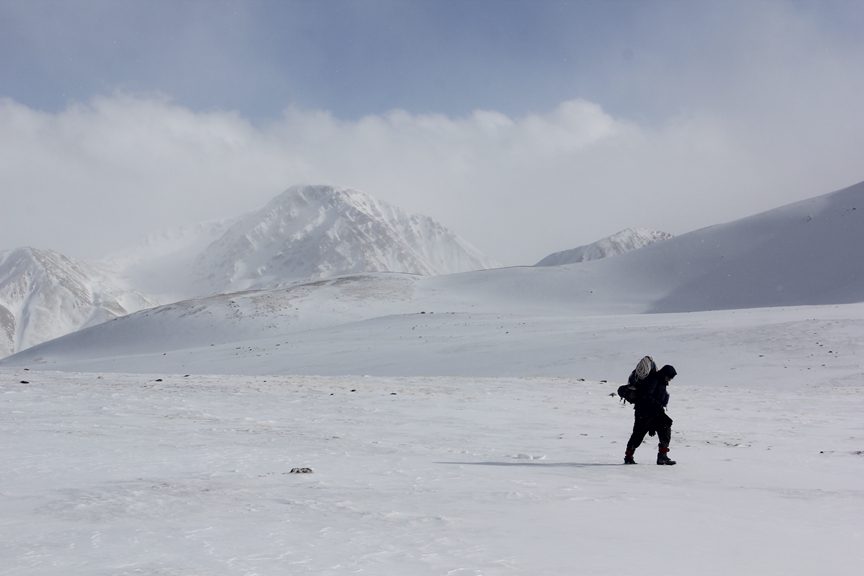 Dion slogging his way across a snow field. Neither of us were quite sure if we were going the right way since there was no path to follow.
Dion slogging his way across a snow field. Neither of us were quite sure if we were going the right way since there was no path to follow.
Luckily I had bought a fairly detailed 1:500,000 scale topographic map of the area at a mountaineering store in Ulaan Baatar called Sevin Summits, which was indispensable for navigating through the park without a guide. There was absolutely no sign of a path anywhere; instead we had to navigate using mountains as landmarks. The owner of Blue Wolf Travel, a travel company and hostel in Olgii, the capital of Bayan Olgii province, had marked the route on our map with a pen but it was still a challenge to navigate because of the size of the area and complete lack of a path or any signage to indicate that we were going in the right direction. We weren’t really afraid of getting lost but we worried that we weren’t taking the most direct route, and didn’t want to waste precious daylight on necessary detours. For instance, when we were crossing a large snow field, I suddenly stepped into a pool of ice-cold water hidden beneath the snow, completely submerging my boot. Shocked, I looked around and quickly realized that I had come to a large swathe of still, shallow water. I tried to go around it but discovered to my dismay that the water stretched for at least a kilometer to my left and right. I could see that it was only about 30 metres across though, so I decided to try my luck and walk as nimbly as I could over patches of ice and snow. Unfortunately, this didn’t really work and I ended up sinking into the water at least every other step. If there had been a clearly marked path though, I probably wouldn’t have stumbled into this predicament. Thankfully, my gore-tex lined mountaineering boots are fairly water-resistant, so my feet stayed relatively dry, although my boots froze solid that night. Dion had earlier decided to take a longer route across the snow field, so he didn’t have the same problem, but his detour added about an hour to his hike.
Once I was back on dry land, I quickly found a patch of grass to pitch our tent. It was already after 7 and we had been hiking for 5 hours straight, with the exception of a few 5 minute water breaks. Dion and I had agreed earlier to stop hiking by 7pm so that we would have enough time to pitch our tent and make camp before sunset. It was the end of April and we were at an altitude of about 3,000 metres, so the temperature really began to dip once the sun began to set. It was also very windy, so the wind chill made it feel quite a bit colder. In fact, our first night in the park was much colder than expected. I had a down sleeping bag that’s supposed to keep me comfortably warm down to minus 10 Celsius (and alive at – 20), so I thought it would be fine to just sleep in my long underwear, but I was wrong. The temperature was at least 10 degrees during the day in the sun, but it dropped well below – 10 at night, so I had to get up in the middle of the night and put on all my layers to keep warm, which was a bit of a nuisance. My discomfort was also compounded by a chest cold that was getting worse, to the point where I worried that I may not be well enough to climb the mountain.
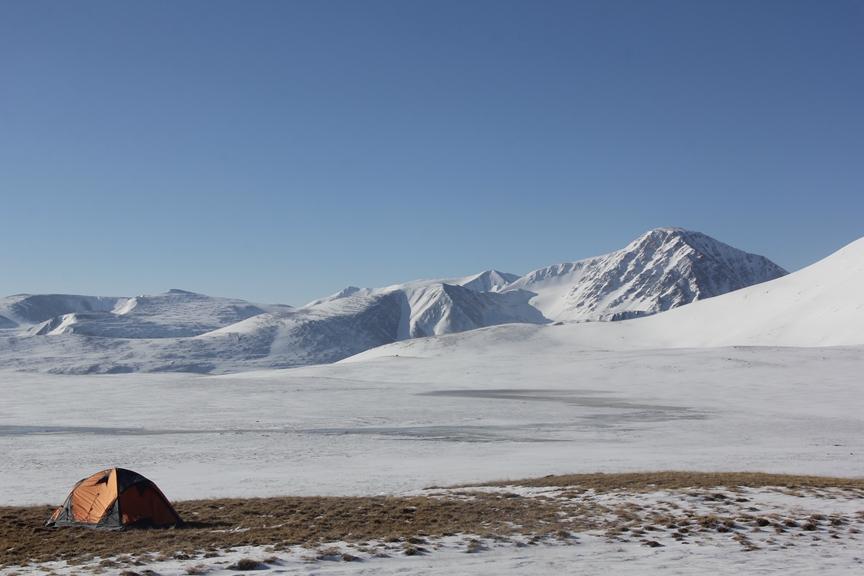 Our camp site on the first day. You can see the large, meandering swathe of shallow water in the background. The water was frozen solid when we woke up the next morning but this photo was taken at about 10am, so the sun was already beginning to melt the ice.
Our camp site on the first day. You can see the large, meandering swathe of shallow water in the background. The water was frozen solid when we woke up the next morning but this photo was taken at about 10am, so the sun was already beginning to melt the ice.
We decided to sleep in a bit the first morning and take our time packing up because we thought we only had a short hike ahead of us to reach basecamp. Once again, we were wrong. It took another 6 hours of nonstop hiking before we finally reached basecamp early that evening, which was somewhere between two to three times longer than we had expected. Part of this was because of the snow. Deep snow in many areas had slowed us down considerably and concealed any sign of a foot path that would have offered a more direct route. Instead, we had to more or less wing it with the help of the map. Again, we knew were going in the right general direction but had to occasionally readjust our route, which involved quite a bit of meandering and even backtracking.
 The scenery was even more spectacular on the second day!
The scenery was even more spectacular on the second day!
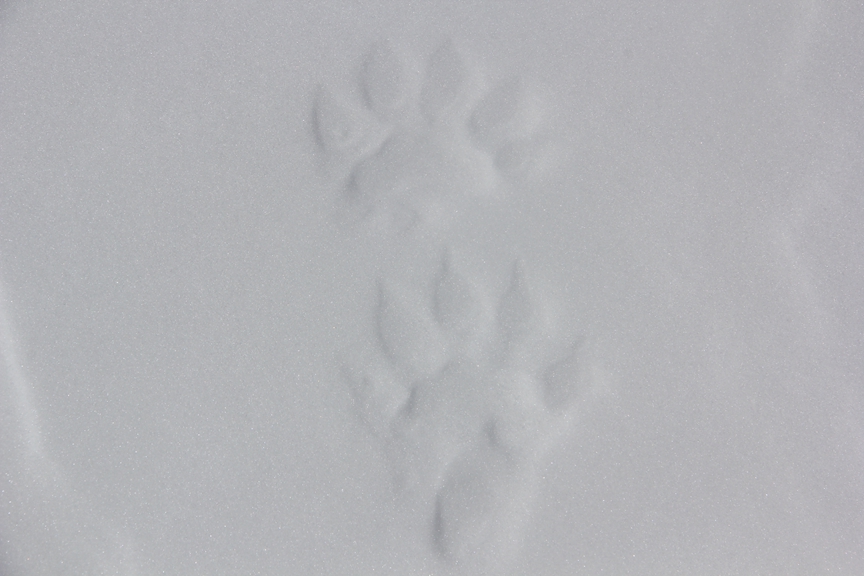 We even saw fresh bear tracks, which added to the excitement of being in a pristine alpine wilderness.
We even saw fresh bear tracks, which added to the excitement of being in a pristine alpine wilderness.
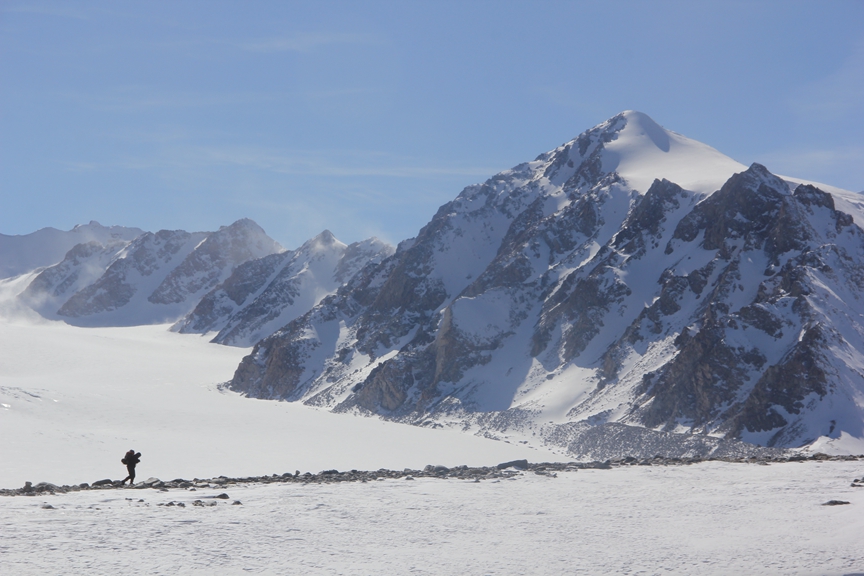 Dion walking on top of a moraine next to the 22km long Potaniin glacier, which leads to the foot of Khuiten Uul.
Dion walking on top of a moraine next to the 22km long Potaniin glacier, which leads to the foot of Khuiten Uul.
 A good vista of Khuiten Uul. The cairn on the lower left of the photo is just above basecamp.
A good vista of Khuiten Uul. The cairn on the lower left of the photo is just above basecamp.
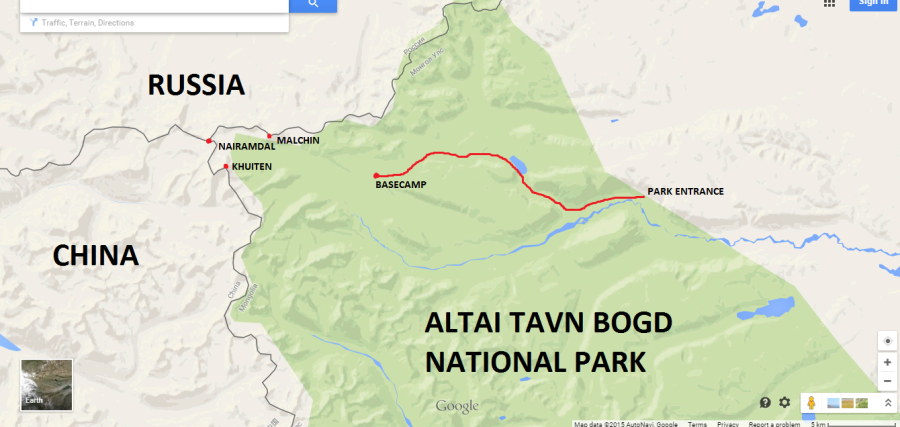 The red line shows the rough route we took from the entrance of the park to basecamp. The three main peaks in the park, Khuiten, Nairamdal and Malchin are marked with red dots at the top right corner of the park, along the borders of China and Russia. Nairamdal, which means “Friendship” in Mongolian actually marks the border of all three countries, while Malchin borders Russia and Khuiten borders China.
The red line shows the rough route we took from the entrance of the park to basecamp. The three main peaks in the park, Khuiten, Nairamdal and Malchin are marked with red dots at the top right corner of the park, along the borders of China and Russia. Nairamdal, which means “Friendship” in Mongolian actually marks the border of all three countries, while Malchin borders Russia and Khuiten borders China.
We arrived at basecamp at about 6pm. The hike had been quite pleasant for most of the day, but as my bad luck would have it, I ended up stepping into another pool of ice water, this time completely submerging my boots and soaking my feet. It happened at about 5 pm, just as we were about to take a break. Dion had suggested the break and was about to sit down when I pointed to a large rock about 20 metres ahead and suggested that we sit there instead. Big mistake. Just a few metres before I arrived at the rock, I suddenly sank up to my thighs in snow, at which point I immediately felt a surge of icy water flood into my boots. There was nothing the goretex lining on my boots could do to protect my feet in that much water, which went up to my knees. I quickly jumped out of the water but my feet were already sopping wet. All I could do was take my boots off, wring out my socks and put a new pair on. Unfortunately, the new pair got soaked almost as soon as I put my boots back on because the insides were so wet. I had to continue hiking in soaking wet boots for another hour, which wasn’t as bad as I had anticipated. My feet actually warmed up quite a bit after the initial soaking, but when we arrived at basecamp, they quickly cooled down, to the point that I was worried I might get frostbite during the night if I couldn’t warm them back up. I didn’t have any more dry socks at that point, so I wasn’t sure if I would be able to keep my feet warm enough in my sleeping bag. My boots were also completely soaked and froze solid again that night.
We knew we had arrived at basecamp when we stumbled upon a small pile of bottles and tin cans, and spotted a small hut a few hundred metres away. On closer inspection, we realized that the hut, which was well constructed and looked brand new, was actually an outhouse. It turns out that it had actually been built with funds from the EU, which in my mind is a good use of development aid. It may only represent a very modest contribution to Mongolia’s development, but a simple outhouse can have the effect of promoting responsible eco-tourism, which is good for the local economy and environment. It also served another unintended, yet no less beneficial, purpose for us. While we were trying to pitch our tent a few hundred metres from the outhouse the wind was really raging, which made the task quite difficult. Suddenly, a light bulb went off in Dion’s head and he suggested that we try to sleep in the outhouse! Contrary to popular beliefs about outhouses and past experiences with them throughout my travels in the developing world, this outhouse was actually very clean. In fact, it didn’t even smell like an outhouse. This was mainly due to the fact that it was brand new but also because whatever excrement was at the bottom of it (I don’t think there was much) was completely frozen and buried by a deep blanket of snow that had blown into it. Since it was so clean, we figured it would make a more comfortable, sturdy and convenient shelter than our tent. The only thing it required was a bit of wind-proofing, which we accomplished by tying the panels of our tent to the outside of it.
 Dion boiling a pot of water on our portable butane stove inside the outhouse. Notice how hard the wind is blowing by the concave shape of the tent behind his head.
Dion boiling a pot of water on our portable butane stove inside the outhouse. Notice how hard the wind is blowing by the concave shape of the tent behind his head.
The outhouse, which we later called our “toilet bivy”, actually made for a surprisingly comfortable shelter, even more so than our tent because it was much more spacious and easier to enter and exit. It wasn’t warm by any means and probably wasn’t as windproof as our winter tent, but we slept comfortably enough given the subzero temperatures at night. Fortunately, Dion lent me a pair of socks, so my feet didn’t freeze and I was even able to dry my wet socks by putting them at the bottom of my sleeping bag while I slept. My boots, on the other hand, were completely frozen the next morning and became soaked when they thawed out in the sun, so it took several more hours before they were dry enough to wear.
Originally, we had planned to spend one night in the outhouse then hike up to advanced basecamp (ABC), which was on top of the Potaniin glacier right at the foot of the mountain. We were told that it was a 5 hour hike from basecamp to ABC then another 6 hours of climb from ABC to the summit of Khuiten Uul, so we planned to hike up to ABC on the third day, pitch our tent, then wake at 3am on the fourth day and try for the summit. If all went according to plan, we would be back safely at basecamp at 2pm on the fourth day. Unfortunately, not much had gone according to plan during our time in Mongolia. The wind had howled relentlessly during our second night in the park and hadn’t let up on the morning of the third day, so we were reluctant to try to pitch our tent at ABC, where it was sure to be far windier. My soaking wet boots were another problem but even worse were the massive blisters they had caused on my heels.
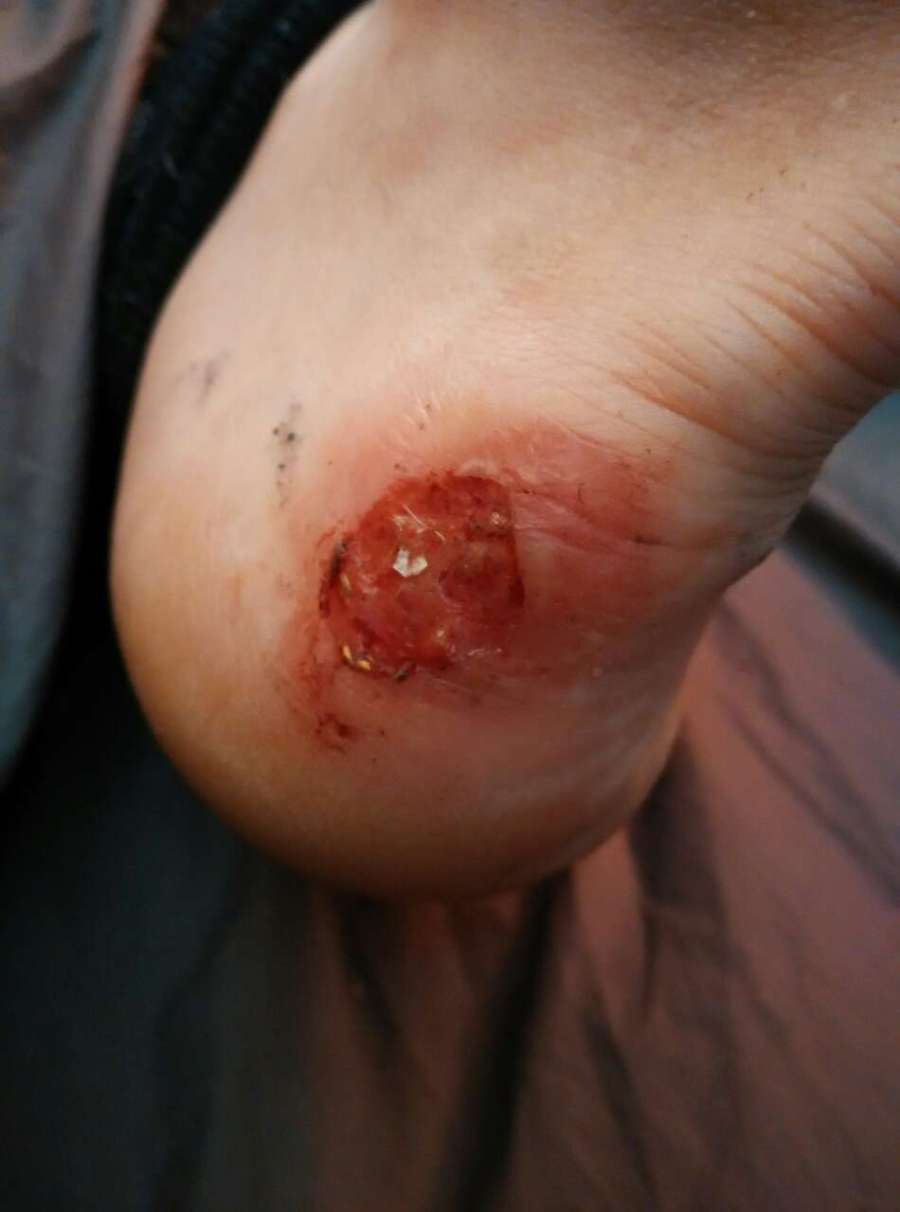 Both my heels looked like this.
Both my heels looked like this.
I had tried to protect my heels with gauze but this did very little to prevent them from rubbing very painfully against the inside of my boots. By the end of the second day in the park, my blisters had transformed into bleeding open wounds and I could barely sleep that night because of the pain. I had recently bought my first pair of proper mountaineering boots and this was my first time wearing them, so I was expecting to get blisters, but nothing that bad. The main concern, though, was the wind. We both agreed it would be a good idea to wait one more day for the wind to die down before pitching camp at ABC and attempting the summit, so we decided to stay at basecamp another night.
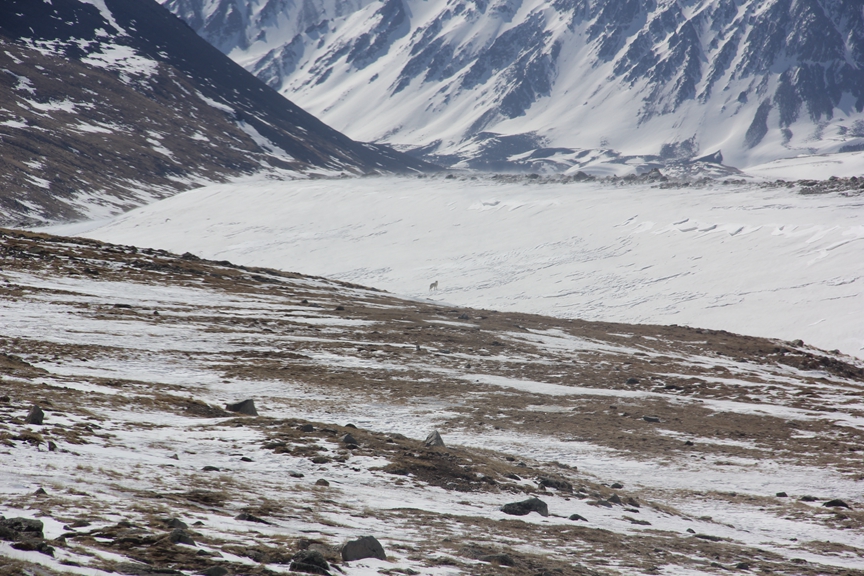 We spotted this grey wolf (centre of photo where snow field meets grass) from the outhouse on the morning of our third day in the park, which was very exciting! It was running in the distance then suddenly stopped to look at us for a moment, before continuing up over the moraine on the right and out of sight.
We spotted this grey wolf (centre of photo where snow field meets grass) from the outhouse on the morning of our third day in the park, which was very exciting! It was running in the distance then suddenly stopped to look at us for a moment, before continuing up over the moraine on the right and out of sight.
We hung out at basecamp all morning on the third day but started getting pretty antsy by noon, so decided to scope out the route to ABC and see what conditions were like on the glacier, which we needed to cross to get to ABC and onto the mountain. When we were in the provincial capital Olgii waiting for military border permits to enter the park, the owner of Blue Wolf Travel told us that he heard it had snowed heavily in the park about 10 days prior. He warned us this would probably make crossing the glacier more difficult and dangerous, so we thought it would be a good idea to use our day off to do some reconnaissance before attempting to hike to ABC with all our gear. We also wanted to judge if it would be feasible to bypass camping at ABC entirely and instead hike directly from basecamp to ABC carrying only small day packs and then push for the summit the same day. We had read reports online from previous climbers of Khuiten Uul that camping at ABC wasn’t necessary. Instead, they suggested going directly from basecamp to the summit in one day. However, according to the estimated times we had been told it takes to hike from basecamp to ABC (5 hours), then climb from ABC to the summit (6 hours), we thought it would be prudent to first see for ourselves what conditions were like on the route to ABC. In addition to hiking and climbing 11 hours in a single day from basecamp to the summit, it would take an estimated 5 hours to get back down to basecamp as well, for a total of 16 hours of continual hiking and climbing, which would make for a very long and exhausting day! If the wind didn’t die down by the next day though, we reasoned that this is what we would have to attempt, since trying to camp at ABC in high wind seemed like an even less attractive idea. We decided that if the route to ABC was good and we made it there quickly, we would come back to basecamp and wait to see if the wind died down that night; if it did, we would hike to ABC with our gear the next day, pitch our tent, and try for the summit early the next morning. However, if the wind did not die down that night, we decided to just wake up at 3 am the next morning and try for the summit directly from basecamp.
We set out at about 2pm with a full bottle of water each (750 ml) and some nuts. The weather was great, so we were in high spirits. My heels hurt like hell at first, but I became numb to the pain after about 2 hours.
 A dramatic view of the moraine in front of the Potaniin glacier, with snow and ice-covered peaks behind.
A dramatic view of the moraine in front of the Potaniin glacier, with snow and ice-covered peaks behind.
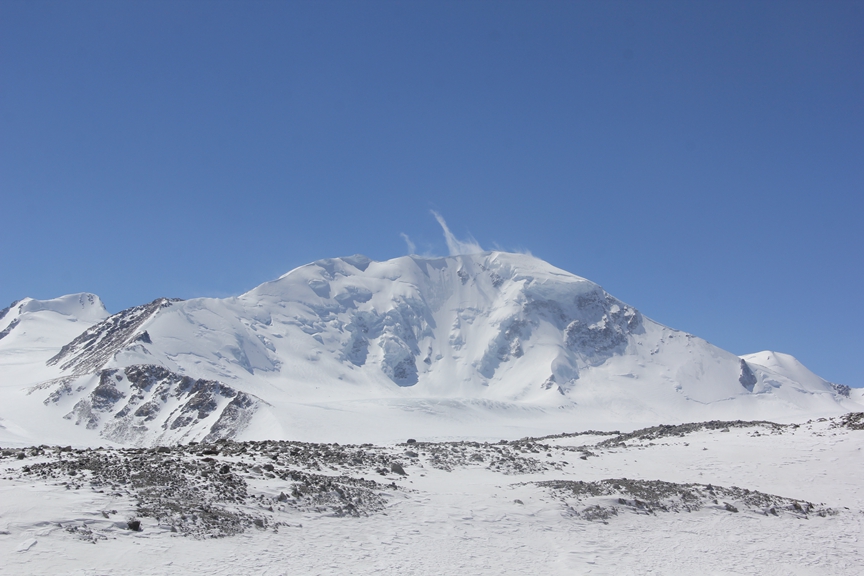 Seeing large plums of snow blow off the summit of Khuiten like this wasn’t encouraging. The amount of snow covering the mountain was also a concern. Snow usually only covers the top third of the mountain during summer, which is when most people attempt to climb it.
Seeing large plums of snow blow off the summit of Khuiten like this wasn’t encouraging. The amount of snow covering the mountain was also a concern. Snow usually only covers the top third of the mountain during summer, which is when most people attempt to climb it.
After an easy to moderate 2 hour hike along a foot path that ran beside the moraine of the Potaniin glacier, we came to the base of a 4,050 metre peak called Malchin, which is right on the border of Mongolia and Russia. At that point, the path disappeared and the terrain became increasingly difficult to traverse, with deeper snow and bigger rocks to contend with.
 Dion standing at the foot of Malchin.
Dion standing at the foot of Malchin.
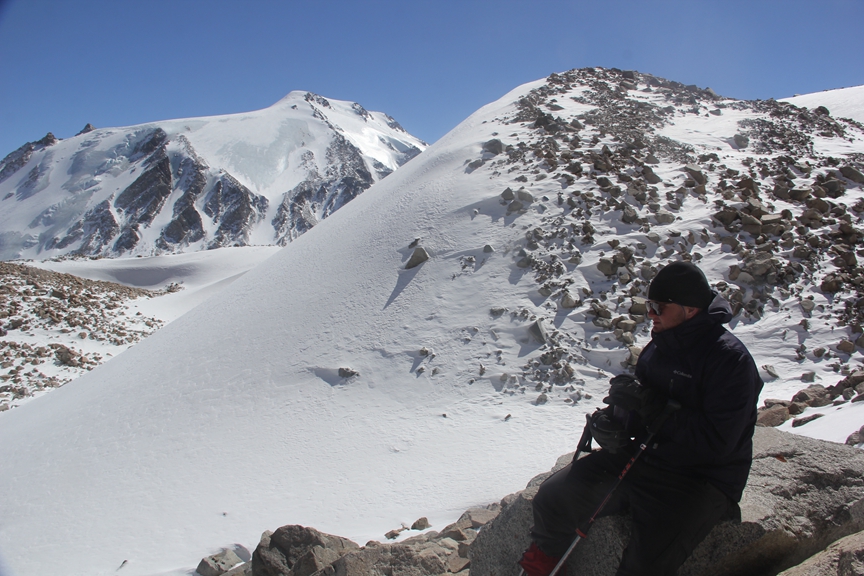 Taking a much-needed water break.
Taking a much-needed water break.
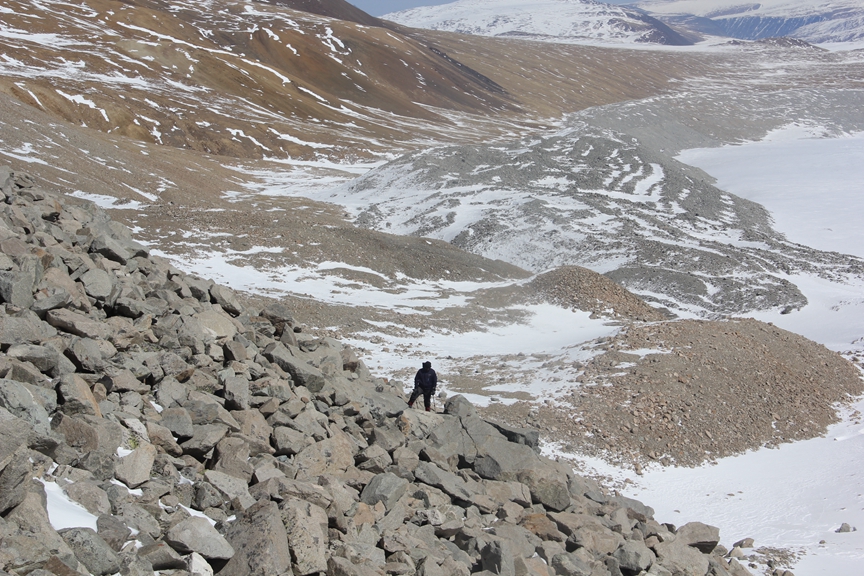 We walked along the foot of Malchin for about an hour, between the moraine (grey rock on right, just to left of glacier) and the pile of rocks that Dion is standing on in this photo. Eventually, the snow became too deep at the foot of the mountain, so we decided to try to walk up along the side of the mountain instead.
We walked along the foot of Malchin for about an hour, between the moraine (grey rock on right, just to left of glacier) and the pile of rocks that Dion is standing on in this photo. Eventually, the snow became too deep at the foot of the mountain, so we decided to try to walk up along the side of the mountain instead.
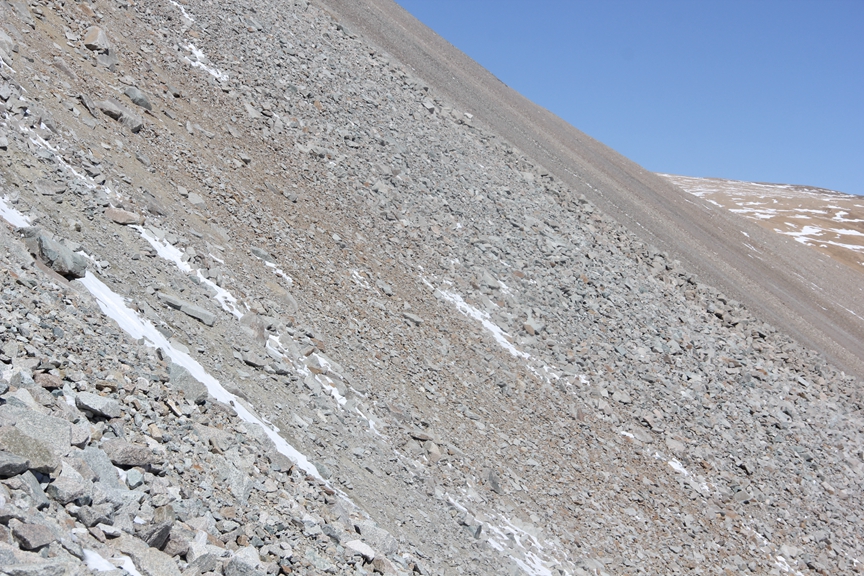 I walked across this section of scree, which was difficult and dangerous, because I thought it would be faster than walking at the foot of the mountain, where deep snow had accumulated. Dion followed me for a while but soon thought better of it and walked back down to the base of the mountain, which was slower but probably a better decision. I certainly did not enjoy walking this section, even though it saved me a bit of time.
I walked across this section of scree, which was difficult and dangerous, because I thought it would be faster than walking at the foot of the mountain, where deep snow had accumulated. Dion followed me for a while but soon thought better of it and walked back down to the base of the mountain, which was slower but probably a better decision. I certainly did not enjoy walking this section, even though it saved me a bit of time.
 This turned out to be the most difficult and dangerous section of the route. By this point we had almost thrown in the towel. The path had long since ceased to exist and we started to doubt that we would ever be able to make it to ABC in the estimated 5 hours that we were told it took to reach it from basecamp. I really wanted to get on top of the glacier though, both to get a view of ABC and try to judge how long it would still take to get there, and also see if it would even be possible given how much snow was on the glacier. From this point onwards, difficult hiking gave way to dangerous climbing.
This turned out to be the most difficult and dangerous section of the route. By this point we had almost thrown in the towel. The path had long since ceased to exist and we started to doubt that we would ever be able to make it to ABC in the estimated 5 hours that we were told it took to reach it from basecamp. I really wanted to get on top of the glacier though, both to get a view of ABC and try to judge how long it would still take to get there, and also see if it would even be possible given how much snow was on the glacier. From this point onwards, difficult hiking gave way to dangerous climbing.
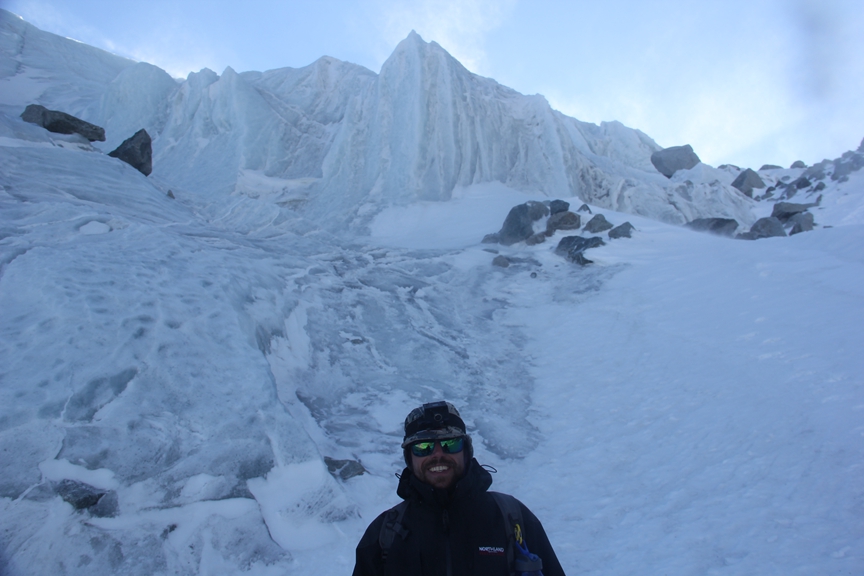 Towering above me are large seracs, huge chunks of ice hanging off the side of the glacier. I was smiling because it was exciting to be there but it was also extremely unnerving to stand directly underneath such massive columns of ice.
Towering above me are large seracs, huge chunks of ice hanging off the side of the glacier. I was smiling because it was exciting to be there but it was also extremely unnerving to stand directly underneath such massive columns of ice.
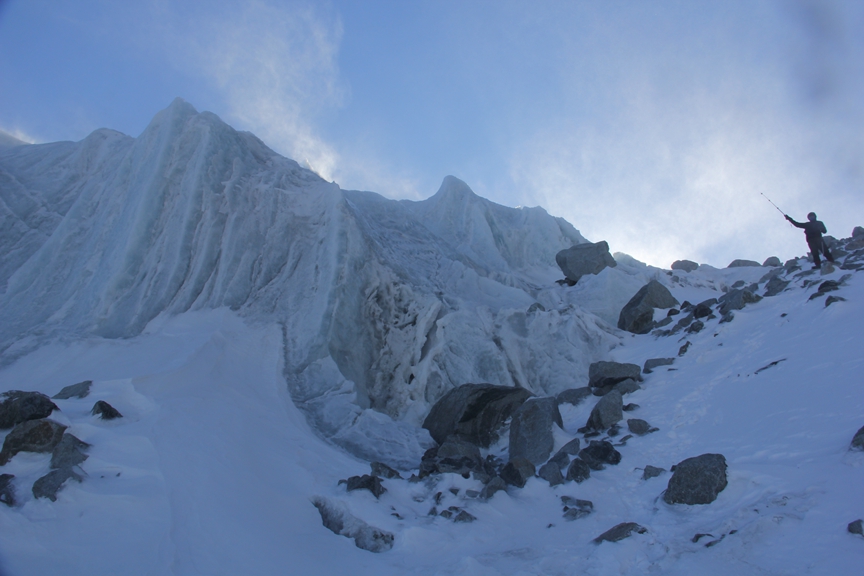 The route was fraught with danger from objective hazards like falling rocks and seracs, which can come tumbling down and crush a person at any moment.
The route was fraught with danger from objective hazards like falling rocks and seracs, which can come tumbling down and crush a person at any moment.
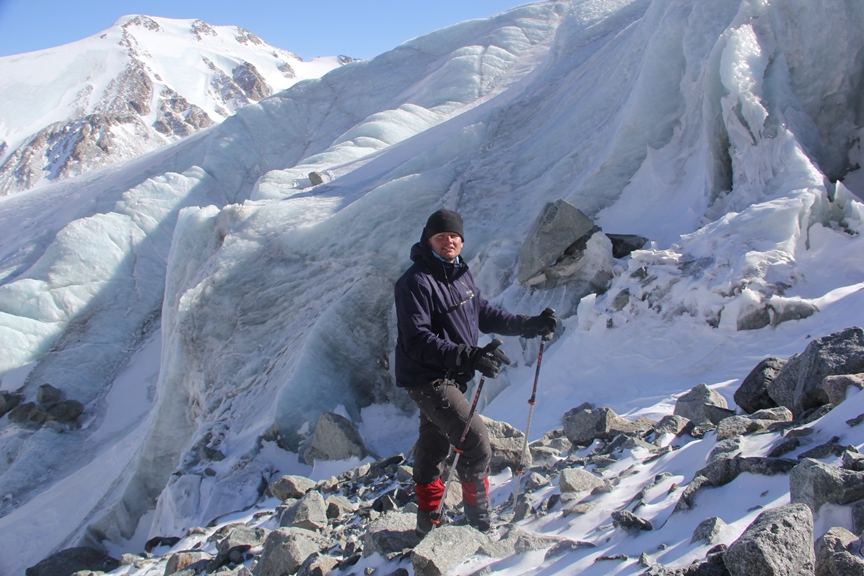 We felt a lot safer once we were higher up the glacier and no longer standing directly underneath seracs and giant boulders resting precariously on the ice, but there was still plenty of danger to worry about.
We felt a lot safer once we were higher up the glacier and no longer standing directly underneath seracs and giant boulders resting precariously on the ice, but there was still plenty of danger to worry about.
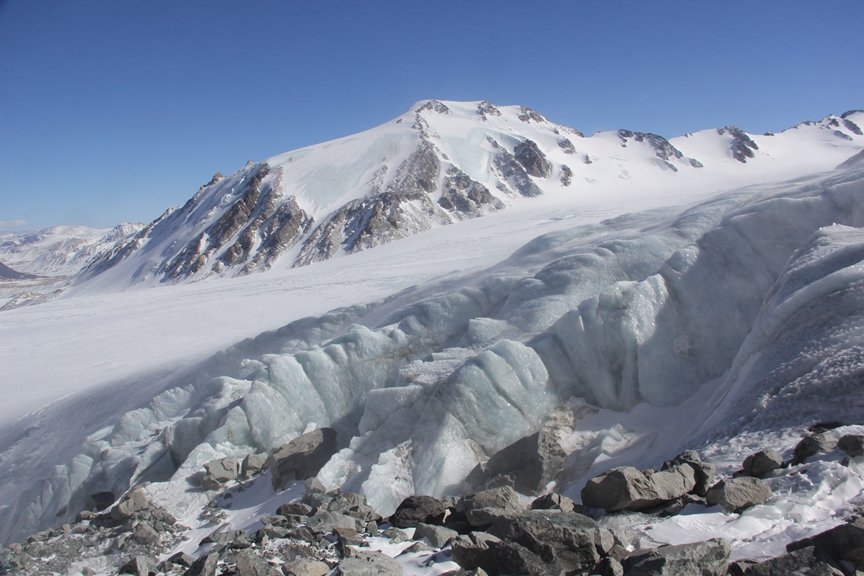 The undulating waves of ice on the glacier were stunningly beautiful.
The undulating waves of ice on the glacier were stunningly beautiful.
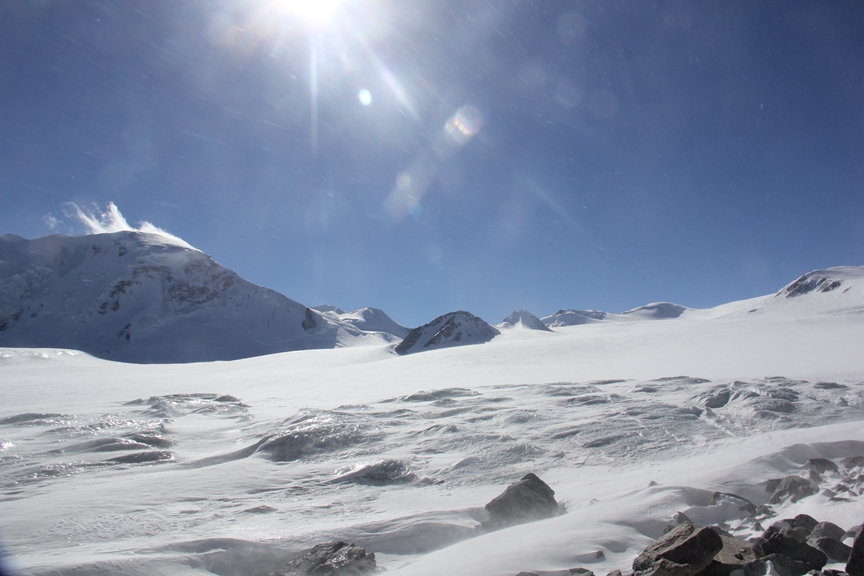 Once on top of the glacier we could finally see ABC, which is just behind the low dark hill in the centre of this photo.
Once on top of the glacier we could finally see ABC, which is just behind the low dark hill in the centre of this photo.
It should have been just a short hike across the glacier to ABC but deep snow made the prospect of crossing the glacier extremely risky. The danger of falling into deep hidden crevasses was very real and deadly serious. We had read reports online from past climbers who said they had passed several crevasses on their way to ABC and they warned other climbers to be very careful of them when crossing the glacier. However, the problem for us was that we simply had no way of knowing where the crevasses were because of the fresh blanket of snow covering the glacier. Most people who attempt to climb Khuiten do so from July to September when most of the snow on the glacier has melted, which, of course, makes the crevasses much more visible and easier to avoid falling into. Unfortunately, we were attempting to climb it in late April, when there was still plenty of snow.
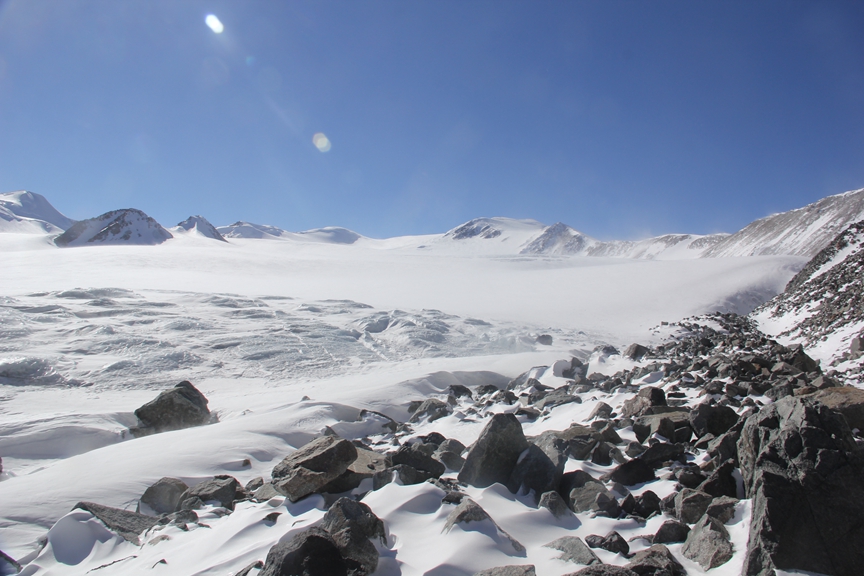 The ridge on the right side of this photo marks the Russian border. The low-lying peak at the end of the ridge (just right of centre) is the 4,180 metre Nairamdal Peak, which marks the tripoint border of Mongolia, China and Russia. ABC is just behind the closest dark peak on the left side of the photo.
The ridge on the right side of this photo marks the Russian border. The low-lying peak at the end of the ridge (just right of centre) is the 4,180 metre Nairamdal Peak, which marks the tripoint border of Mongolia, China and Russia. ABC is just behind the closest dark peak on the left side of the photo.
The red line in this satelitte image indicates the route we took from basecamp to where we stopped on the edge of the upper reaches of Potaniin glacier. Red dots also mark Advanced Basecamp (ABC), Malchin peak, which is right on the Russian border, Nairamdal peak, which is mentioned above, and Khuiten, which is right on the Chinese border.
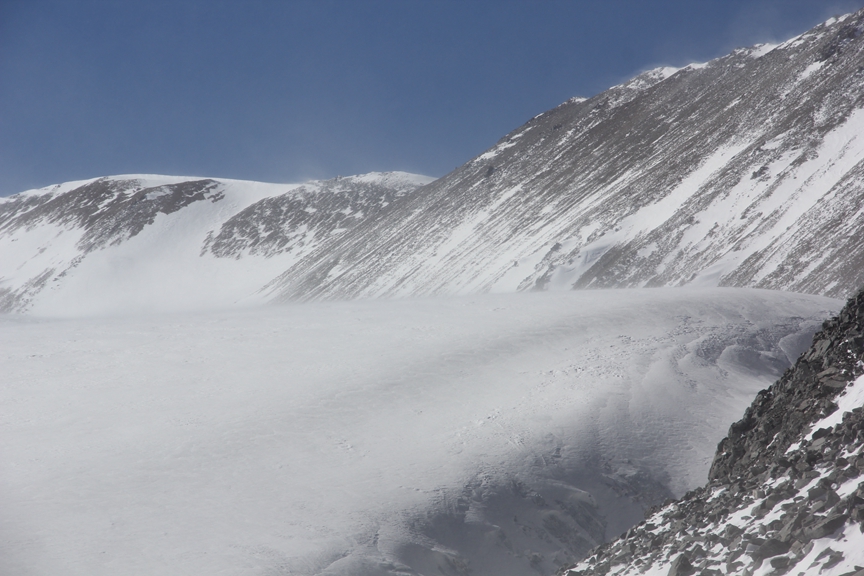 Close up of the glacier and Russian border at top of the ridge. Note how much snow is on the glacier.
Close up of the glacier and Russian border at top of the ridge. Note how much snow is on the glacier.
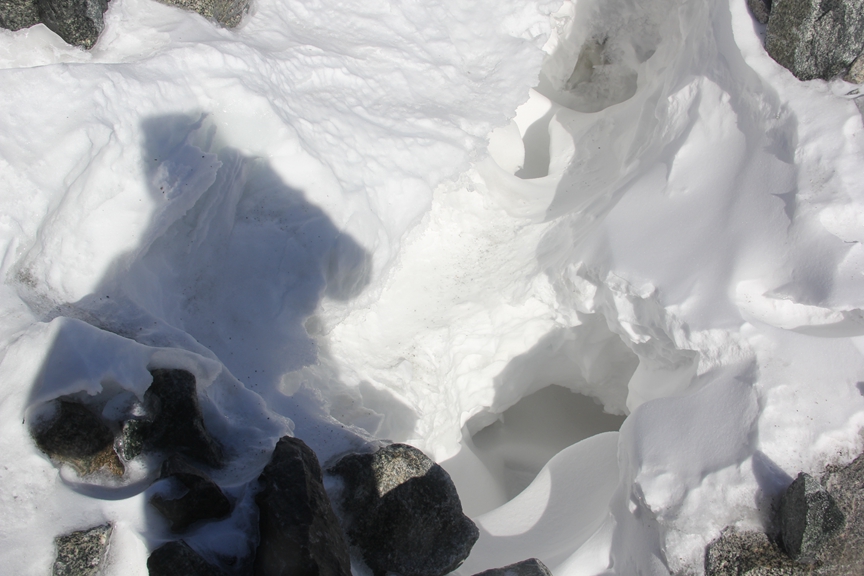 Holes in the snow exposing a deep crevasse. I didn’t want to get any closer, so this photo doesn’t show how deep the crevasse goes, but suffice it to say I couldn’t see the bottom.
Holes in the snow exposing a deep crevasse. I didn’t want to get any closer, so this photo doesn’t show how deep the crevasse goes, but suffice it to say I couldn’t see the bottom.
No sooner than I had finally stepped foot up on top of the edge of the glacier, I very nearly fell into a crevasse. I had gone ahead of Dion, which in hindsight was a stupid idea, and was traversing a small section of rock and snow, when I noticed that there were deep holes in the snow less than a metre to my right. On closure inspection, I could see that they were the opening to a deep crevasse, so deep that I couldn’t see the bottom of it. At this moment, I finally realized that crossing the glacier in such conditions was tantamount to playing Russian Roulette. I was very much shaken by having come so close to falling into a crevasse. If there hadn’t already been holes in the snow, which exposed its presence, I very well could have stepped on the snow covering it and fallen into the abyss.
 A good close up shot of Khuiten.
A good close up shot of Khuiten.
It should have been a straight forward 6 hour climb up the north ridge to the summit but the extreme risk of falling into a crevasse while crossing the glacier was simply not worth taking. It was very difficult to turn back, though. We had spent 9 days just trying to get to this point but knew we had to retreat. It simply would have been suicide to keep going.
 Disappointingly, this was as close as we got to Khuiten on this trip.
Disappointingly, this was as close as we got to Khuiten on this trip.
It had taken us a good 4 hours to get onto the top of the glacier, which meant we had to move fast in order to make it back to basecamp before dark. Heading back down the steep section of the glacier was just as nerve-racking as ascending it, probably even more so.
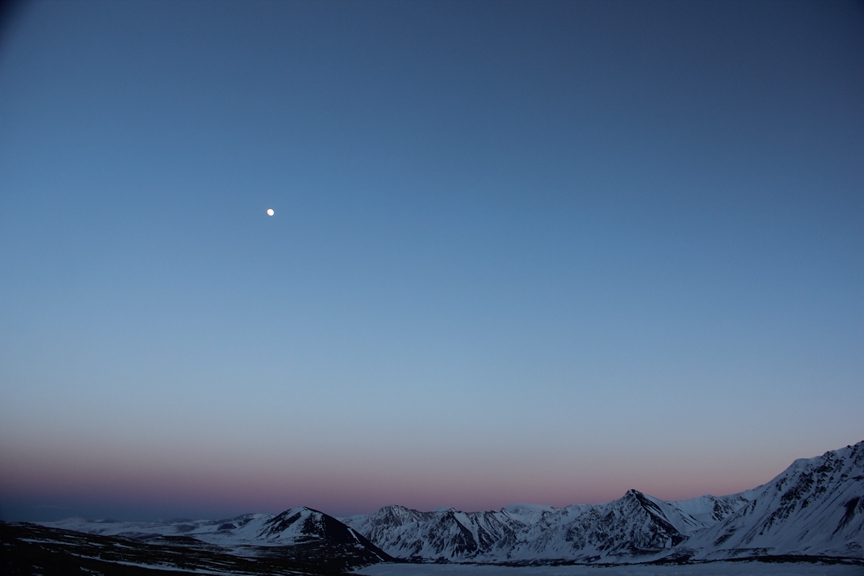 It was a mild consolation to see such a beautiful sunset after a long and disappointing day.
It was a mild consolation to see such a beautiful sunset after a long and disappointing day.
After roughly 2 hours of moving as fast as we could, we reached basecamp just before dark. Our second night in the outhouse passed without incident and we woke up early the next morning, intending to get an early start on the hike from basecamp back to the entrance of the park.
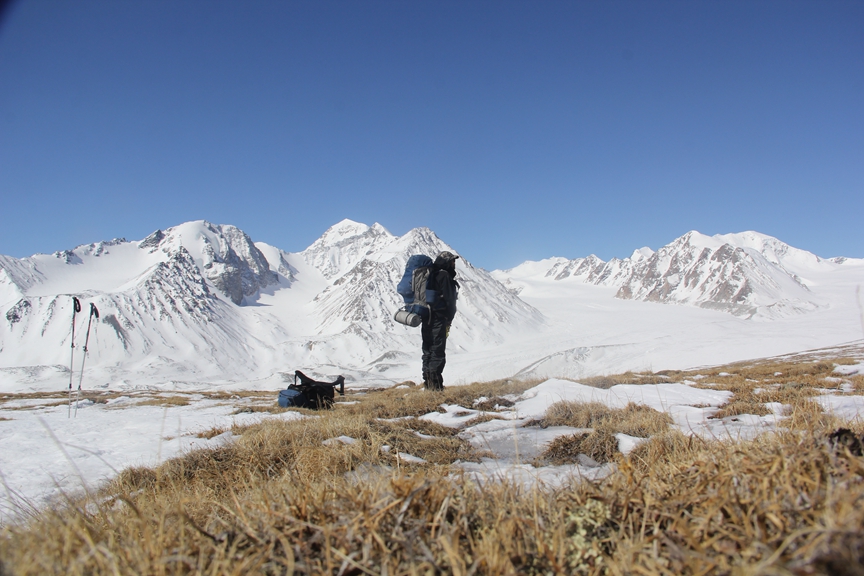 Saying one last goodbye to Khuiten (far right). We promised ourselves we would return and try for the summit again at a safer time of year.
Saying one last goodbye to Khuiten (far right). We promised ourselves we would return and try for the summit again at a safer time of year.
 Holding up the flag for an outdoor store in Beijing where we buy a lot of gear and are friends with the owner.
Holding up the flag for an outdoor store in Beijing where we buy a lot of gear and are friends with the owner.
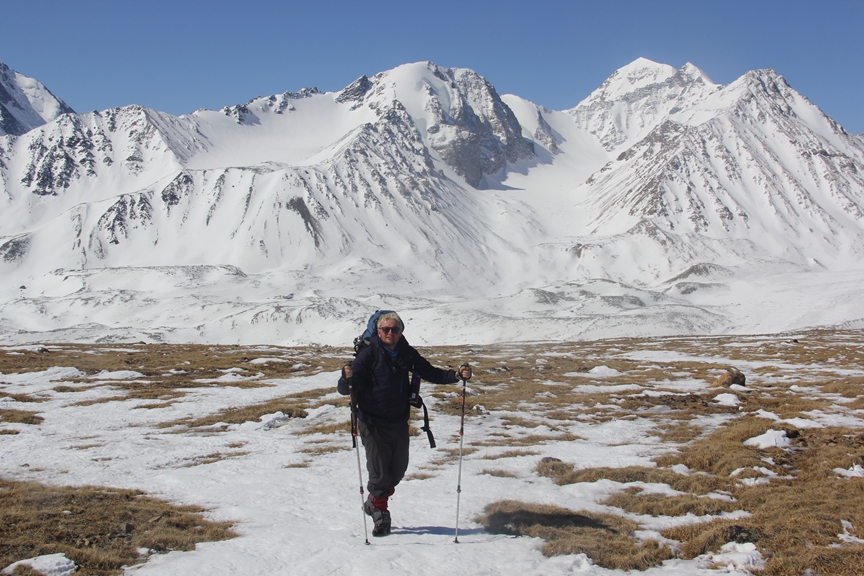 Dion really loves his Czech made walking sticks!
Dion really loves his Czech made walking sticks!
 I spotted this fox on our way out of the park.
I spotted this fox on our way out of the park.
To see more photos from the park, please click here.
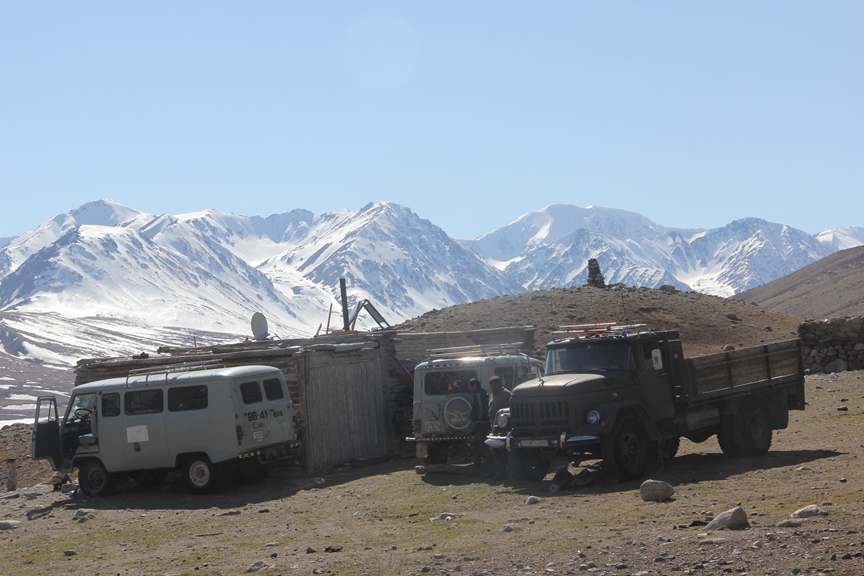 This is the wooden cabin where our driver dropped us off 4 days prior. We came back to pick up the things I had left there before entering the park. It took me just over 5 hours to reach it from basecamp, which is less than half the time it took us to hike from there to basecamp.
This is the wooden cabin where our driver dropped us off 4 days prior. We came back to pick up the things I had left there before entering the park. It took me just over 5 hours to reach it from basecamp, which is less than half the time it took us to hike from there to basecamp.
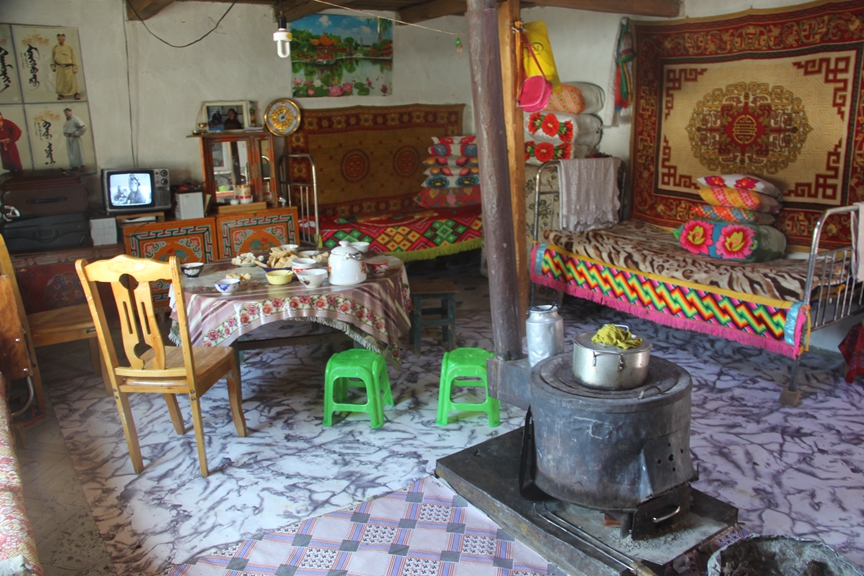 The cabin isn’t connected to the electric power grid, which is over 100 km away, so the small black and white TV in the top left of the photo was powered by a car battery. There was also a small solar panel outside for powering the energy-saving bulb hanging from the ceiling.
The cabin isn’t connected to the electric power grid, which is over 100 km away, so the small black and white TV in the top left of the photo was powered by a car battery. There was also a small solar panel outside for powering the energy-saving bulb hanging from the ceiling.
The residents of the cabin are “poor” by modern standards because they lack a reliable source of electricity, indoor plumbing, modern home appliances or communication equipment like mobile phones and computers, but by the standards of their traditional lifestyle, in which wealth is measured in livestock, not money, they seemed to be doing quite well. They had a large herd of goats and sheep as well as several yaks and horses. They also had several old Soviet era Russian vehicles and a Chinese motorcycle, so obviously weren’t poor by Mongolian standards. However, the extreme remoteness of where they live would likely cause some hardship, logistics being primary among them. For instance, the nearest town, which is itself very remote, is 110 km away and the “road” leading to it is very rough. Nothing more than a jeep track, the “road” can only be traversed by 4 wheel drive off-road automobiles or motorcycles at a maximum speed of 20-30 kilometres per hour. Access to adequate healthcare is also another significant challenge.
Like most people in this part of the world, the residents of the cabin were very hospitable. As soon as I arrived, they welcomed me inside their humble but colourfully decorated, single room cabin and offered me milk tea and an assortment of homemade cheeses and biscuits. In turn, I gave their children several Snickers bars that I had in my bag. I also gave them most of my left over food, including at least a kilo of millet and noodles, and a wool sweater that a Canadian friend in Beijing had asked me to give to someone the next time I went traveling in a poor, remote area. The diet of most rural Mongolians consists mainly of milk, cheese, meat and fat from their own herds of goat, sheep, yaks and camels. They also consume limited amounts of grain but hardly any vegetables. It’s actually quite astonishing that they can consume so much meat and so few vegetables but still remain healthy. Apparently, this is because they also consume large quantities of fermented dairy products, like cultured milk, curd and various cheeses, which are loaded with healthy bacteria or “probiotics”.
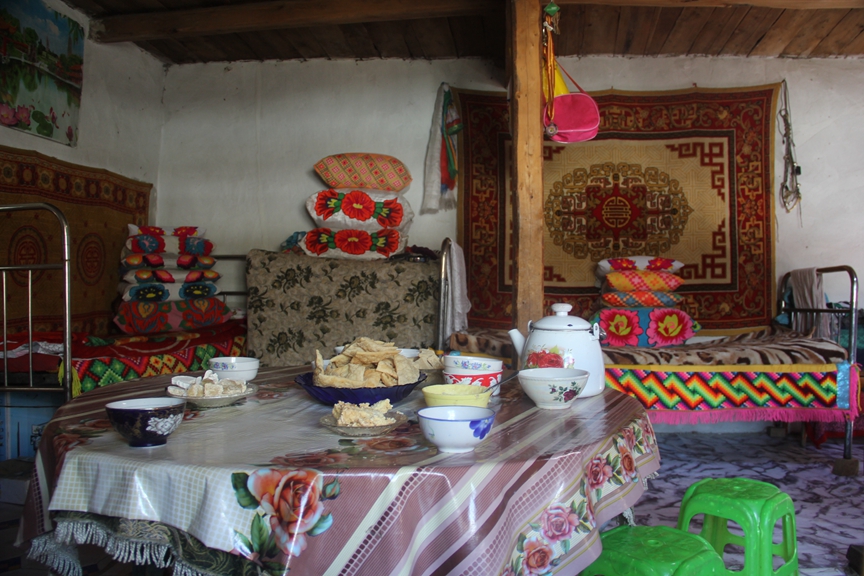 This table was full of an assortment of homemade cheeses and curd, chewy deep-fried dough and bowls of salty milk tea.
This table was full of an assortment of homemade cheeses and curd, chewy deep-fried dough and bowls of salty milk tea.
 The view out the cabin window.
The view out the cabin window.
 Interestingly, this girl had naturally golden blond hair, which is quite unusual for someone with otherwise typical “East Asian” facial features.
Interestingly, this girl had naturally golden blond hair, which is quite unusual for someone with otherwise typical “East Asian” facial features.
The residents of the cabin actually weren’t ethnically Mongol or Kazakh but Tuvan, a small Turkic-speaking ethnic group concentrated in southern Siberia, which borders this remote and isolated corner of Mongolia. There are only about 5,000 Tuvans in Mongolia and close to 4,000 just across the border in China’s Xinjiang province, but the vast majority of Tuvans, about 270,000, live in the Tuva Republic, a nominally autonomous “federal subject” of Russia, which was established as a “homeland” for the Tuvan people, who make up the vast majority of their self-styled “republic”.
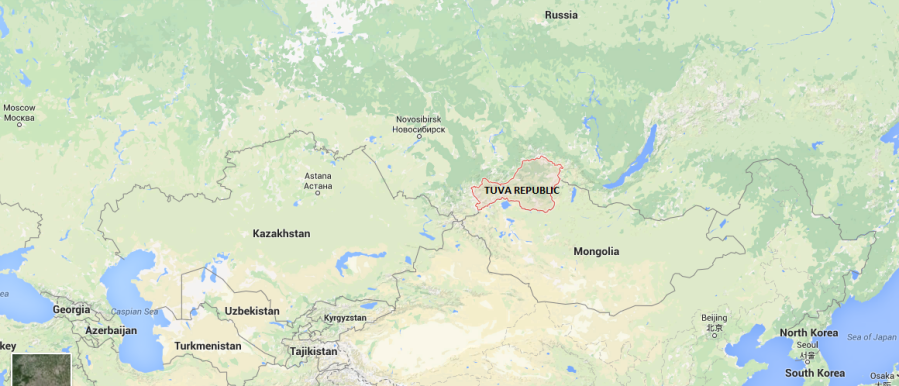 The “Tuva Republic” is outlined in red on this map.
The “Tuva Republic” is outlined in red on this map.
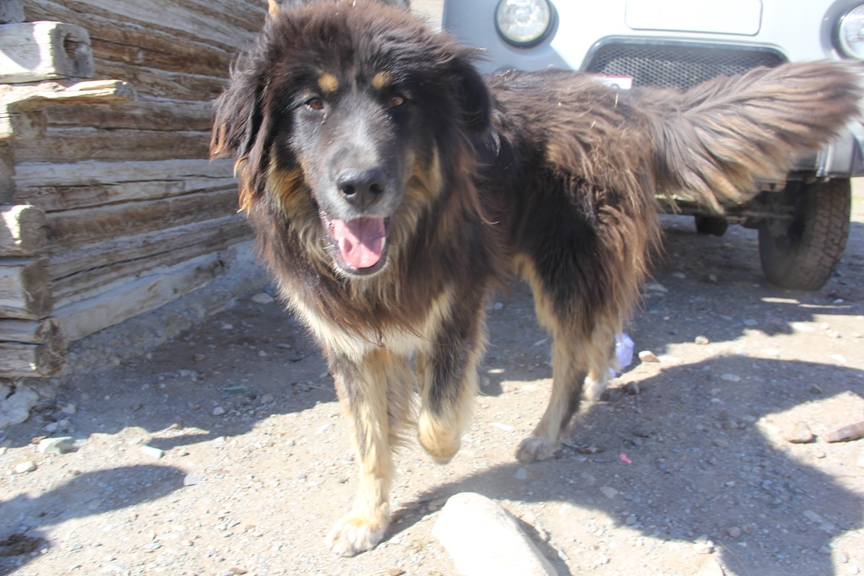 A very large, but thankfully friendly, sheepdog.
A very large, but thankfully friendly, sheepdog.
We knew that once we made it out of the park, we would probably have to hire a local driver to drive us along the very rough road to the nearest village, Tsengel, which is 110 km away. There is no public transport running between the park and Tsengel and we knew it would be nearly impossible to hitchhike since there was so little traffic on the road, so we decided to ask the residents of the cabin if they would be willing drive us to Tsengel for a fee. Since we had paid $180 USD for a jeep to drive us 180 km from Olgii to the park, we estimated it would cost about $100 USD for a drive to Tsengel, which is precisely how much they charged us. Although we weren’t very enthusiastic to pay so much, we were in a very poor bargaining position. Our only alternative would have been to walk the 110 kilometres to Tsengel, but that would have taken us at least 4-5 days and wouldn’t have been very enjoyable with heavy packs, particularly for me, since the blisters on my heels were still quite painful.
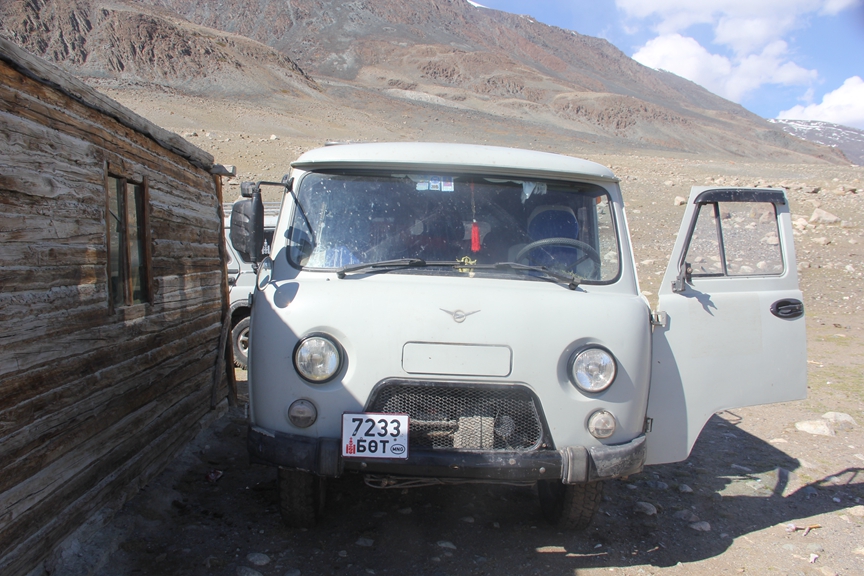 We took this Soviet era Russian made UAZ – 452, “off-road van” to Tsengel.
We took this Soviet era Russian made UAZ – 452, “off-road van” to Tsengel.
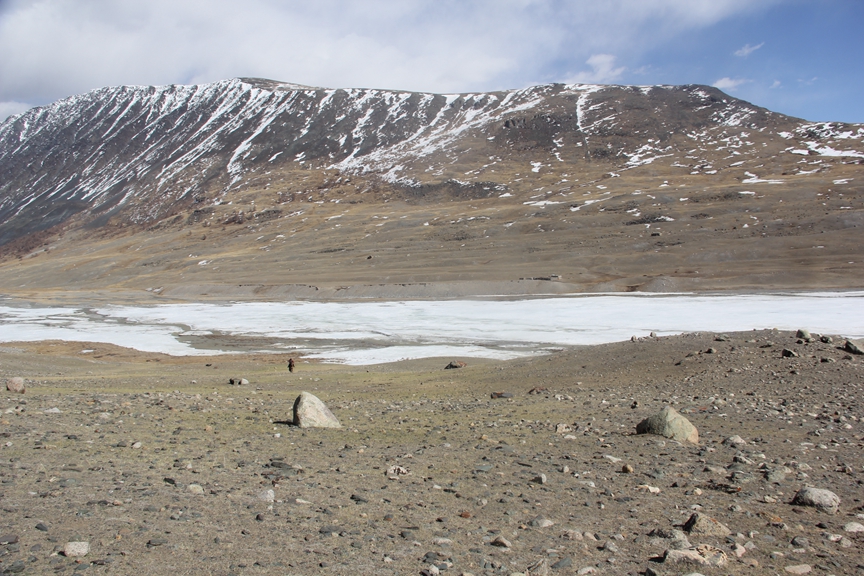 Just below the snow-covered river is a man on a horse riding towards us on the left side of the photo.
Just below the snow-covered river is a man on a horse riding towards us on the left side of the photo.
He had just appeared out of a cabin several kilometers away on the other side of the river because our driver had stopped and honked his horn to get his attention. There is no mobile phone reception in the area, so the driver had to honk for several minutes until he saw the man get on his horse and start riding toward us. As soon as he arrived about 10 minutes later, he dismounted and slapped his horse on the ass, which sent it trotting back to the cabin. Apparently a friend or relative of the driver, he then got in the van and rode to Tsengel with us.
Once in Tsengel, the man we had picked up on the way, who actually turned out to speak a bit of English, offered us to stay at his sister’s place in town for $5 USD each, including dinner, which we gladly accepted. When we arrived at the house though, it was locked and no one was home, so he made a call and 5 minutes later 3 young boys arrived and unlocked the front door. As soon as we were inside, the boys quickly went about starting a fire and preparing tea and snacks, before eventually dicing up a large piece of mutton into bit size morsels and preparing a delicious stew with potatoes and noodles, which they put the mutton into as well. Both Dion and I were extremely impressed by how hardworking and capable the boys were at doing housework and preparing a meal, even the youngest who was only 8 years old. I dare say there are very few children in the West today who could or would do the same.
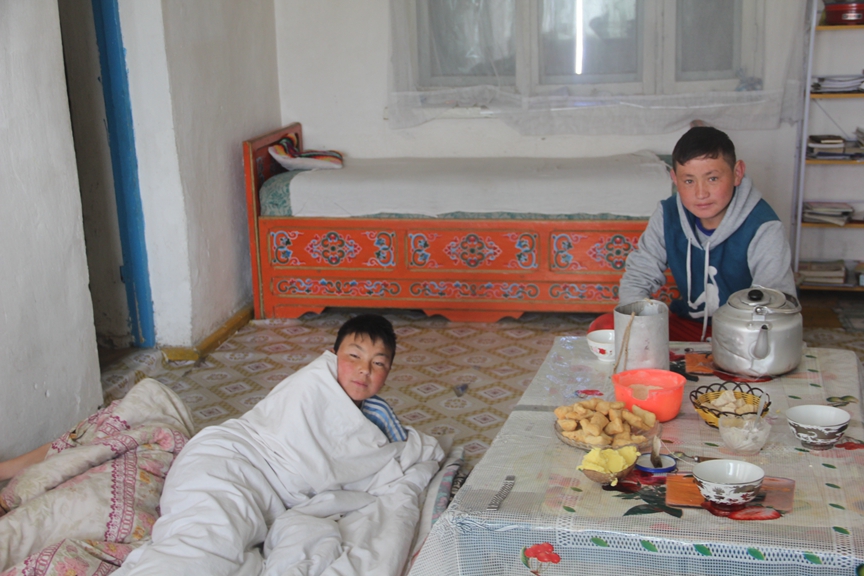 Two of the three boys at 6am the next morning, with the third and youngest still asleep under his blanket on the left. We slept on their beds the night before, so they had to sleep on the floor.
Two of the three boys at 6am the next morning, with the third and youngest still asleep under his blanket on the left. We slept on their beds the night before, so they had to sleep on the floor.
Shortly after arriving in Tsengel the evening before, the man who let us stay at his sister’s house helped us to arrange a ride from Tsengel to Olgii, the capital of Bayan Olgii province, which is 70km away. Thankfully, we were able to get seats in a shared van that left the next morning at 6am for $5 USD each. When we arrived in Olgii the next morning about 3 hours later, we went straight to the bazaar to look for a shared van going to Khovd, the capital of Khovd province, 218 km away. We found one very quickly but the driver said he wasn’t leaving until 2-3pm, so we put our bags inside and left to get some food nearby. It’s standard protocol in Mongolia and other Central Asian republics for passengers to leave their bags in the vehicle in the trust of a complete stranger, in belief that the driver won’t disappear with them because he wants to earn the passenger’s fare, which of course, isn’t paid until departure. Although the contents of our bags were worth much more than the fare in this case, we trusted the driver wasn’t going to disappear on us because other passengers had also left their bags as well. Sure enough, when we came back at 2, he was still there and we took our seats.
 Getting clawed by an eagle’s talon is terrifying!
Getting clawed by an eagle’s talon is terrifying!
Khovd
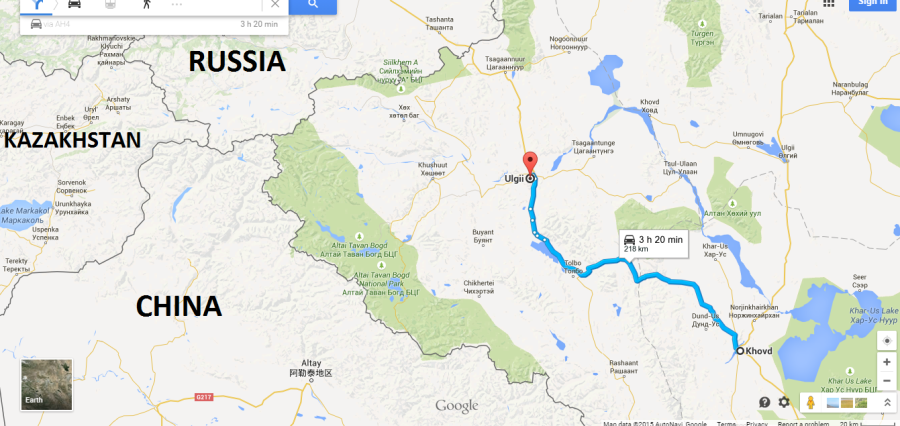 The blue line shows the route we took from Olgii to Khovd. Although Google Maps estimates the drive only takes 3 hours and 20 minutes, it actually took us more than 6 hours, as most of the journey was off-road.
The blue line shows the route we took from Olgii to Khovd. Although Google Maps estimates the drive only takes 3 hours and 20 minutes, it actually took us more than 6 hours, as most of the journey was off-road.
We arrived in Khovd at about 9pm and checked into a small hotel, where we stayed in a shared dorm for about $3 USD each. Thankfully, we were the only ones in the room, so it was like getting a large double room at a discount. We left the hotel the next morning to find a place to eat, then came back and checked out. Our plan that day was to try to find a shared van to take us to the small border town of Bulgan, from where we intended to cross the Chinese border into Xinjiang province. We walked for about 20 minutes to reach the bazaar then wandered around for another 15 minutes or so until we found a shared van going to Bulgan. As we did when arranging transport from Olgii to Khovd, we asked the driver when he was planning to depart, then put our bags in the van and walked away.
Similar in size and appearance to Olgii, Khovd is a slightly depressing and very dusty provincial capital in far western Mongolia with a population of about 30,000 and not much in the way of sites. It’s primary attraction for tourists is as a transport hub and/or springboard for visiting the surrounding countryside and several national parks in Khovd province. Since we had several hours to kill before our van departed, we decided to take a stroll through the bazaar.
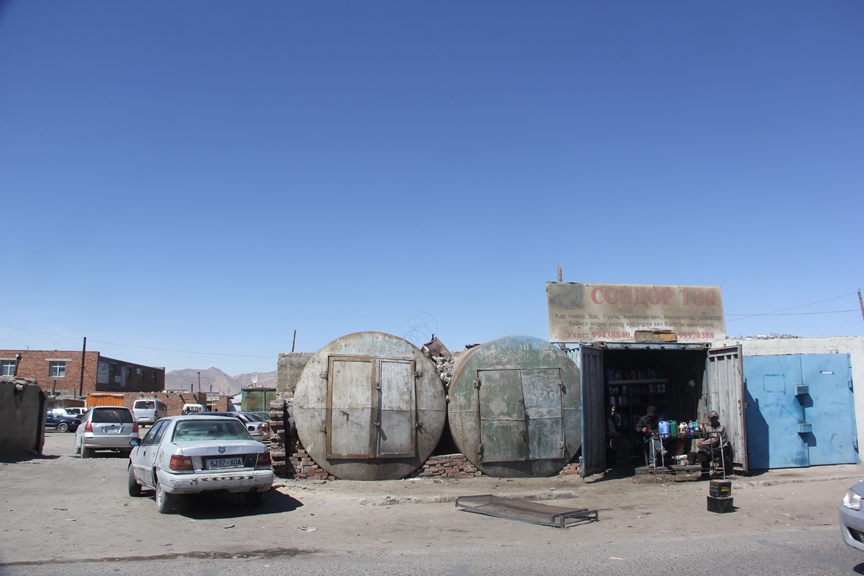 A rather uninviting entrance to the bazaar.
A rather uninviting entrance to the bazaar.
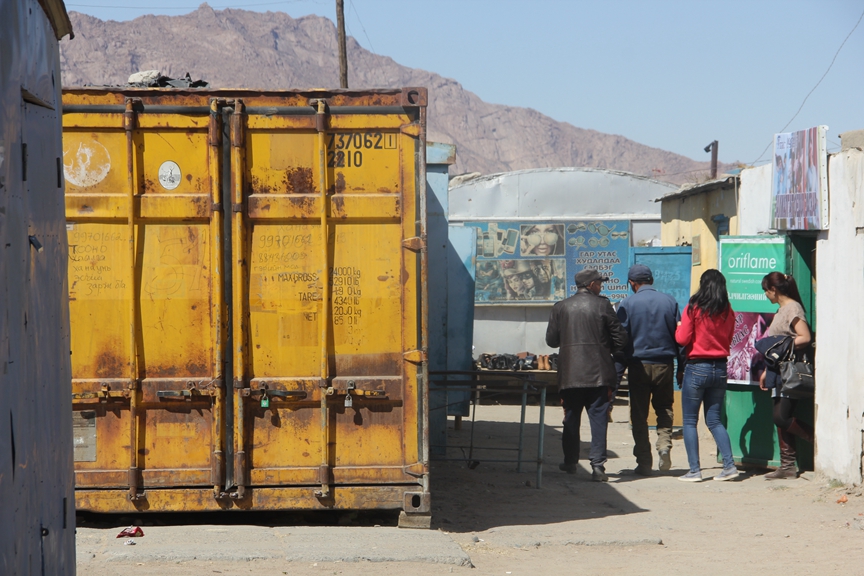 As is the case throughout Central Asia, many shops are housed in shipping containers like this one.
As is the case throughout Central Asia, many shops are housed in shipping containers like this one.
 A ger in the middle of the bazaar.
A ger in the middle of the bazaar.
The bazaar in Khovd was actually quite a bit larger than the one in Olgii but because we were there on a Monday, it wasn’t very busy. The most notable feature of the bazaar were the used clothing and shoe stores, which sold vintage Western clothing and shoes from the 70’s and 80’s. I actually bought a really nice, lightweight German-made backpack for about $3 USD. There were a lot of really nice vintage hiking boots too. Vintage clothing fashionistas would have a field day in the Khovd bazaar. Dion and I were both scratching our heads for a while trying to figure out how so much old Western footwear and clothing ended up at a bazaar in a remote corner of Mongolia when Dion finally suggested that they were donated by Western charities and aid agencies but then surreptitiously sold to traders after arriving in Mongolia, instead of being given away as intended. Sounds like a plausible hypothesis.
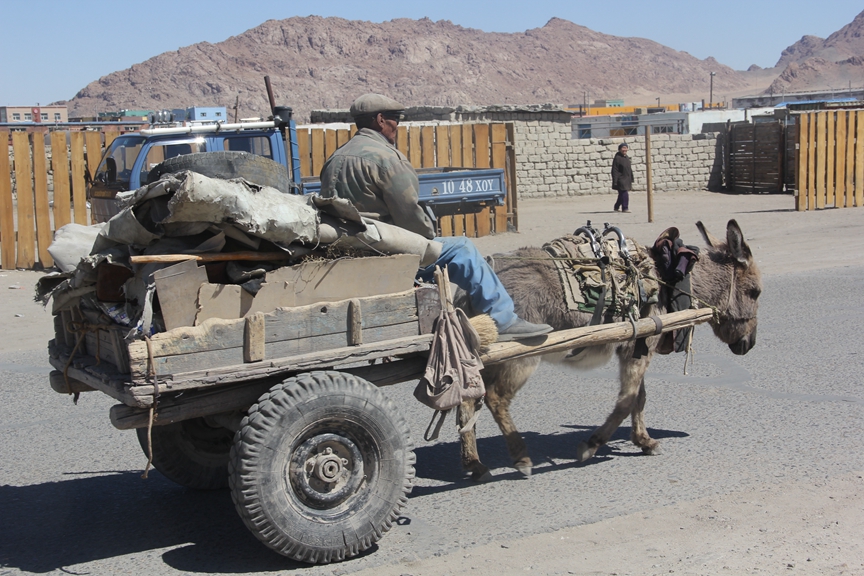 A donkey cart in downtown Khovd. Donkey carts are still a fairly common form of transport in remote parts of Mongolia.
A donkey cart in downtown Khovd. Donkey carts are still a fairly common form of transport in remote parts of Mongolia.
We returned to our shared van at about 3 pm but the driver was doing repairs on it when we arrived, so we didn’t end up leaving until 5 pm. The drive from Khovd to Bulgan was long and extremely uncomfortable. The van was overloaded with cargo and there were more passengers than seats, which meant I had to share a seat with a young Mongolian man. My butt was wedged between his and the side of the van the entire ride, which eventually made my right leg go numb for several hours. Not only that but the driver drove like a bat out of hell over rough jeep tracks for most of the journey, so I couldn’t sleep. The journey actually didn’t start out all that bad since the road leading out of Khovd was newly paved, to my great surprise. Unfortunately, the pavement disappeared after about an hour and we went off-road for the rest of the 8 hour journey.
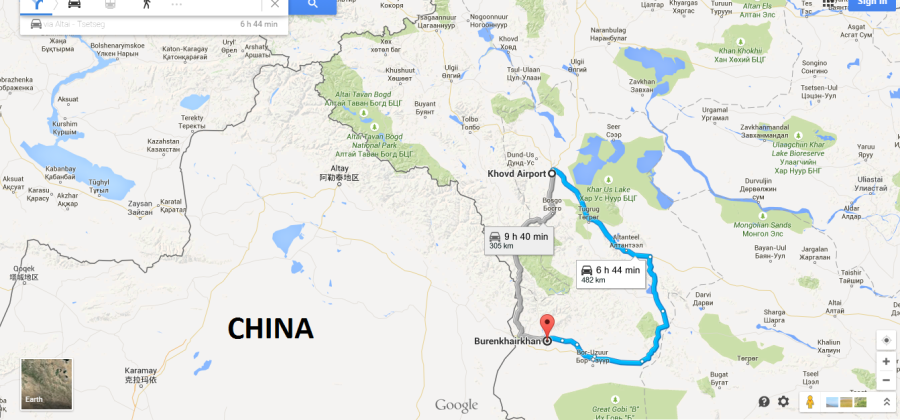 The blue line shows our route from Khovd to Bulgan, which actually took more than 8 hours, not the 6 hours and 44 minutes estimated by Google Maps. It would have taken a lot longer if our driver didn’t drive like a complete maniac. In fact, Lonely Planet says the route usually takes 10-12 hours, so 8 hours was fast!
The blue line shows our route from Khovd to Bulgan, which actually took more than 8 hours, not the 6 hours and 44 minutes estimated by Google Maps. It would have taken a lot longer if our driver didn’t drive like a complete maniac. In fact, Lonely Planet says the route usually takes 10-12 hours, so 8 hours was fast!
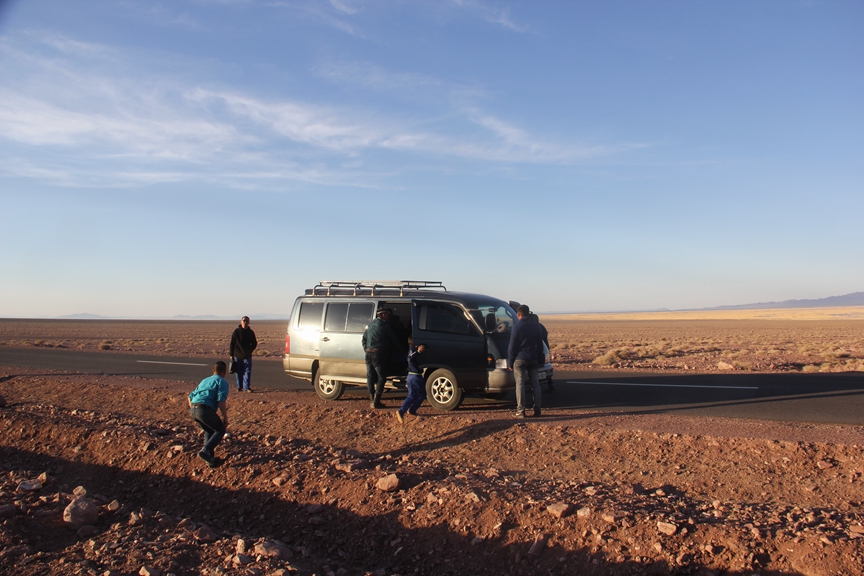 A brief pit stop on the paved section of the road.
A brief pit stop on the paved section of the road.
We arrived in Bulgan at 3am and tried to stay at the above hotel but it was full, so our driver found us another hotel nearby, where we paid 100 Chinese Yuan (about $15 USD) for a double room because we were out of Mongolian currency. We only slept there until 6:30 am though because we had planned to meet our driver at 7am to take us to the official border crossing 30 km away, which we had already paid him for the day before. Frustratingly, he didn’t show up until 8am and then drove us to a parking lot nearby and parked the van. When we asked what he was doing, he told us that he wasn’t going to the border until 2pm, which was way too late for us. We wanted to be at the border crossing before it opened at 9am, so that we would have time to cross and find onward transport from the Chinese side of the border to Urumqi, the capital of Xinjiang province, the same day. We told him that we needed to leave right away, so he found us another car that was leaving and gave our fare to the driver. As soon as we got in the car though, 2 surly looking young men got in after us and started staring at us malevolent and asking us questions in Mongolian, which we couldn’t understand. One of them even snatched Dion’s iphone out of his hand and started swiping through his photos, which made us a little nervous. We hadn’t had many unfriendly experiences during the previous 2 weeks in Mongolia, so I joked dryly that it would be ironic if we were robbed just as we were about to leave the country. Thankfully, our fears were exaggerated and we arrived at the Takeshiken border crossing a short while later.
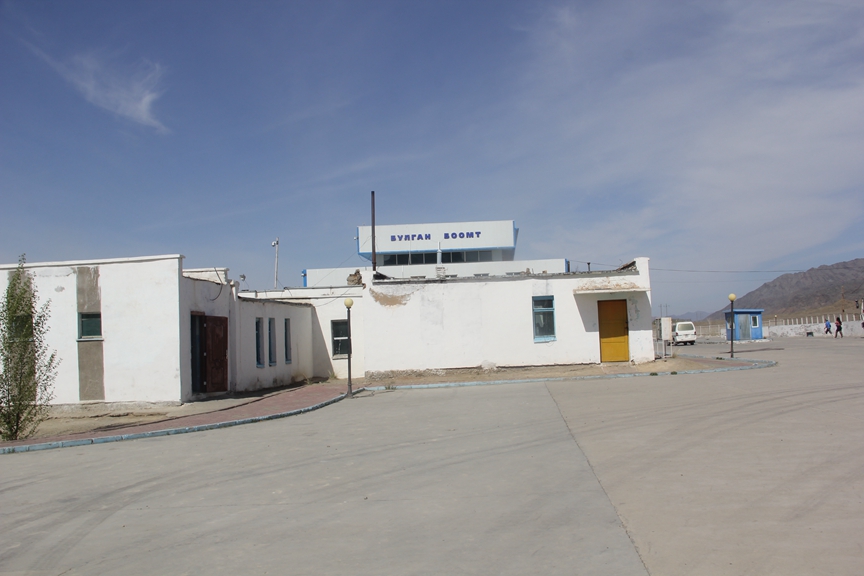 Mongolian Customs and Immigration building at the Takeshiken border crossing with China’s Xinjiang province.
Mongolian Customs and Immigration building at the Takeshiken border crossing with China’s Xinjiang province.
There were only a few people in line on the Mongolian side of the border but we didn’t even have to line up, so it took less than 10 minutes from the time we arrived at the border until we cleared Mongolian customs and were stamped out of the country. After we left Mongolian soil, we had to walk across no-man’s land for about 5 minutes to the Chinese side of the border. I love traveling across borders by land, especially on foot!
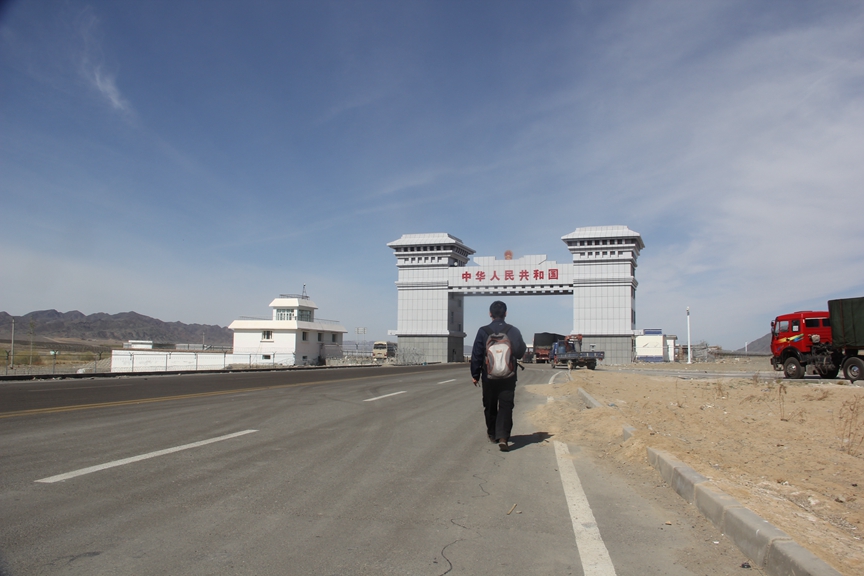 Most of the Chinese border crossings I’ve been to have this kind of large, imposing archway, designed to awe those who pass through it with the might of the Chinese state.
Most of the Chinese border crossings I’ve been to have this kind of large, imposing archway, designed to awe those who pass through it with the might of the Chinese state.
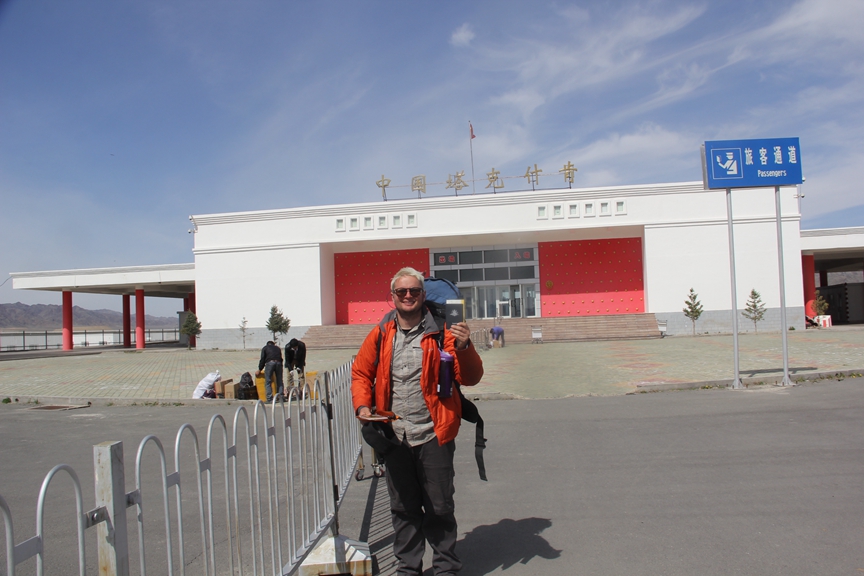 Dion holding up his Australian passport in front of the Chinese Customs and Immigration building. He had just used his Finnish passport to exit Mongolia and was about to use his Australian to enter China because the latter had a Chinese visa.
Dion holding up his Australian passport in front of the Chinese Customs and Immigration building. He had just used his Finnish passport to exit Mongolia and was about to use his Australian to enter China because the latter had a Chinese visa.
 This photo shows my boots strapped to my bag. My heels were so badly blistered that I had to switch to slip on sandals as soon as I hiked out of Altai Tavan Bogd National Park 4 days prior, which I wore all the way back to Beijing.
This photo shows my boots strapped to my bag. My heels were so badly blistered that I had to switch to slip on sandals as soon as I hiked out of Altai Tavan Bogd National Park 4 days prior, which I wore all the way back to Beijing.
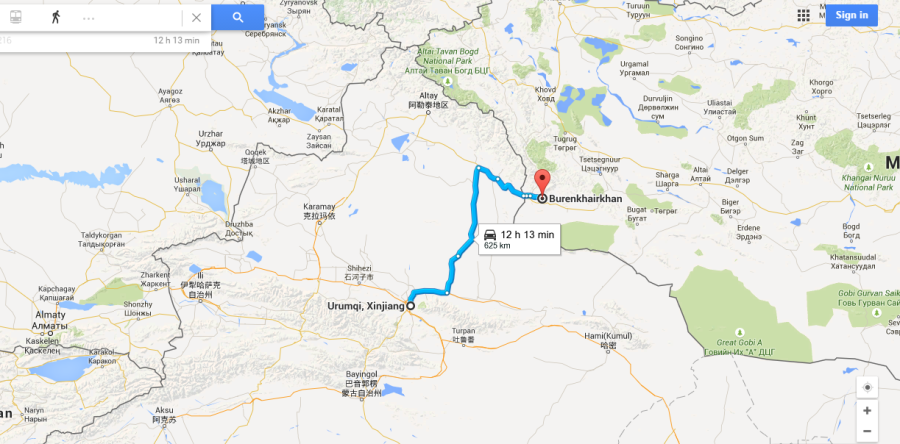 This is the route we took from Bulgan across the Chinese border and down to Urumqi, capital of China’s Xinjiang province, 625 km away.
This is the route we took from Bulgan across the Chinese border and down to Urumqi, capital of China’s Xinjiang province, 625 km away.
Clearing Chinese Customs wasn’t a problem and we quickly found transport to Urumqi. The drive took much longer than expected though, so we didn’t arrive in the city until 9pm. Dion had to be back in Beijing the next day, so flew out of Urumqi the next morning but I wasn’t in a rush, so I opted for the train instead, which took 33 hours.
 This is the 3,179 kilometre train route from Urumqi to Beijing. It was a long journey but I had a hard sleeper bunk on a clean, modern train, so I was able to relax and stretch out comfortably. I spent most of the time listening to music, reading and staring out the window at the passing scenery, which was quite enjoyable.
This is the 3,179 kilometre train route from Urumqi to Beijing. It was a long journey but I had a hard sleeper bunk on a clean, modern train, so I was able to relax and stretch out comfortably. I spent most of the time listening to music, reading and staring out the window at the passing scenery, which was quite enjoyable.
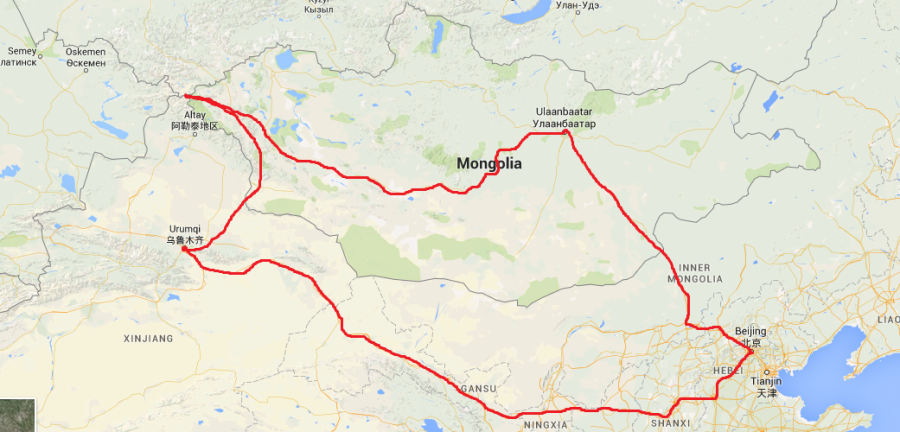 This is the rough overland “loop” I did (since Dion flew from Urumqi to Beijing, he technically didn’t complete the loop). The entire loop took 16 days to complete, 13 of which were spent in Mongolia. The total distance traveled was approximately 8,061 kilometres, of which approximately 3,590 kilometres were traveled in Mongolia via a combination of train, bus, jeep, van, car and foot. Ironically, most of the distance traveled was in China, although a large chunk of that distance was on the train from Urumqi to Beijing.
This is the rough overland “loop” I did (since Dion flew from Urumqi to Beijing, he technically didn’t complete the loop). The entire loop took 16 days to complete, 13 of which were spent in Mongolia. The total distance traveled was approximately 8,061 kilometres, of which approximately 3,590 kilometres were traveled in Mongolia via a combination of train, bus, jeep, van, car and foot. Ironically, most of the distance traveled was in China, although a large chunk of that distance was on the train from Urumqi to Beijing.
Reflections on Traveling in Mongolia
The first thing that comes to mind when reflecting on travel in Mongolia are the roads, or more specifically, the lack of roads. Perhaps it’s because I’ve lived in China for so many years, which has some of the newest and smoothest paved roads anywhere in the world, but I was really shocked by how poor the road infrastructure was in Mongolia. It’s not that the paved roads and highways were all cracked and full of potholes, it’s that there was barely any pavement in the country to begin with! Of course, the capital, Ulaan Baatar, had plenty of pavement, which was heavily cracked and potholed incidentally, but I personally saw little in the way of a paved highways and roads outside of UB. Of the 50,000 kilometres of roadways that the government claims Mongolia has, apparently only 5,000 are paved. However, after having traveled across more than 3,500 kilometres of Mongolia by land in a fortnight, I am highly dubious about how the government defines the word “roadway”. During the 56 hour, 1,700 km bus journey across western Mongolia from UB to Bayan Olgii province, we traveled on a few hundred kilometres of pavement but most of it consisted of a single narrow, two-lane highway. By contrast, I’ve traveled extensively throughout Inner Mongolia province in China, which probably has many tens, if not hundreds, of thousands of kilometres of pavement. Like most of China, the roads and highways there are not just paved but generally quite wide, smooth and new.
The main issue isn’t pavement or the lack thereof though, it’s what happens once the pavement disappears. In the case of Mongolia, vehicles don’t stop, they go off-road. I’ve traveled on some pretty rough and bumpy dirt roads in China, but these were only in the very remotest parts of the country, mostly isolated mountainous regions where very few people live (in China, such places are few and far between). I’d venture to say that almost all roads in China are paved, so when the pavement stops, so does the driving, usually. Apart from a growing number of off-road motoring enthusiasts, off-road driving is extremely rare in China, especially when done out of necessity. In Mongolia, it’s the opposite: pavement is the exception, not the norm; pavement is in fact a luxury, while in China, off-road driving is primarily a leisure activity for wealthy people in luxury SUVs.
It was really this contrast in infrastructure development between these two neighboring countries that struck me the most about traveling in Mongolia. Even in the remotest parts of China, regions like Qinghai and Xinjiang provinces for example, road infrastructure is generally quite new and very good. This also extends to rail. While China is expanding its rail network at a dizzying pace, which now includes the largest high-speed rail network in the world, Mongolia has but one lonely railway line, the Trans-Siberian Railway, which was built by the Russians in the 1940’s and 50’s. To put the comparison in quantitative terms, China has roughly 112,000 km of railway track, while Mongolia has a mere 1,800 km. And while China, of course, is much larger in land area, it has 86 square kilometres of area per km of track, while Mongolia has 865, which means Mongolia has 10 times more land area per square km of track than China. On the flip side, China has more than 12,000 people per kilometre of track, while Mongolia only has 1560, so in relative terms, Mongolia’s railway network covers a much larger proportion of its population than China. However, the Trans-Mongolian Railway is just one straight line, running north to south across the middle of the country, so most Mongolians lack easy access to it, where as in China, despite servicing a massive population, the rail network is highly accessible and penetrates the country widely.
While a detailed comparative discussion of road and rail infrastructure may seem a bit dry too some people, I find the topic interesting because I think it symbolizes major differences between heavily populated and prosperous countries like China and poor, sparsely populated ones like Mongolia. While China roars with economic prowess and zealously embraces 21st century modernity, most rural Mongolians still live a traditional nomadic way of life, in which their livestock usually outnumber them at least ten to one. When I traveled through the countryside in Mongolia, I was shocked by how devoid it was of human activity. It was frankly astounding. Not only were there few roads, there were few towns, villages or even hamlets. The entire country just seemed so empty. As a Western traveler, this was of course, a real treat. I was happy to see that nomadic pastoralism is still alive and well right on China’s doorstep. The Chinese state took aggressive measures to pacify and settle its nomadic populations a long time ago, so very little of that culture still remains, even in Inner Mongolia, which is supposed to be an “autonomous region” for China’s ethnic Mongol minority. There are still small pockets of nomadic pastoralism in remote parts of Inner Mongolia bordering Outer Mongolia, as well as on the Tibetan plateau and in remote parts of Xinjiang, but the culture of nomadic pastoralism in these places has become deeply tainted and diluted by the modernizing influences of “Socialism with Chinese Characteristics”, a euphemistic Chinese government slogan for state-directed capitalism. Not only that, when traveling through these remote parts of China, one can’t help but look with dismay at the heavy industry that blights the landscape – dirty, belching cement factories, colossal coal-fired power plants, and gaping open-pit mines. I didn’t see anything of the kind in Mongolia. Of course, that’s what rapid economic growth looks like, that’s what modernity is built on, and that’s the road to prosperity. Is that the only road though? Will Mongolia follow it in quite the same way? Do Mongolians even want to? Those are questions I can’t answer. As a former Soviet satellite state, Mongolia still clearly leans more towards Russia culturally and economically than China but I was surprised by how little apparent Chinese economic and cultural penetration there was. Cheap Chinese consumer goods are available in shops and bazaars but I had expected to see many more Chinese people and products in the country, especially cheap Chinese automobiles, which are becoming increasingly common in other small and poor Central Asian states like Tajikistan and Kyrgyzstan.
Most Mongolians are undoubtedly quite poor but I couldn’t tell if they were miserable or not. Does poverty always breed misery? Maybe not if you’re a nomad. I don’t know. Would nomadic Mongols be willing to give up their way of life to emulate China’s economic success? I don’t know that answer either but I doubt it. I think Mongolians are proud to be independent and free, even if it means being poor. But maybe that’s a romantic notion that’s been embedded in my head ever since reading Samuel Taylor Coleridge’s famous 19th century poem, “Kubla Khan”, or, “A Vision in a dream: A Fragment”. Maybe most Westerners just want Mongolia to remain poor and underdeveloped so that we can take horse riding tours through unspoiled steppe and desert, sleep in traditional gers and get drunk on fermented mare’s milk. Unfortunately, I didn’t have the opportunity to do any of these things, which is apparently something every traveler to Mongolia is supposed to experience, but I was there primarily to try to climb the country’s highest mountain, Khuiten Uul, so my entire trip revolved around try to make that happen. I definitely plan to return to Mongolia and try again to climb Khuiten, and when I do, I think I will probably make a point of staying in a ger on the steppe, drinking kumis (fermented mare’s milk) and going on a long horse trek.
That brings me to the great importance of horses in Mongolian culture and society. I had read that this was the case before visiting Mongolia and of course know a bit about the history of the mounted Mongol conquests of Eurasia led by Chinghis Khan and his sons and grandsons, but I didn’t get to experience much of Mongolia’s equestrian culture when I was there. I saw plenty of people on horseback but I look forward to experiencing that culture more thoroughly when I go back. Horses are undoubtedly the defining symbol of Mongolian culture, which is something I find really noble, because who, after all, doesn’t admire an equestrian? There is something so dignified about a person on horseback, even if they happen to be holding a long sword and are about to pillage your town, which is what the Mongols are most famous for and still most proud of…
